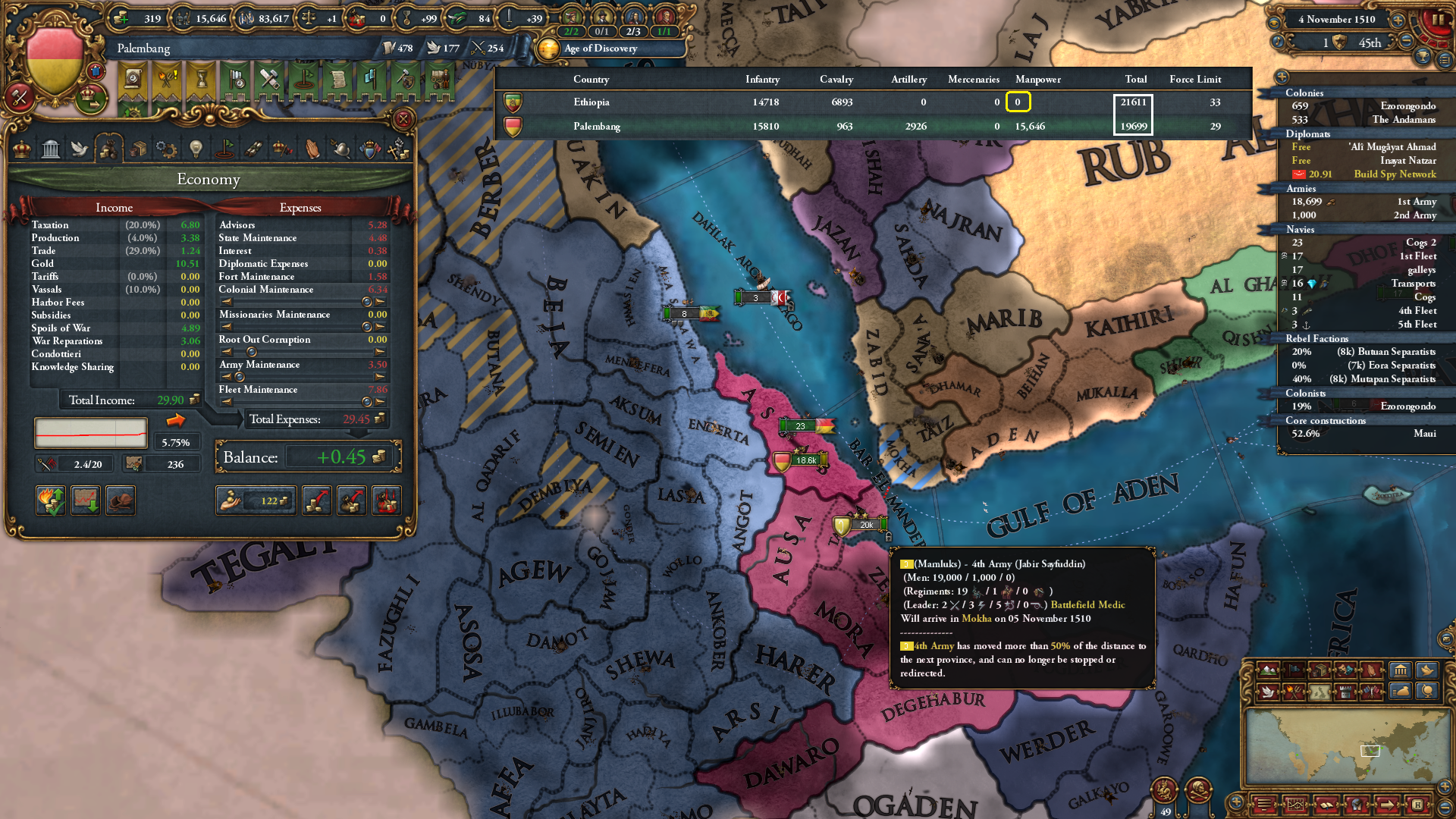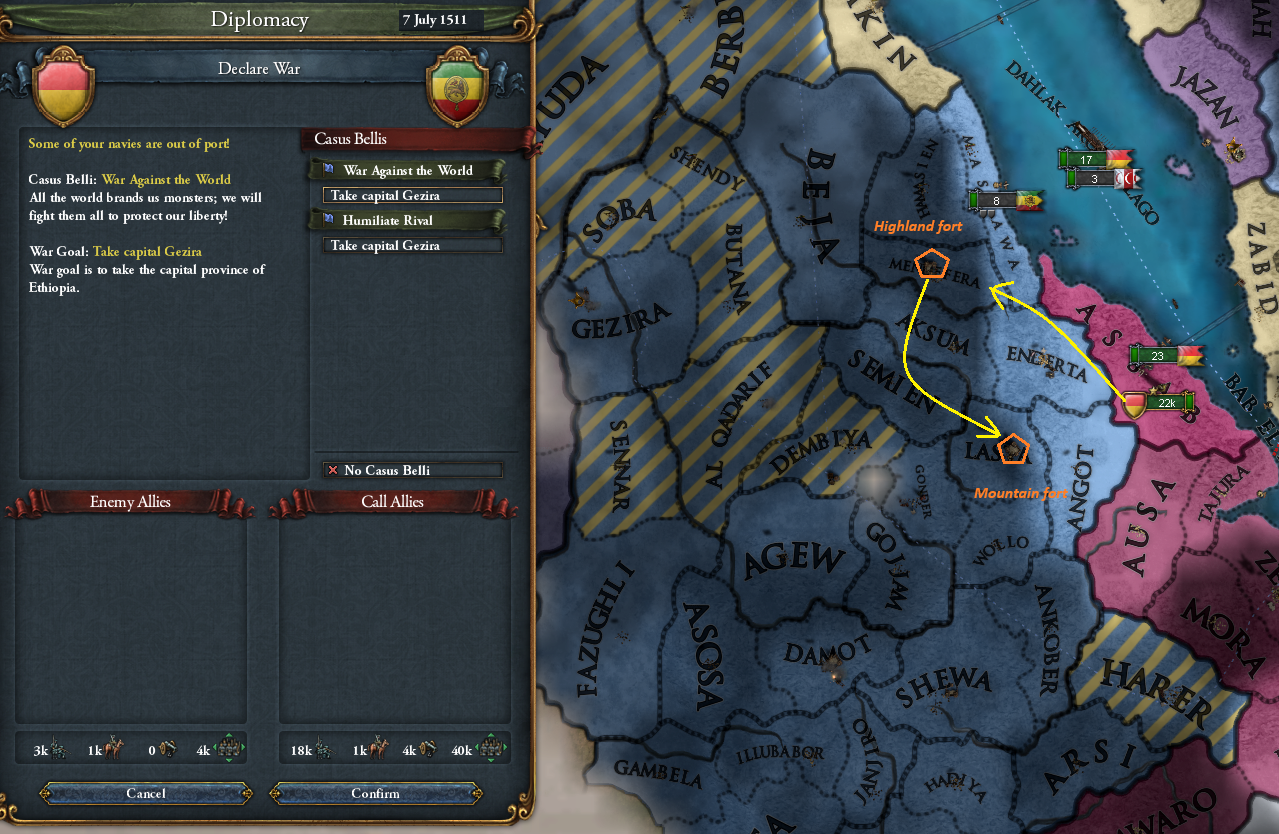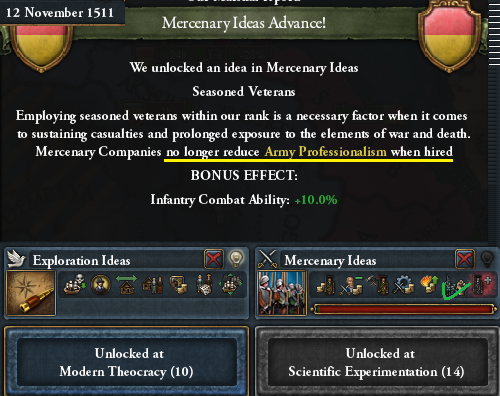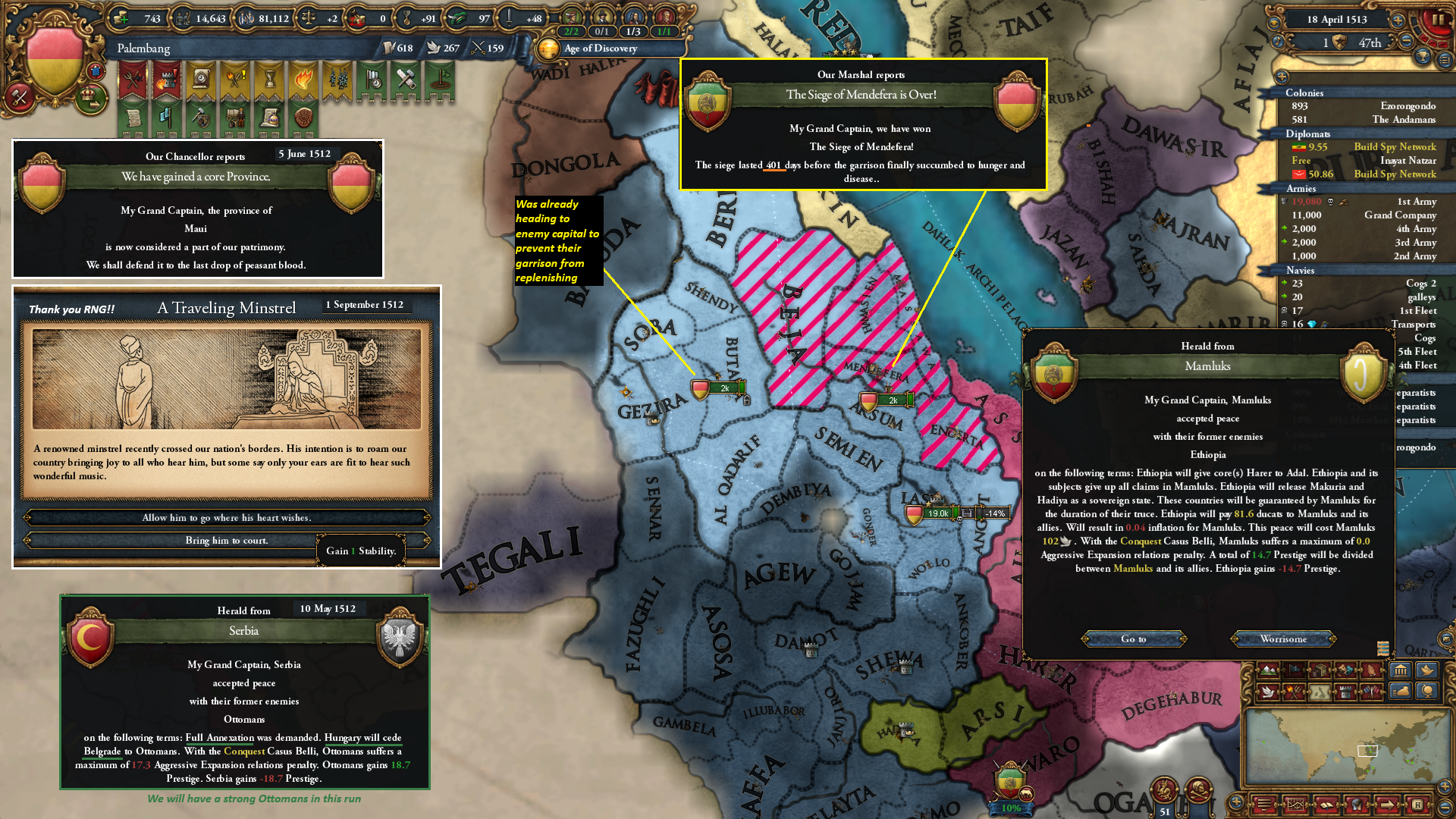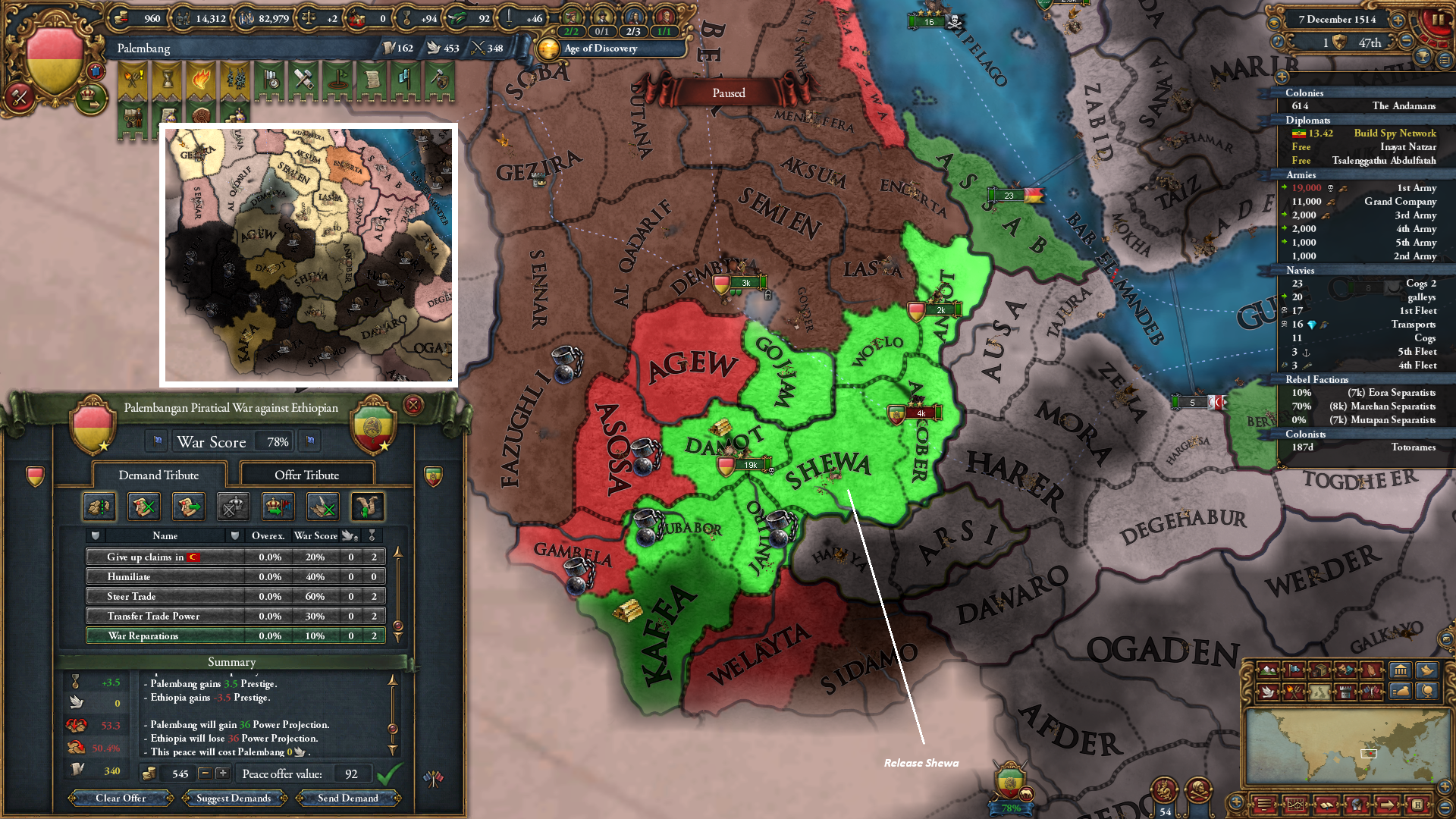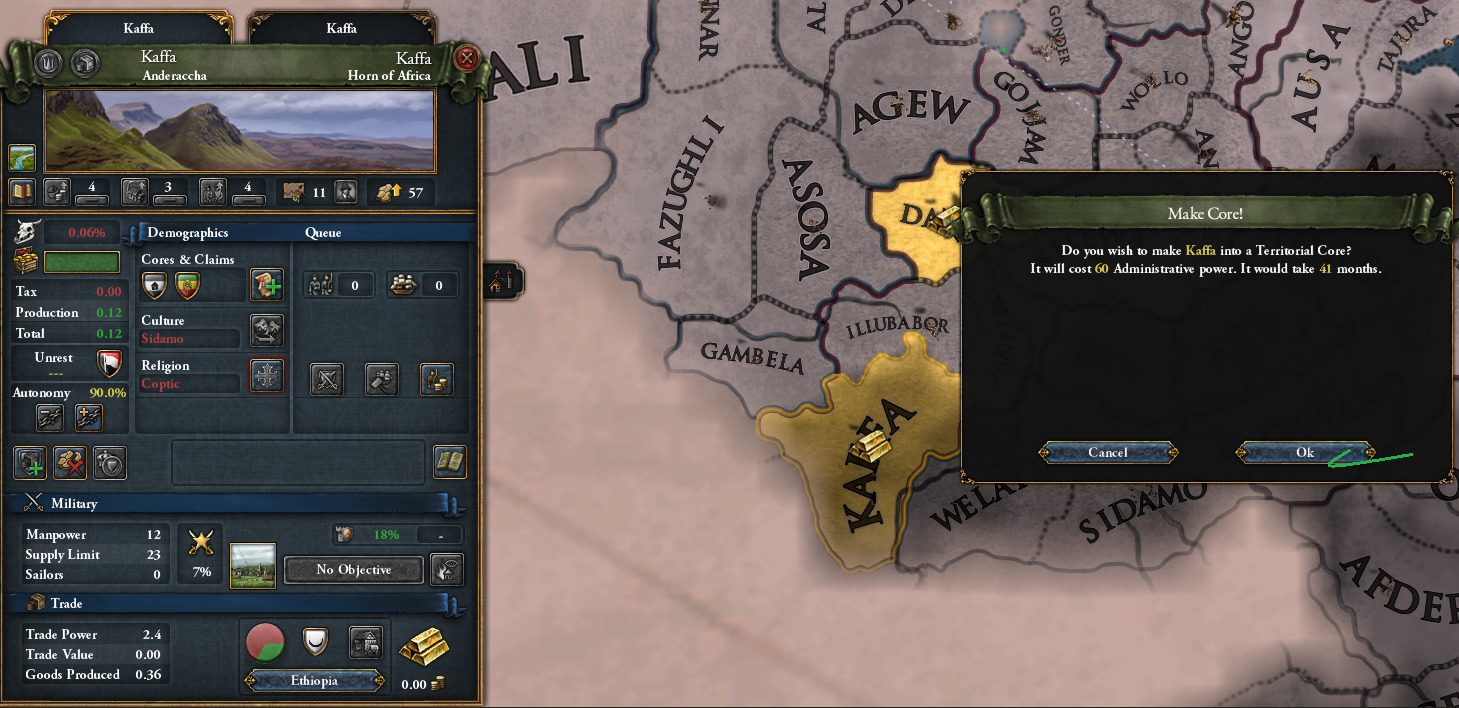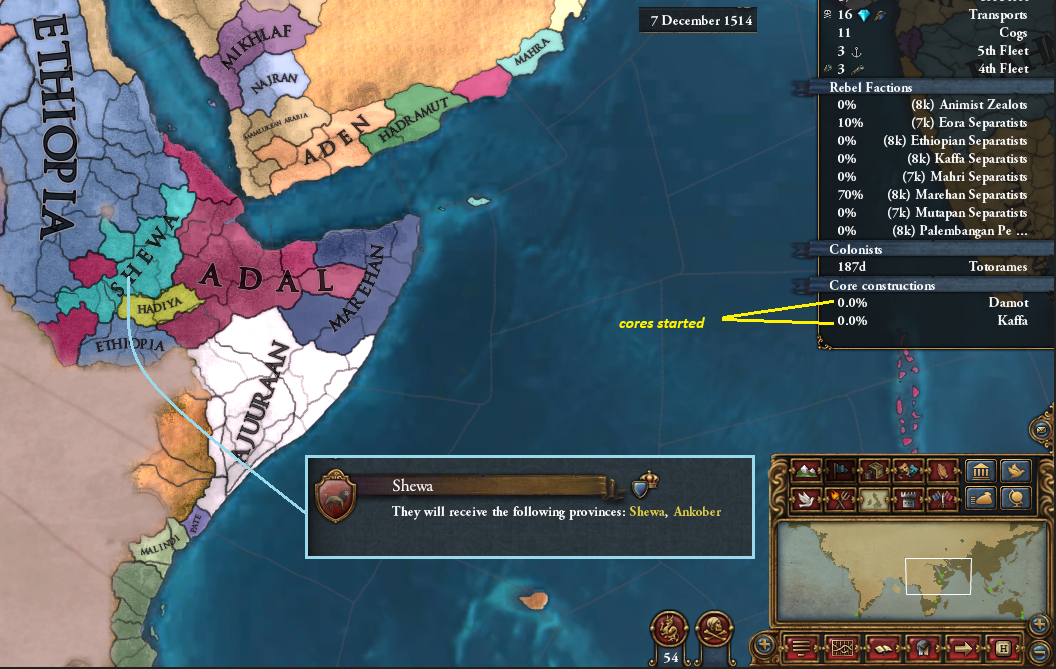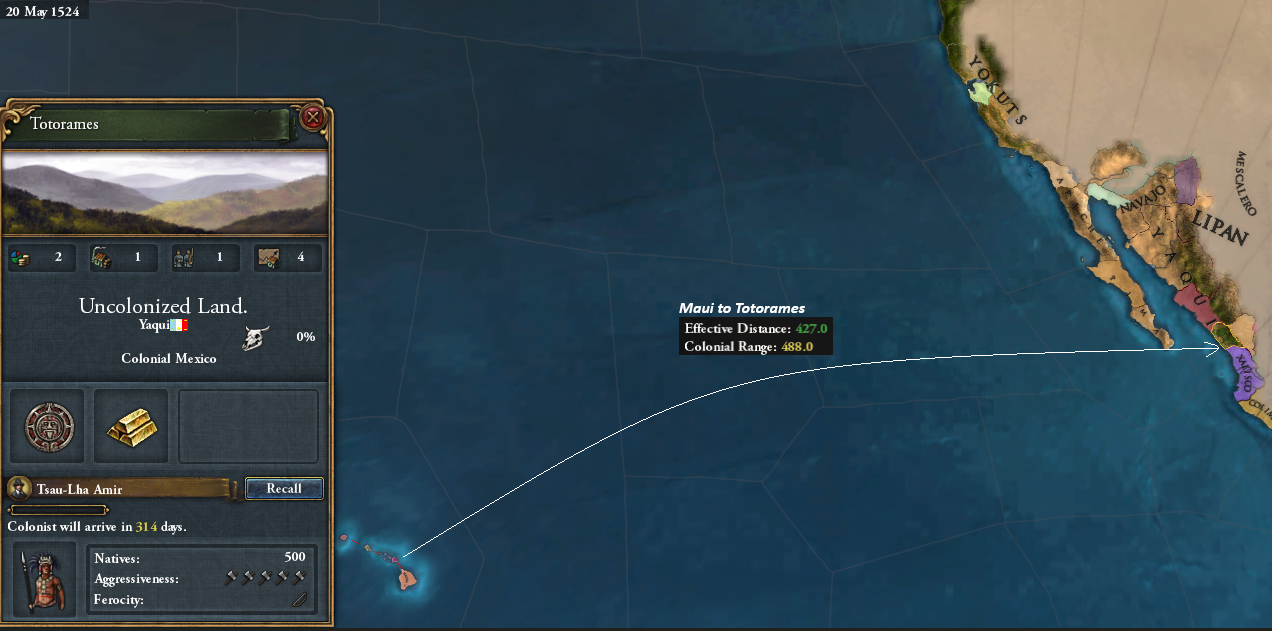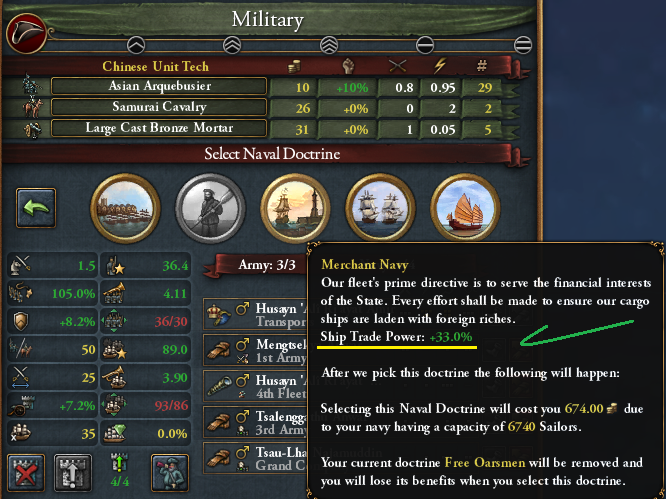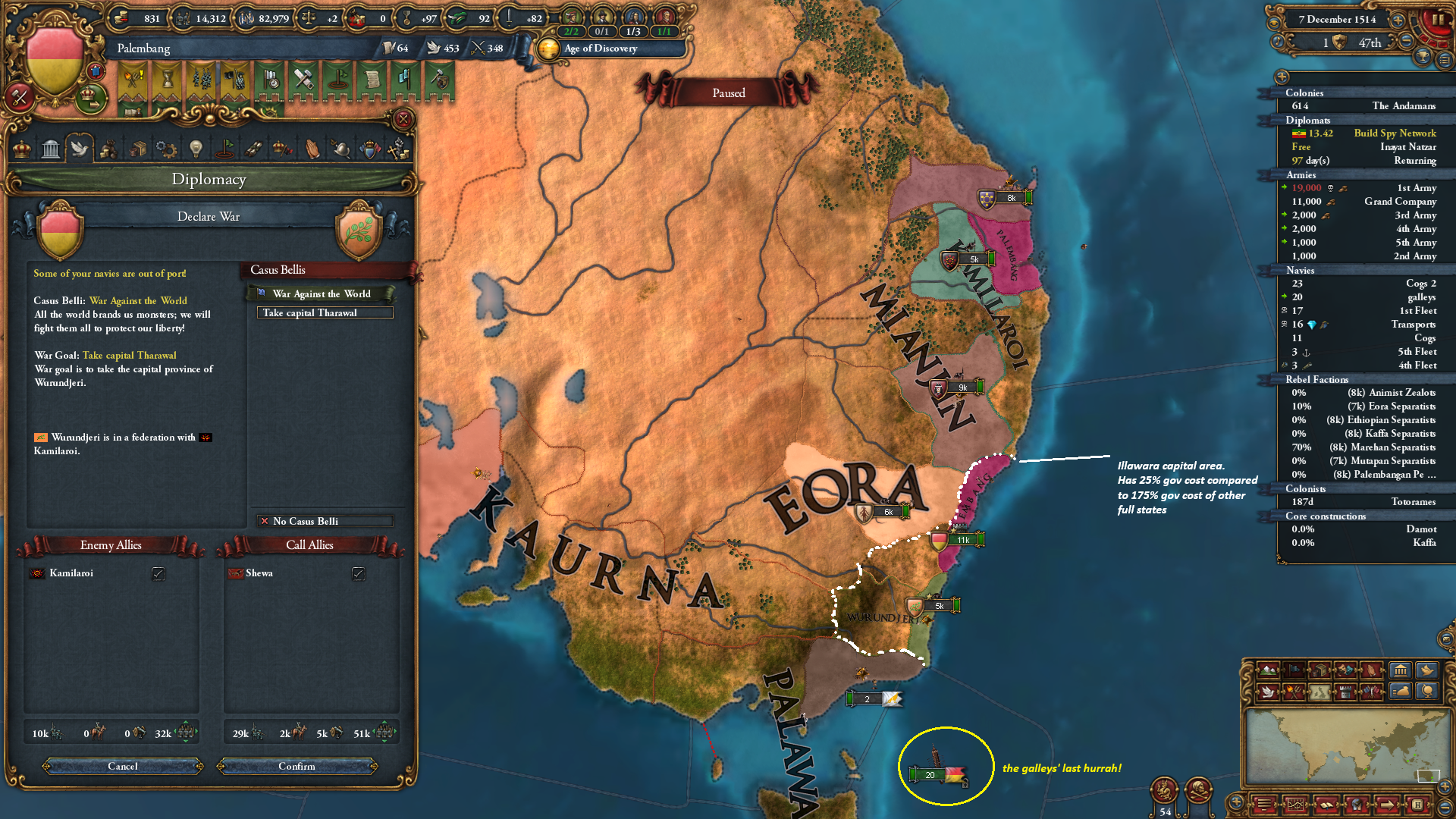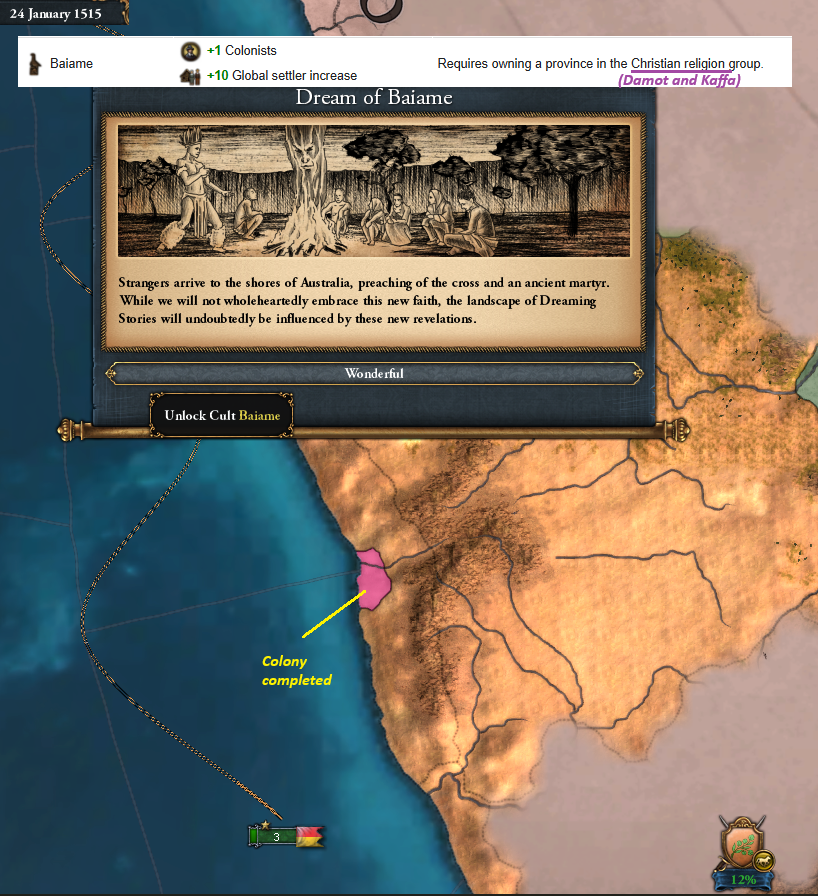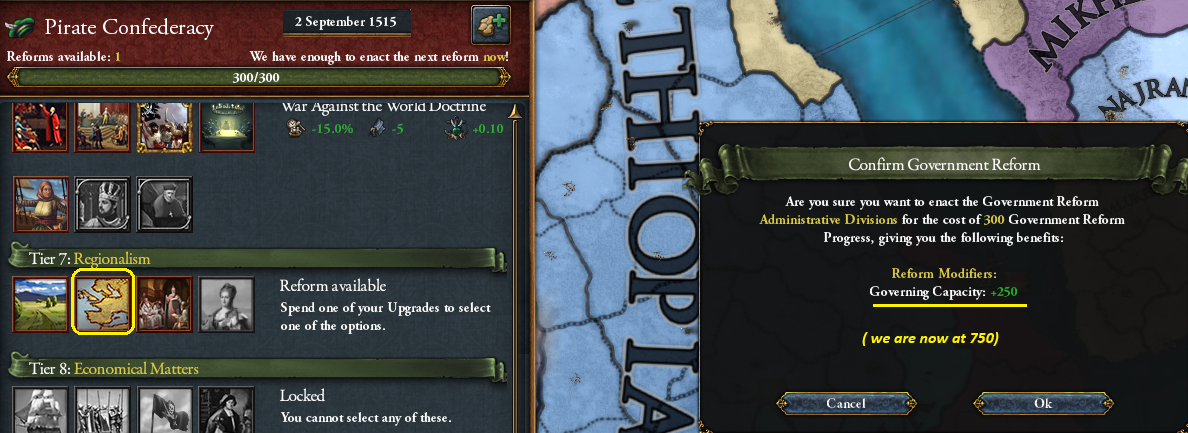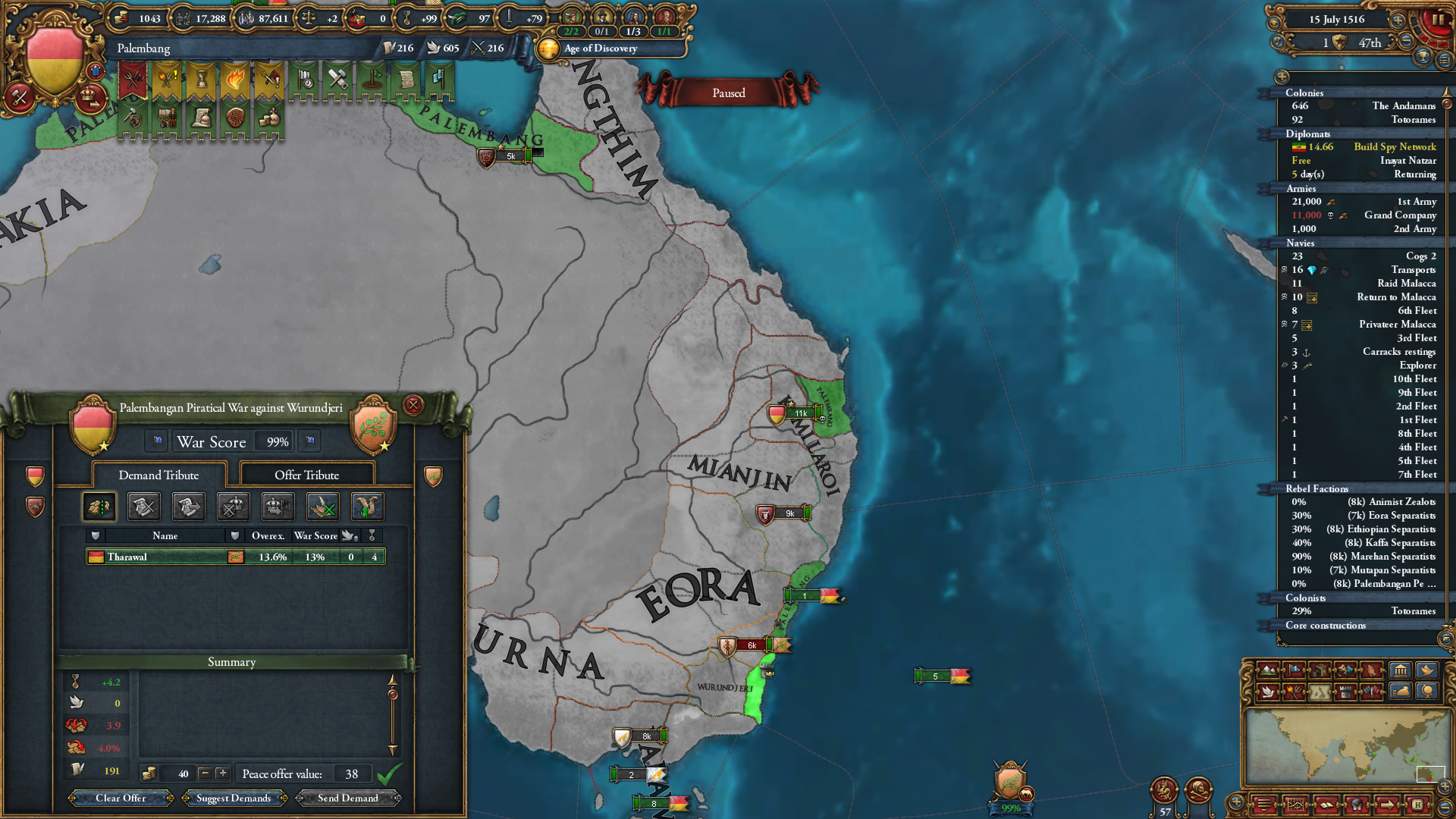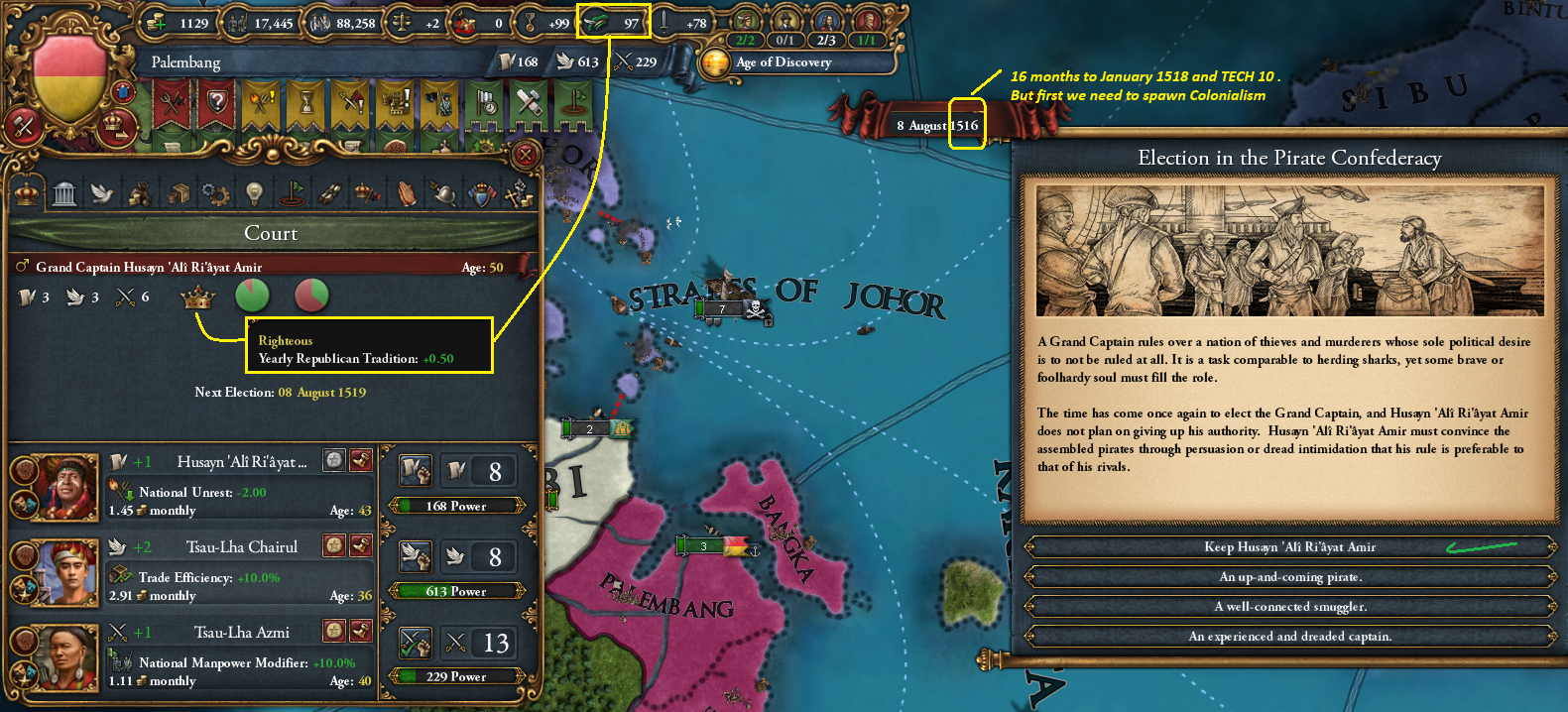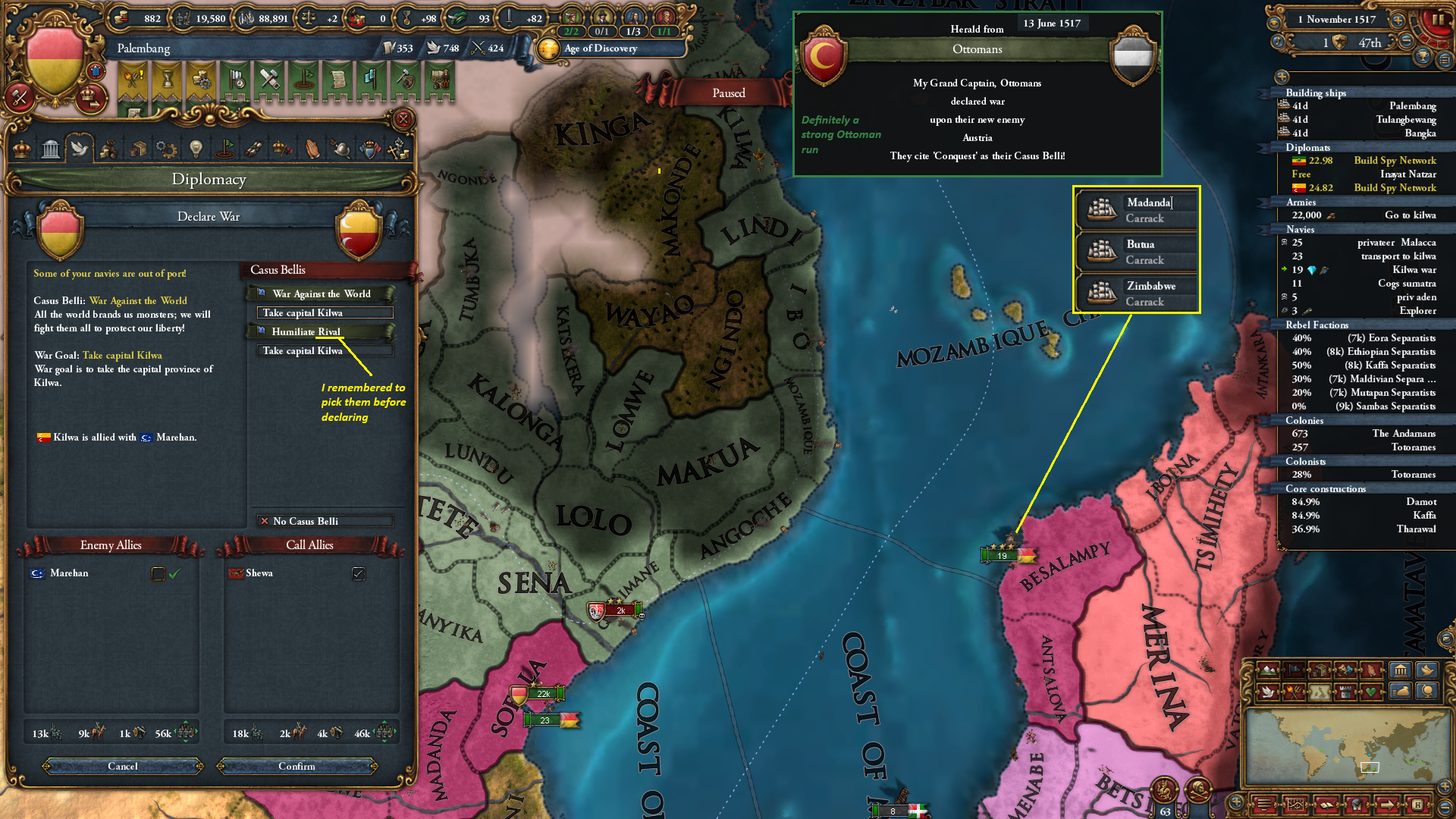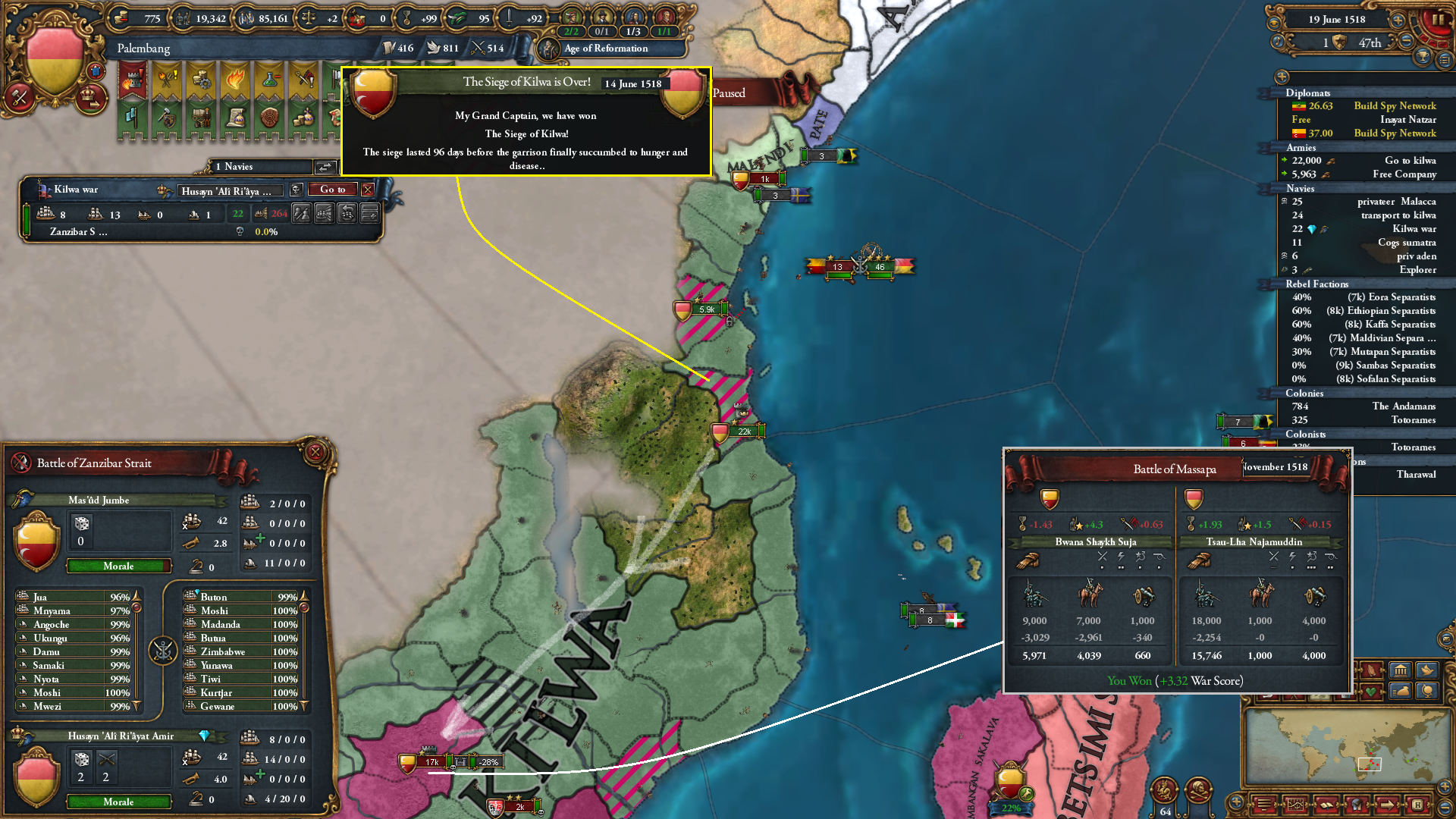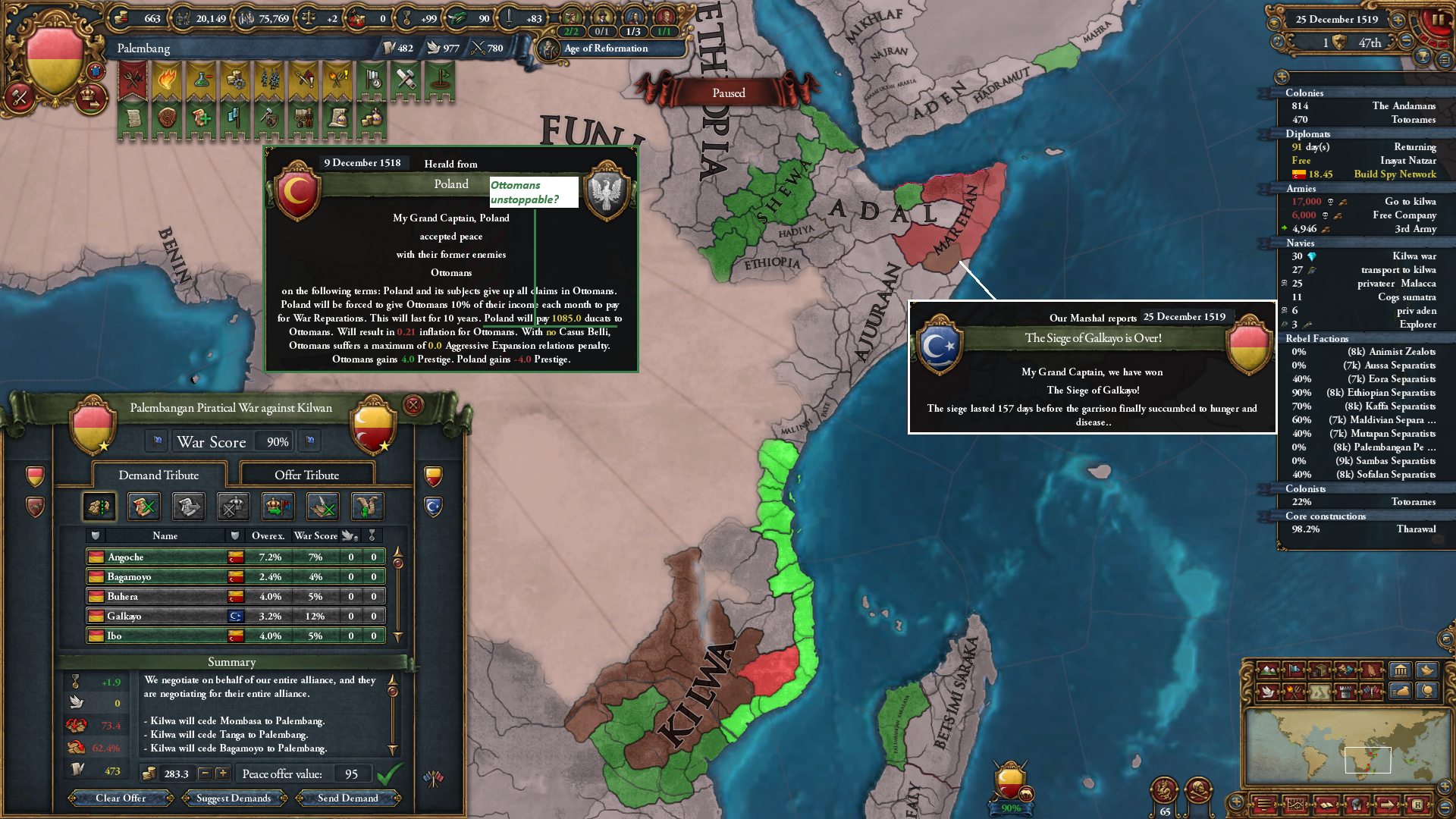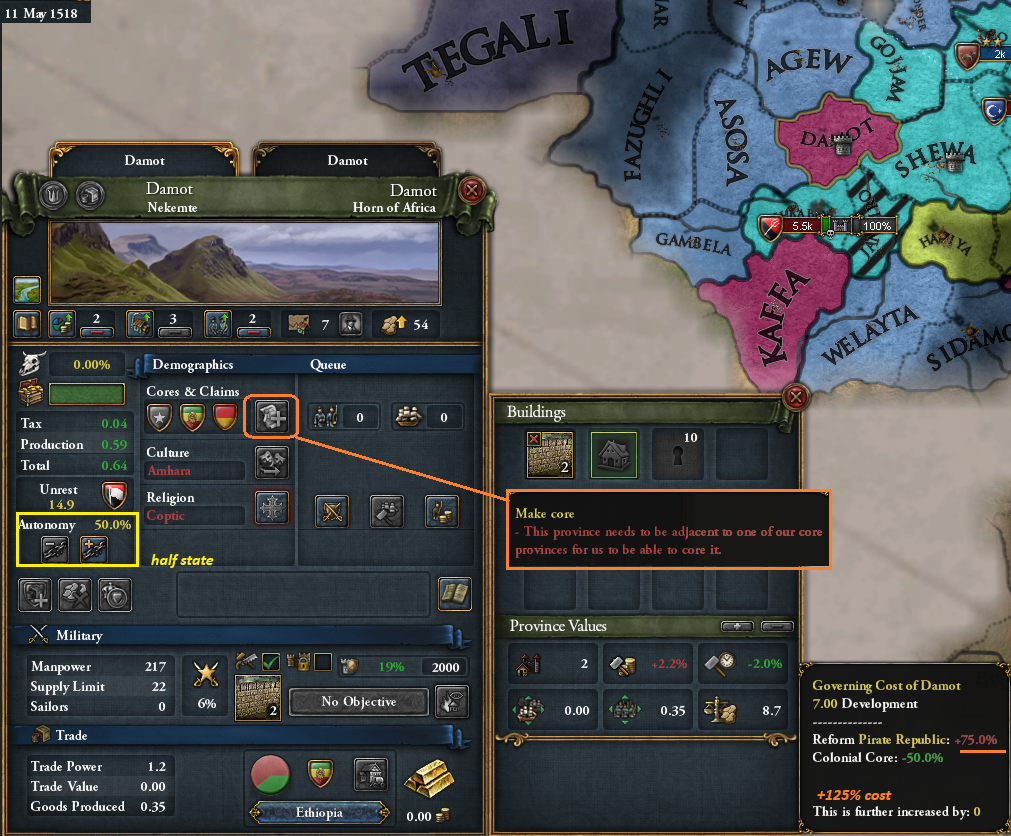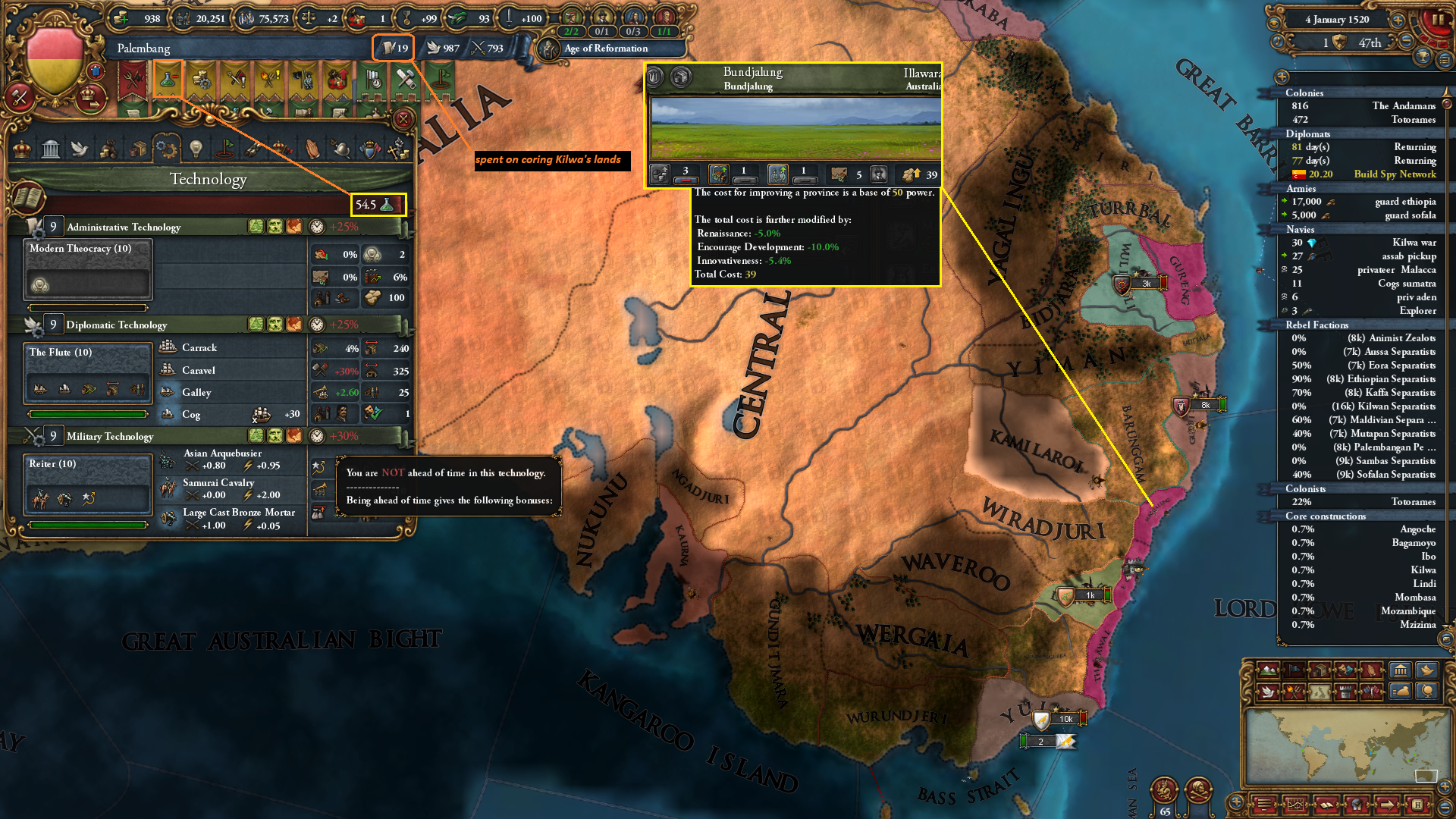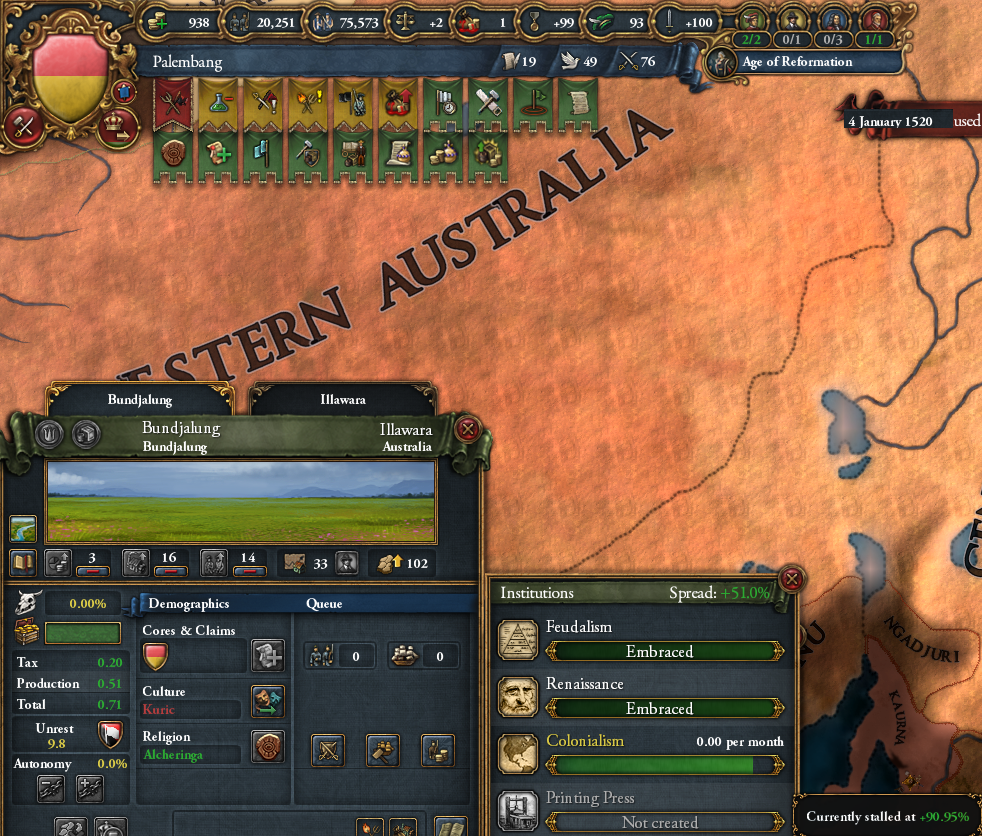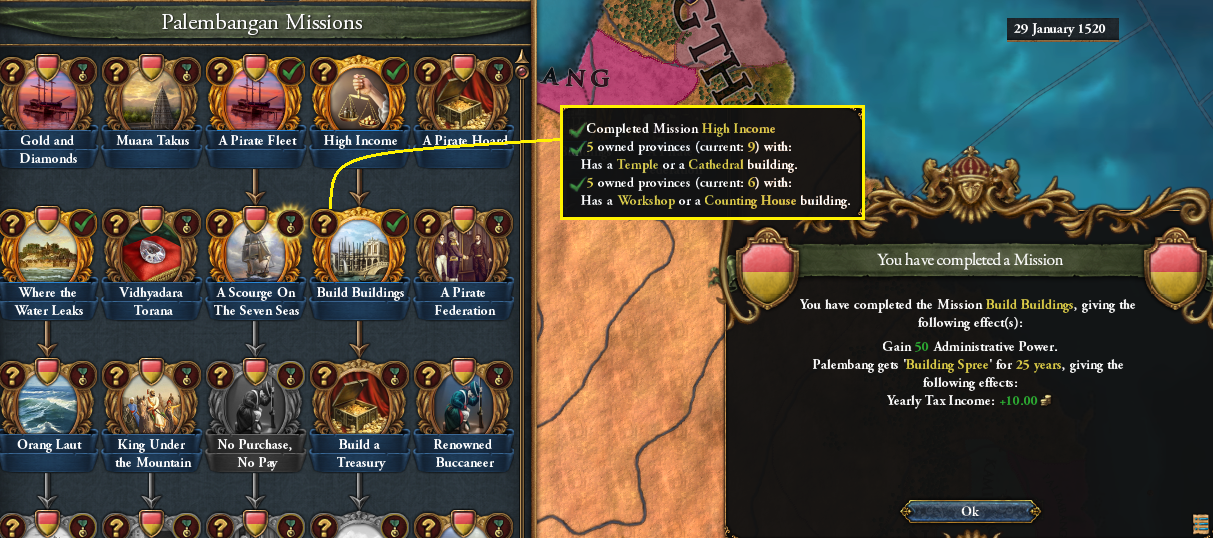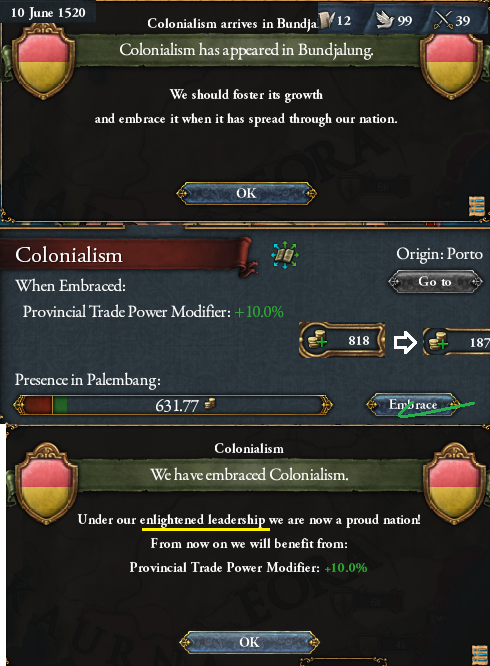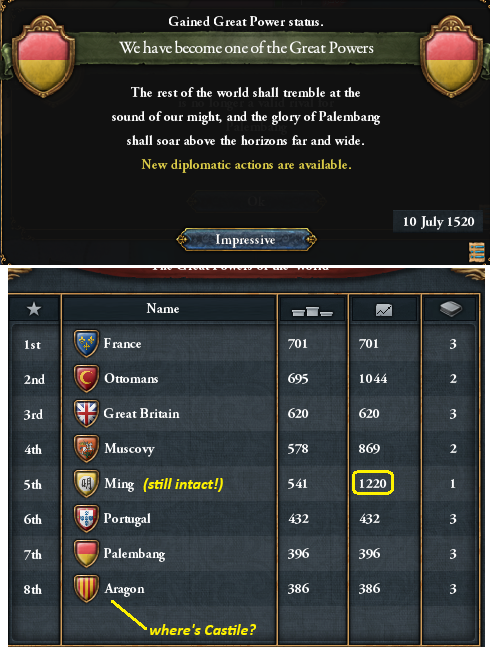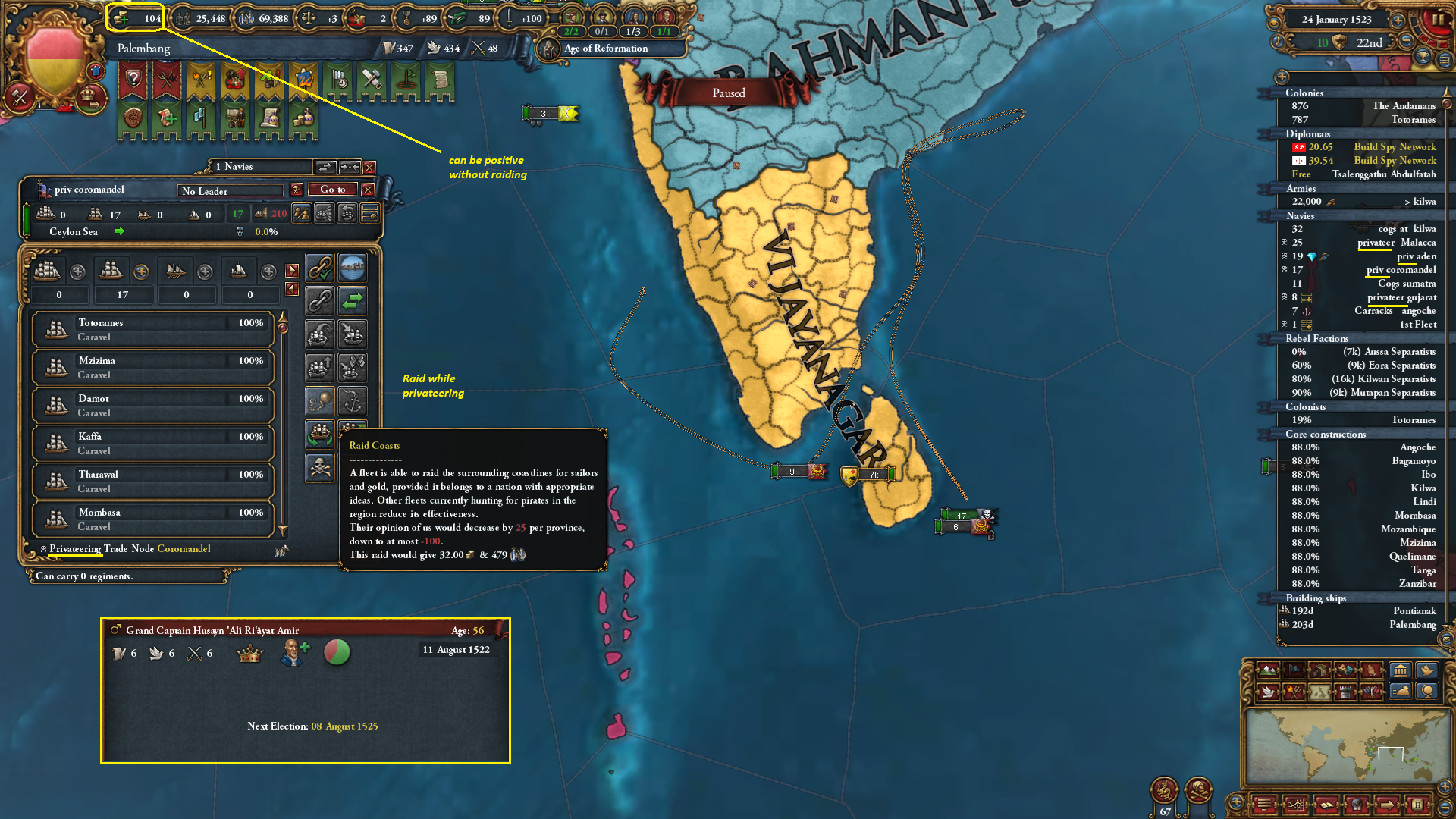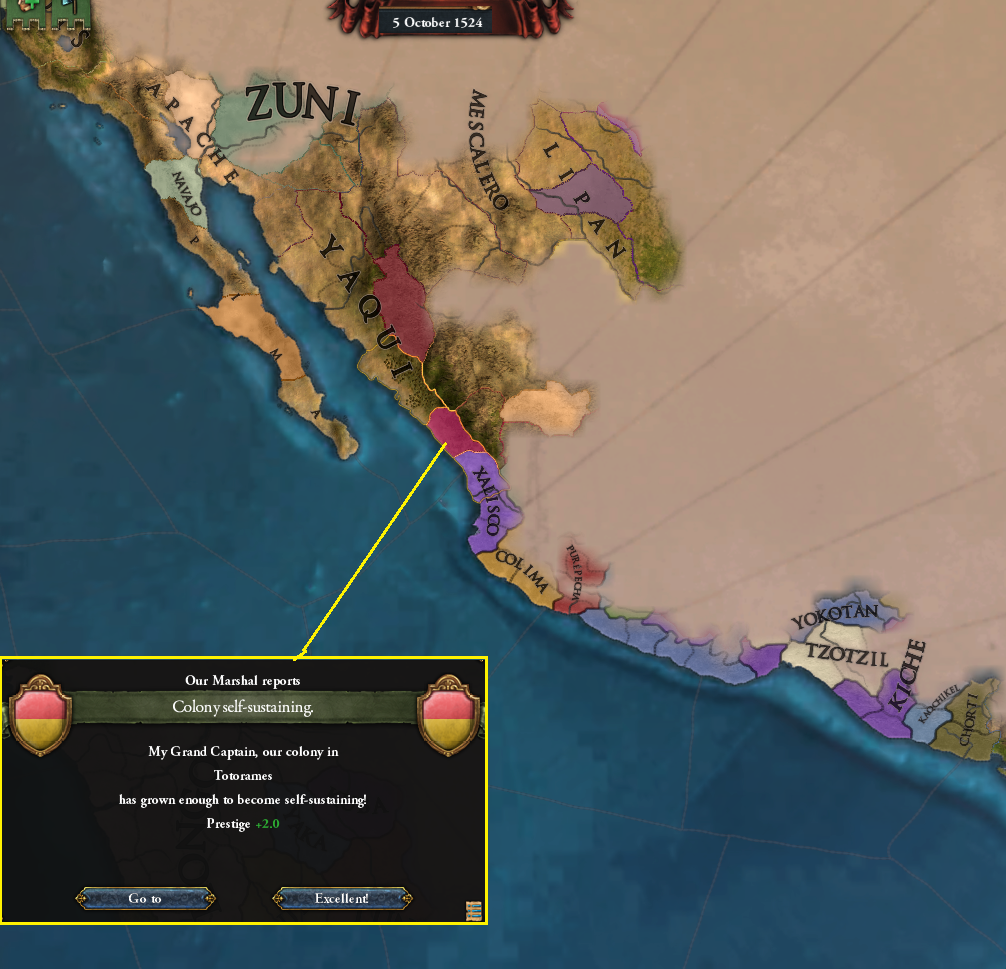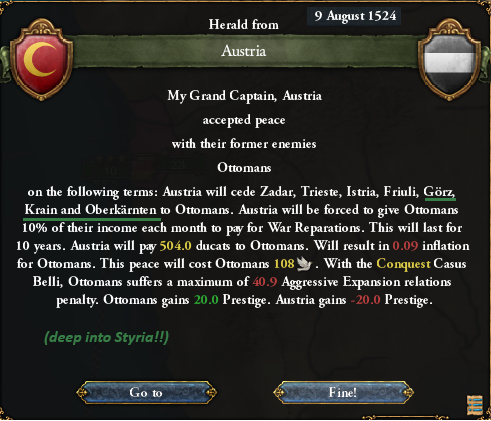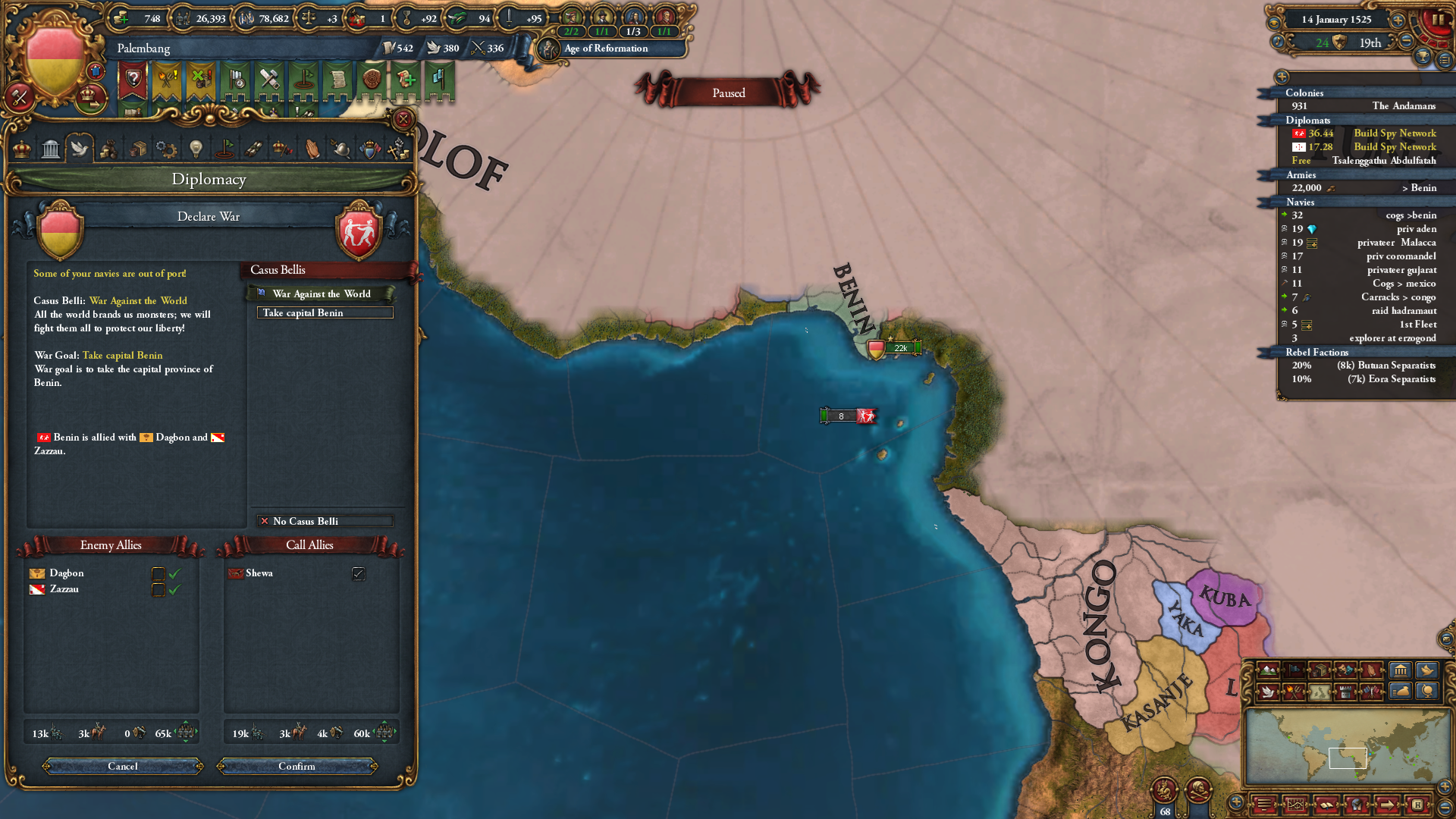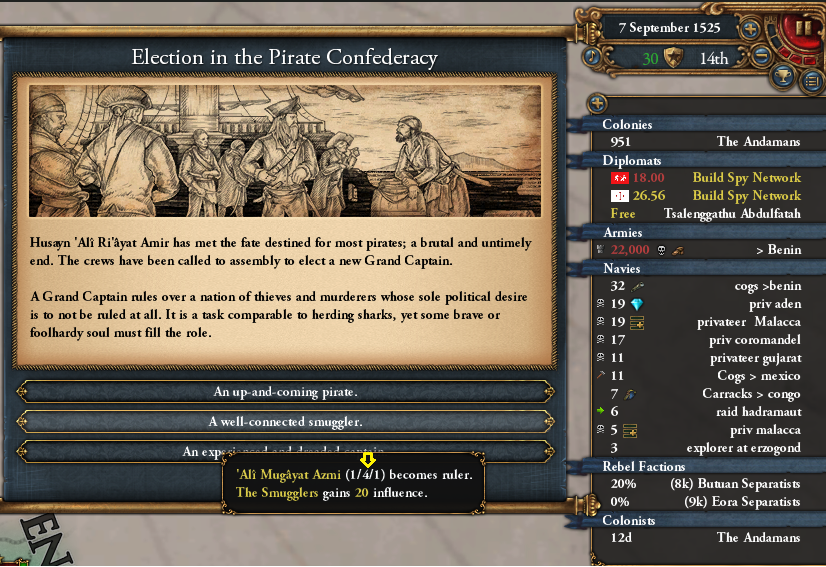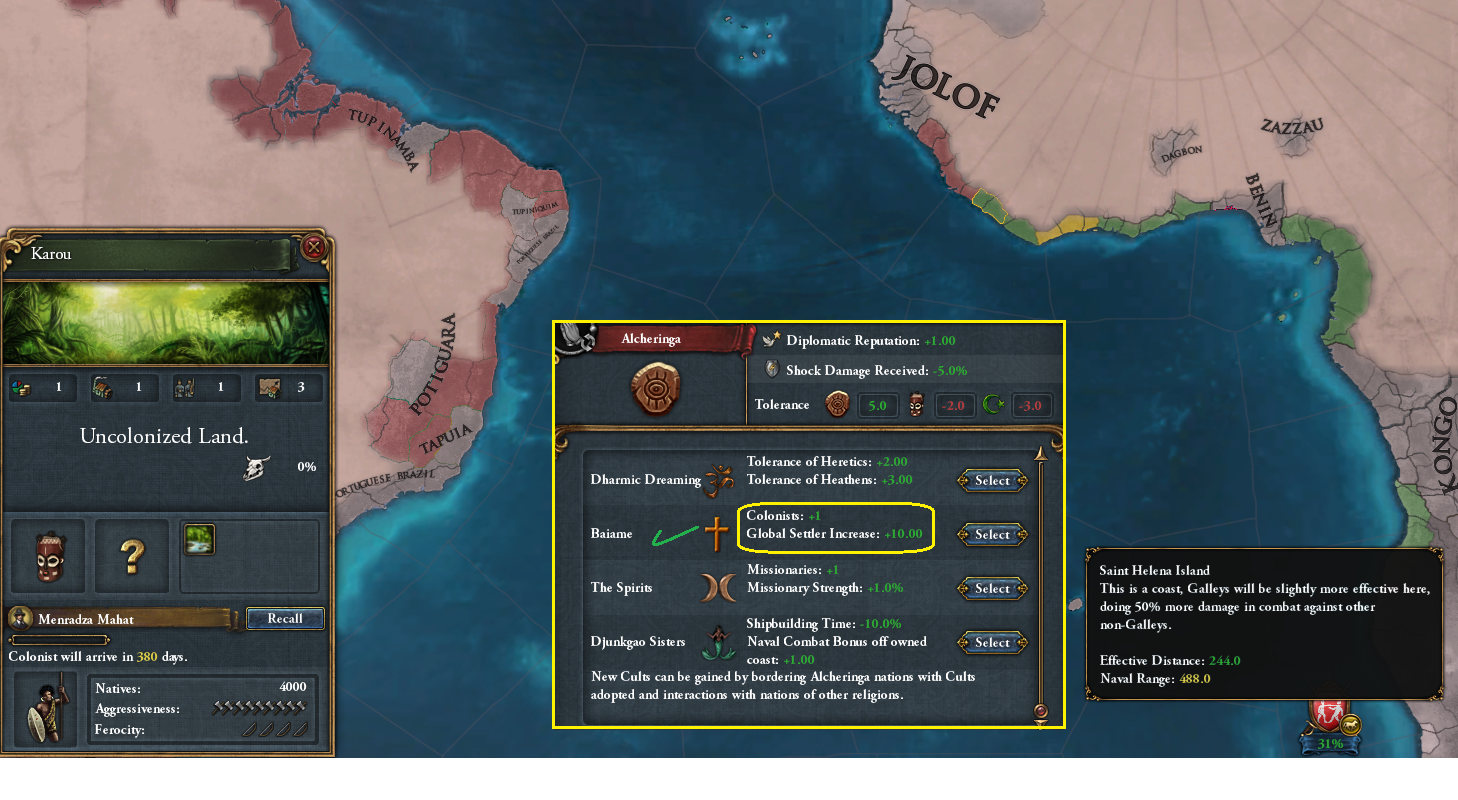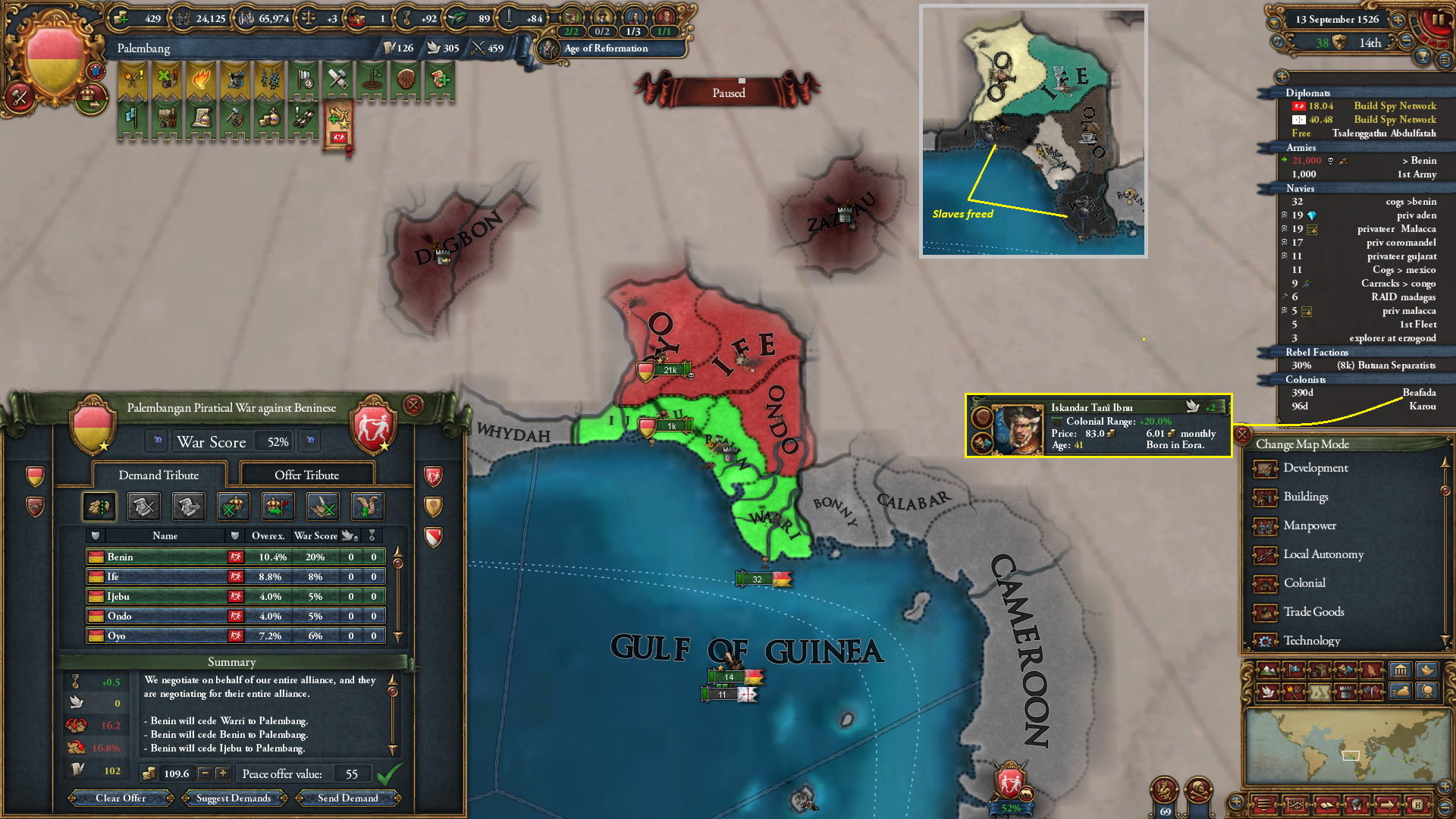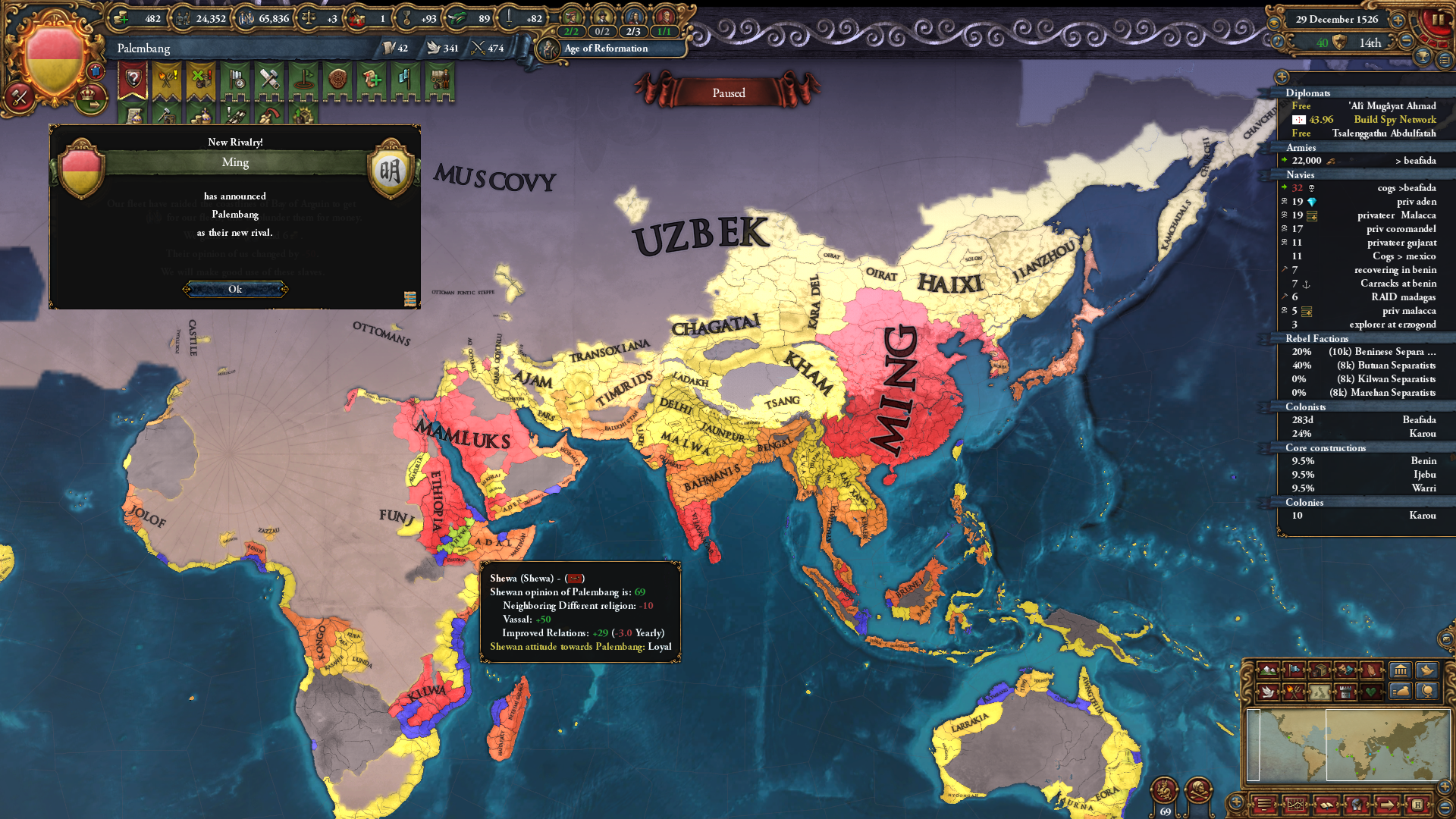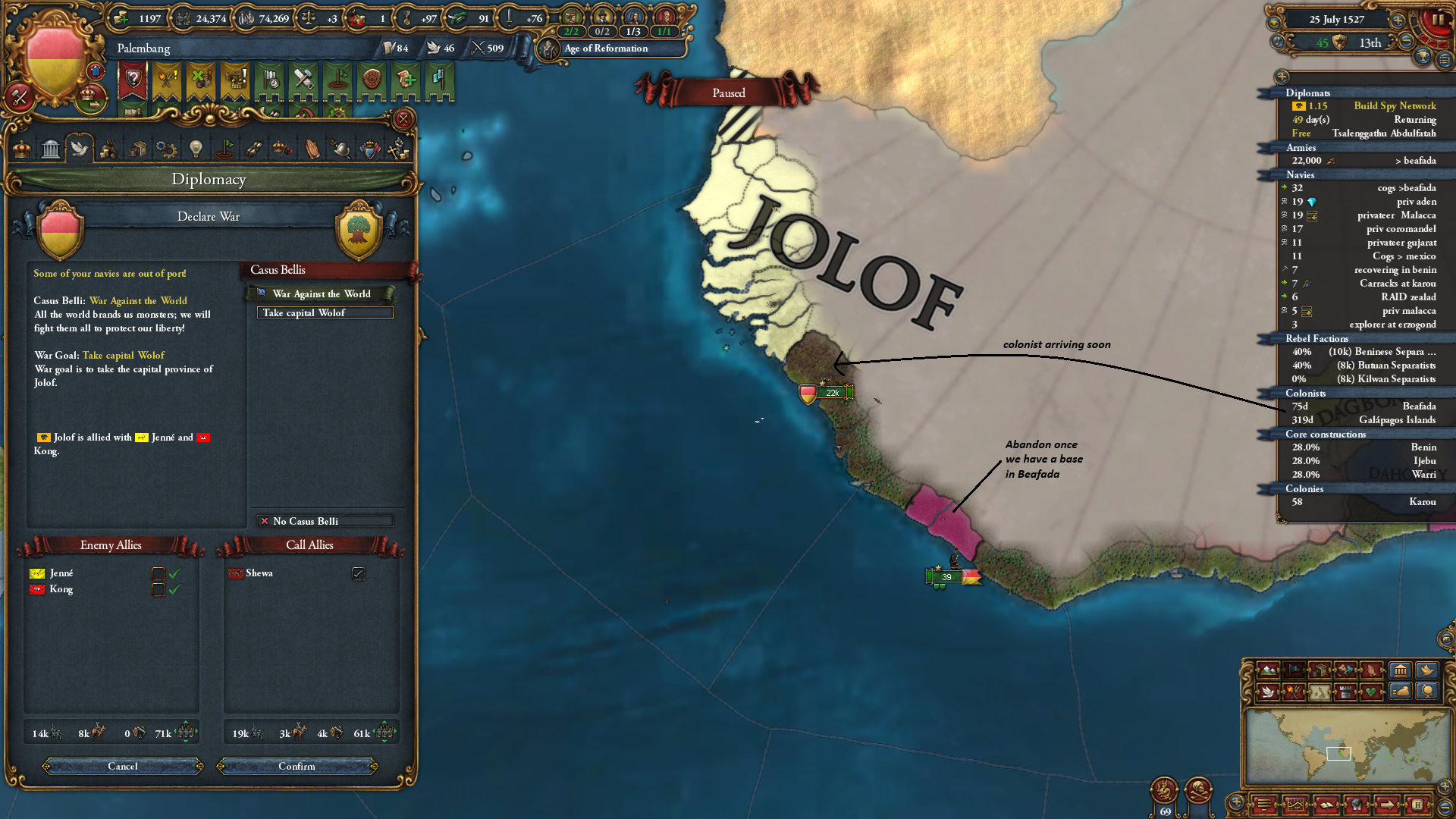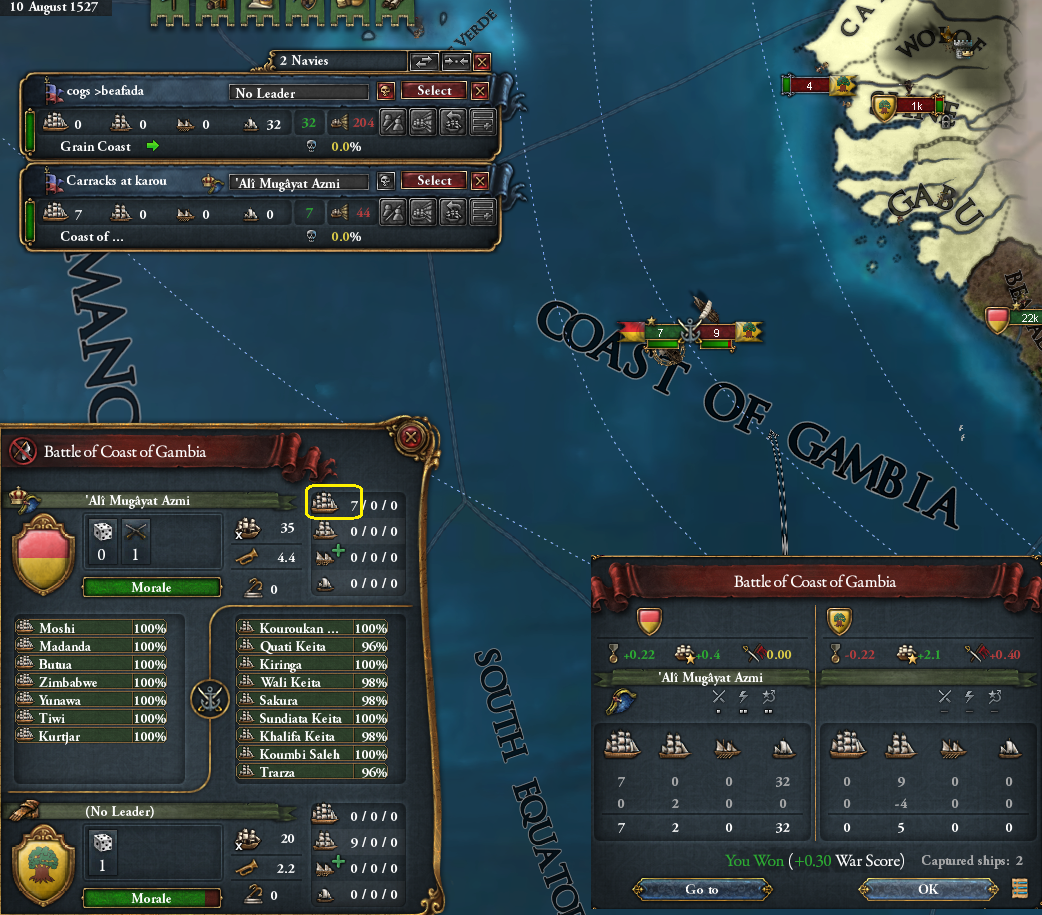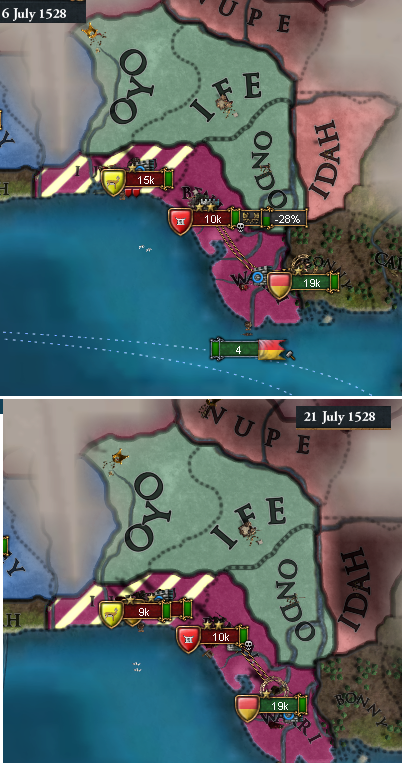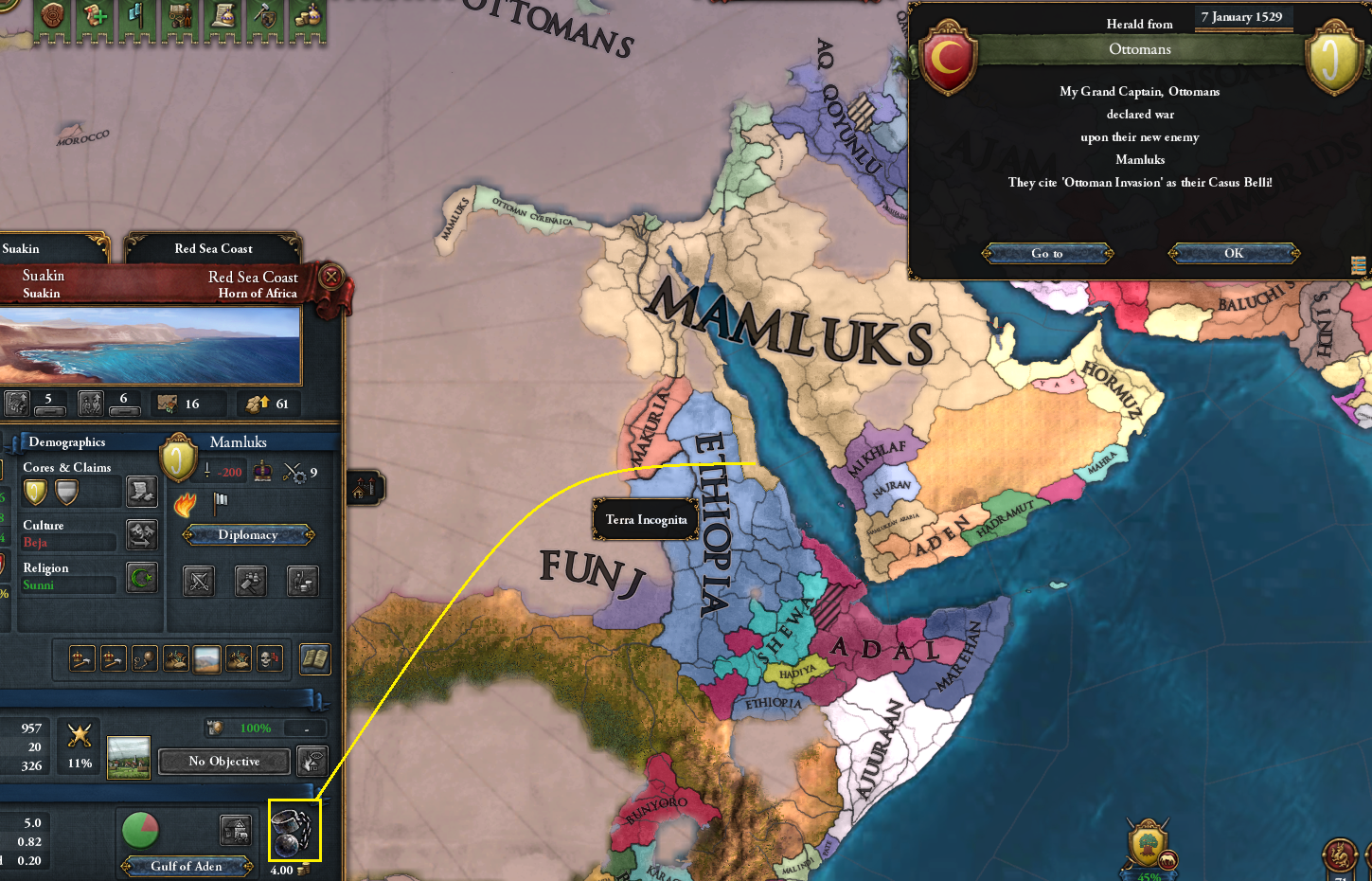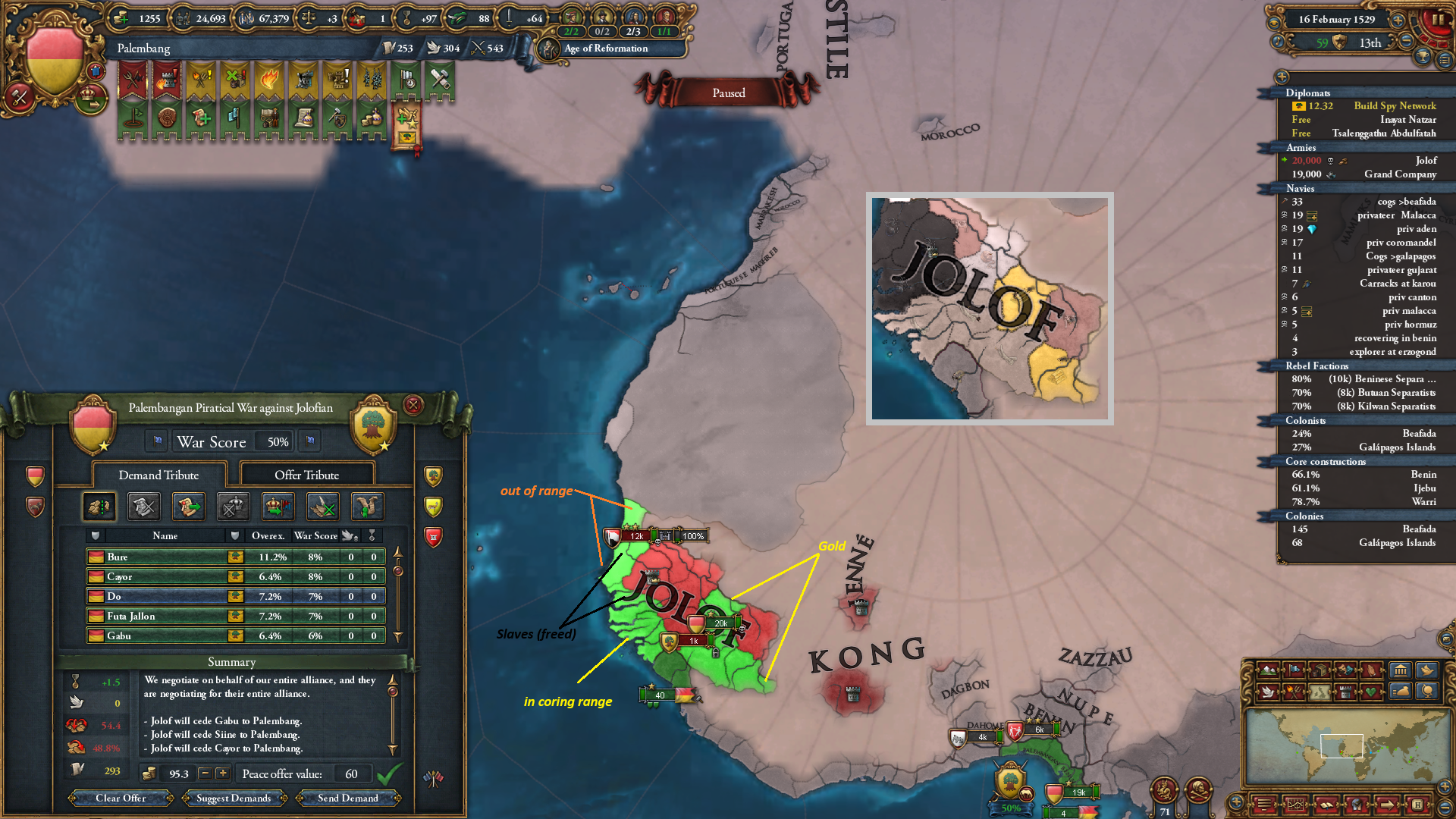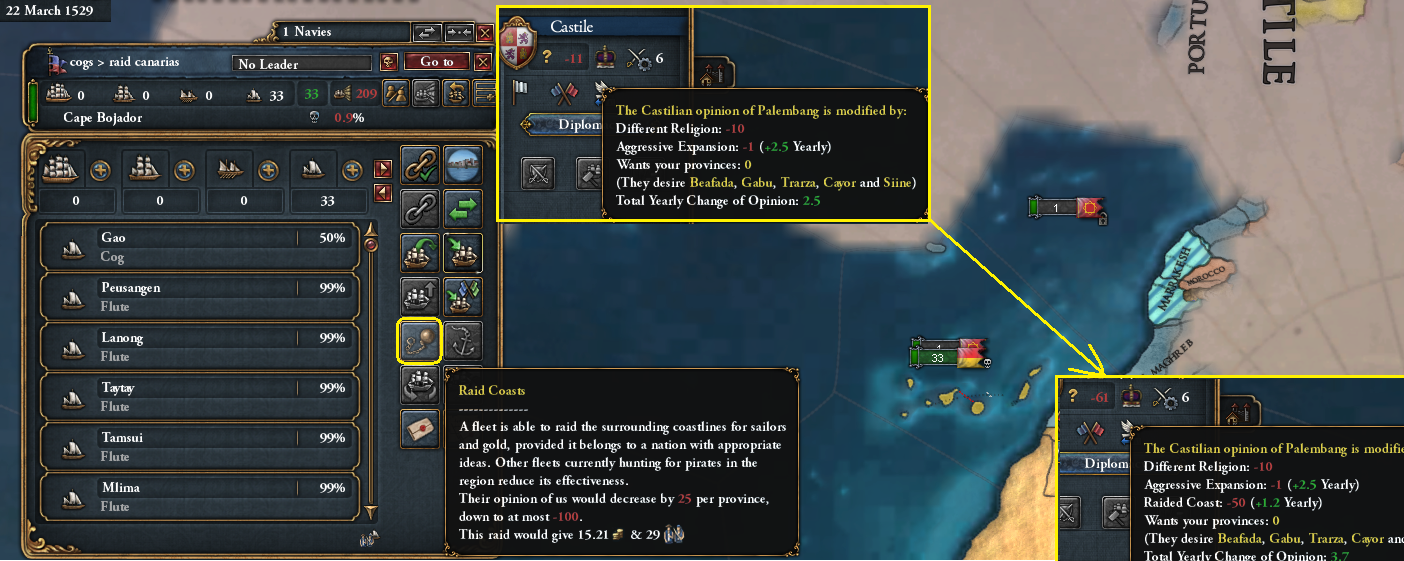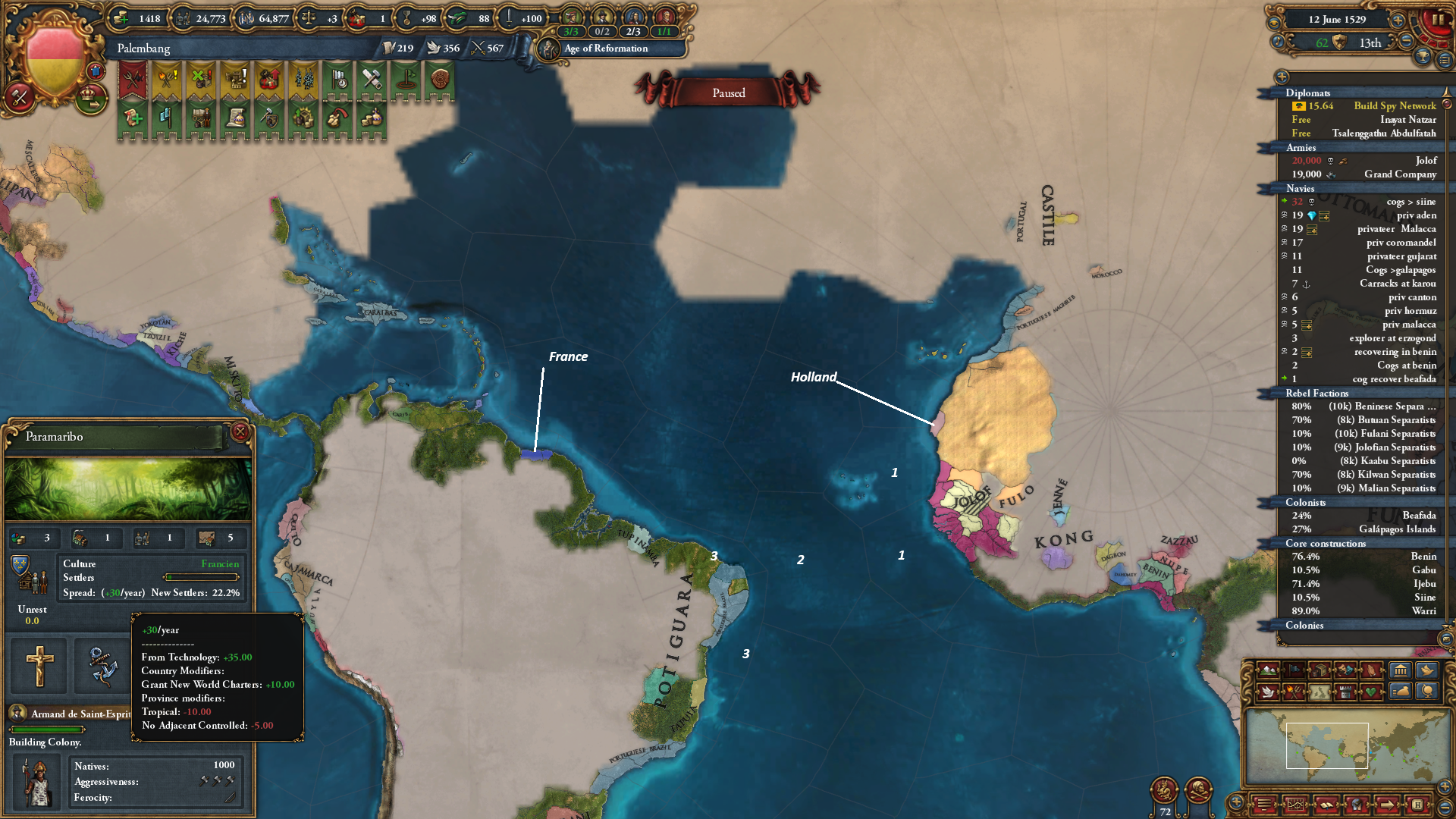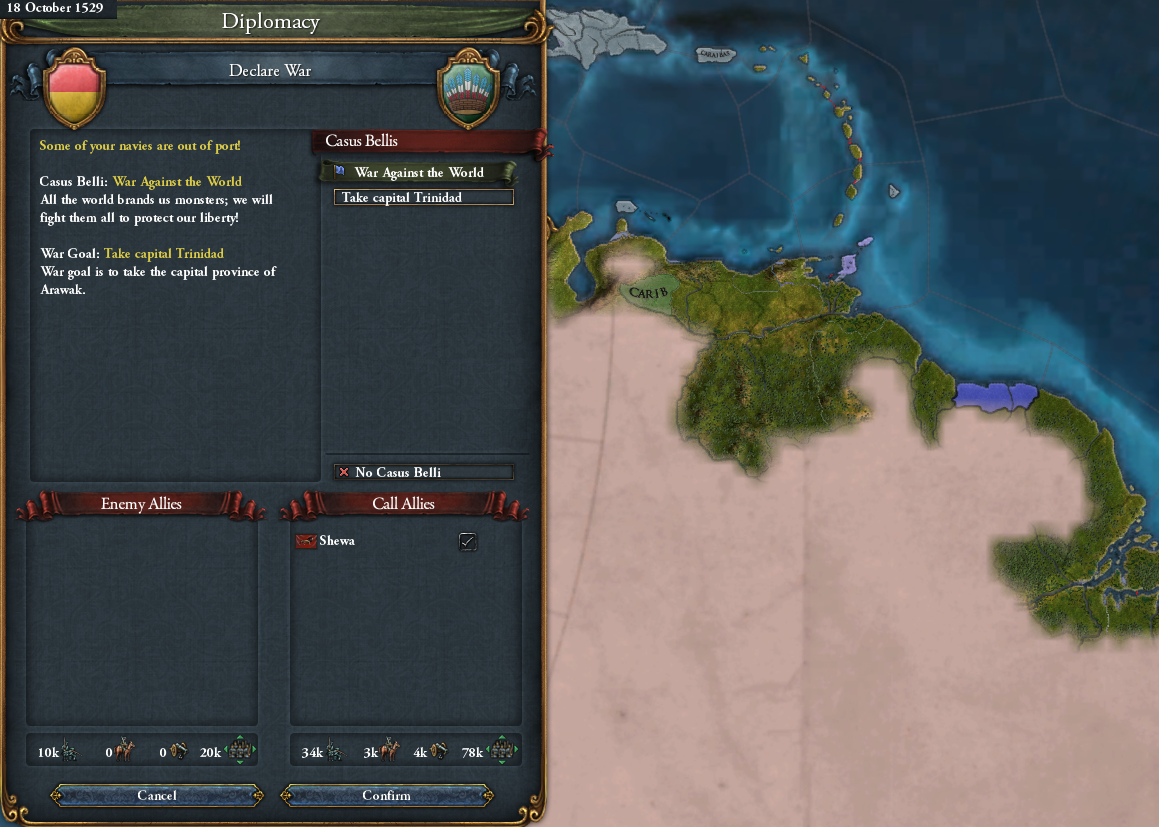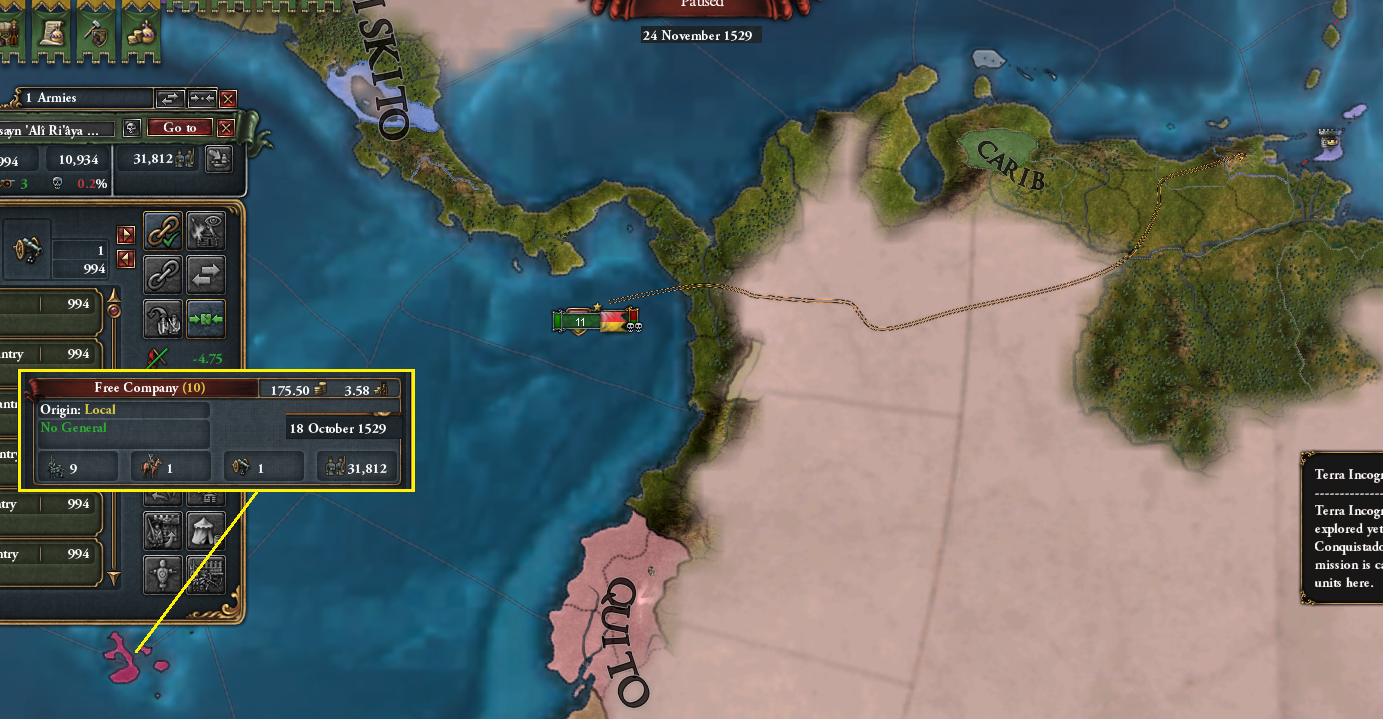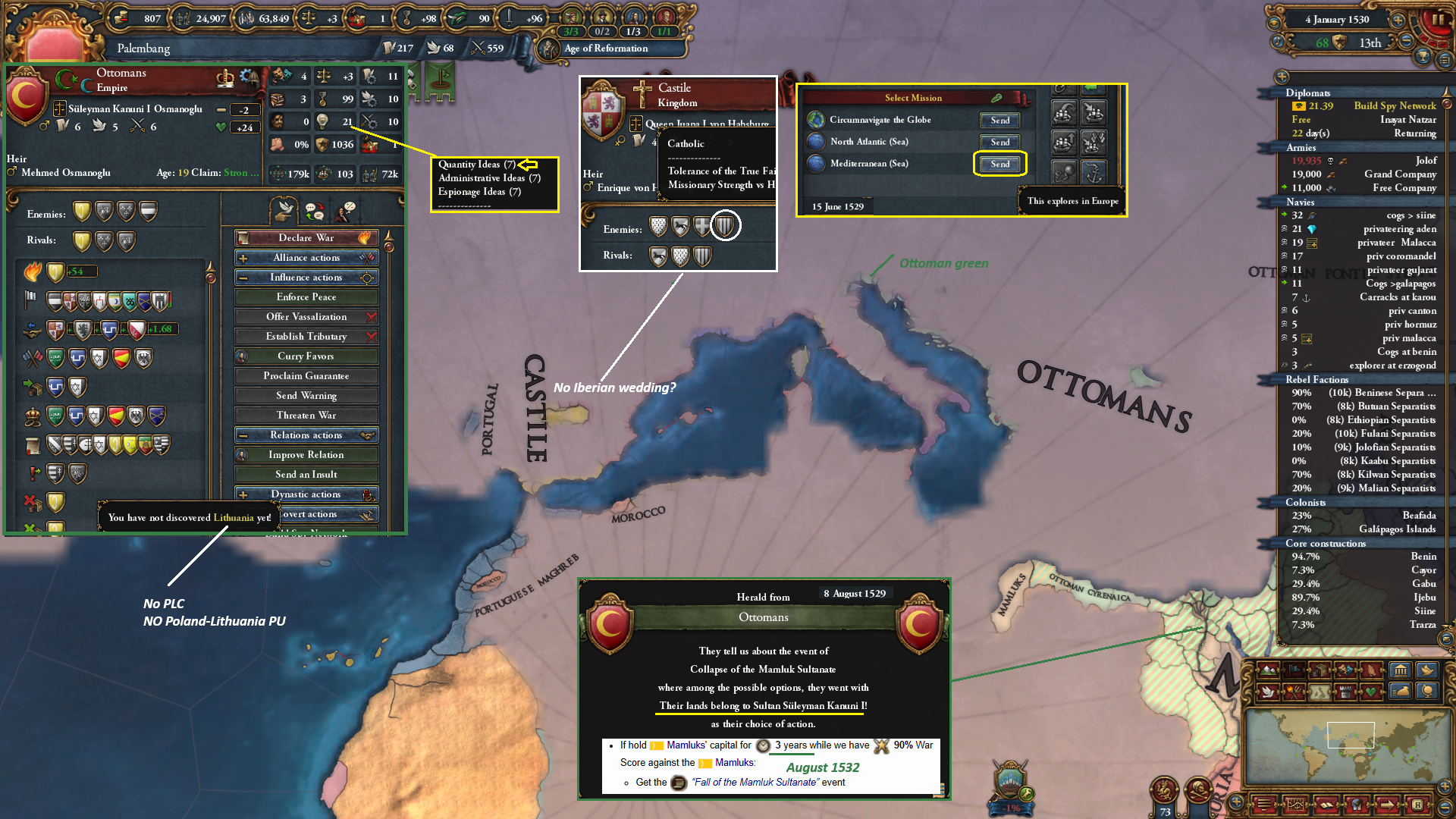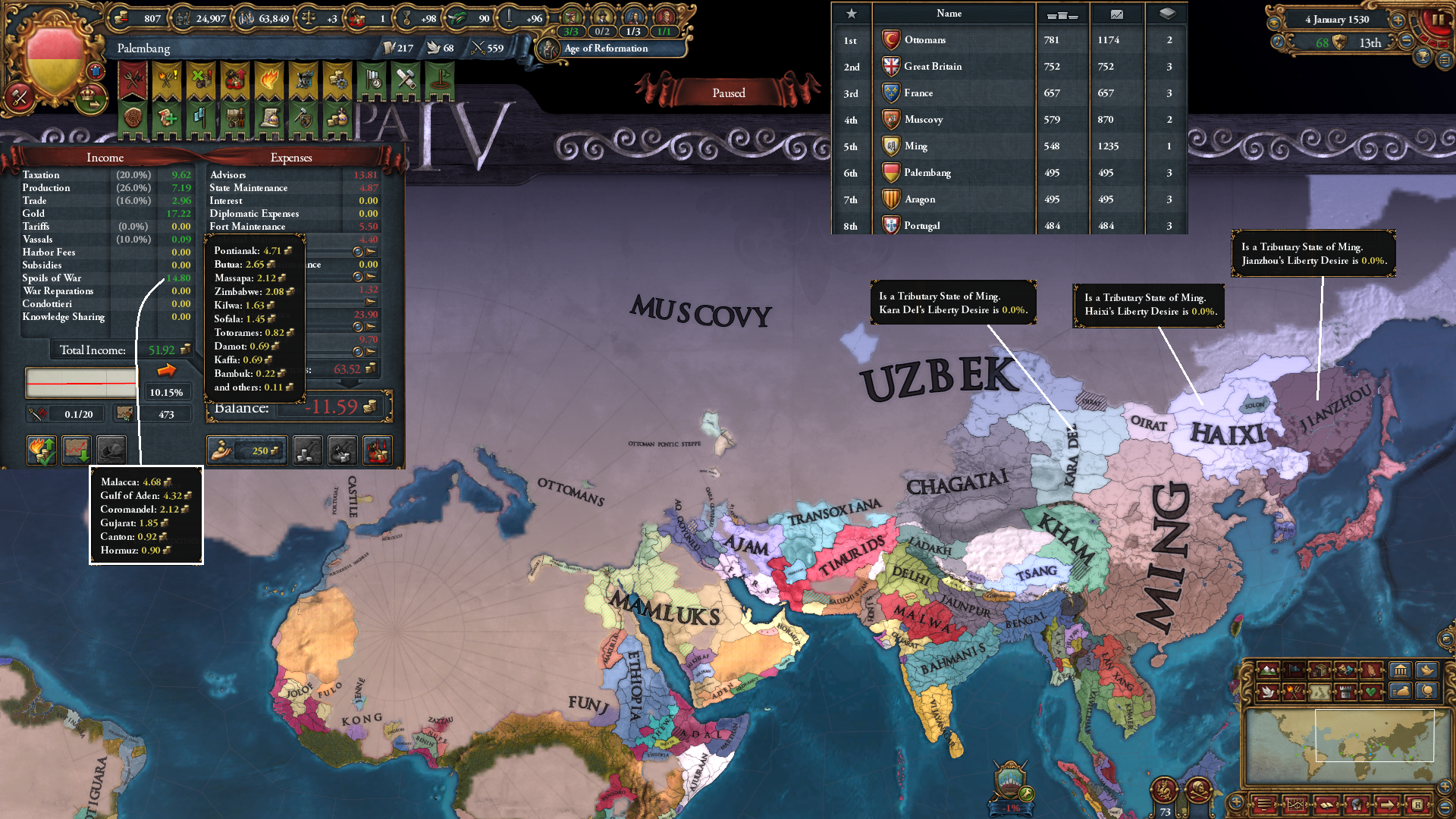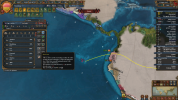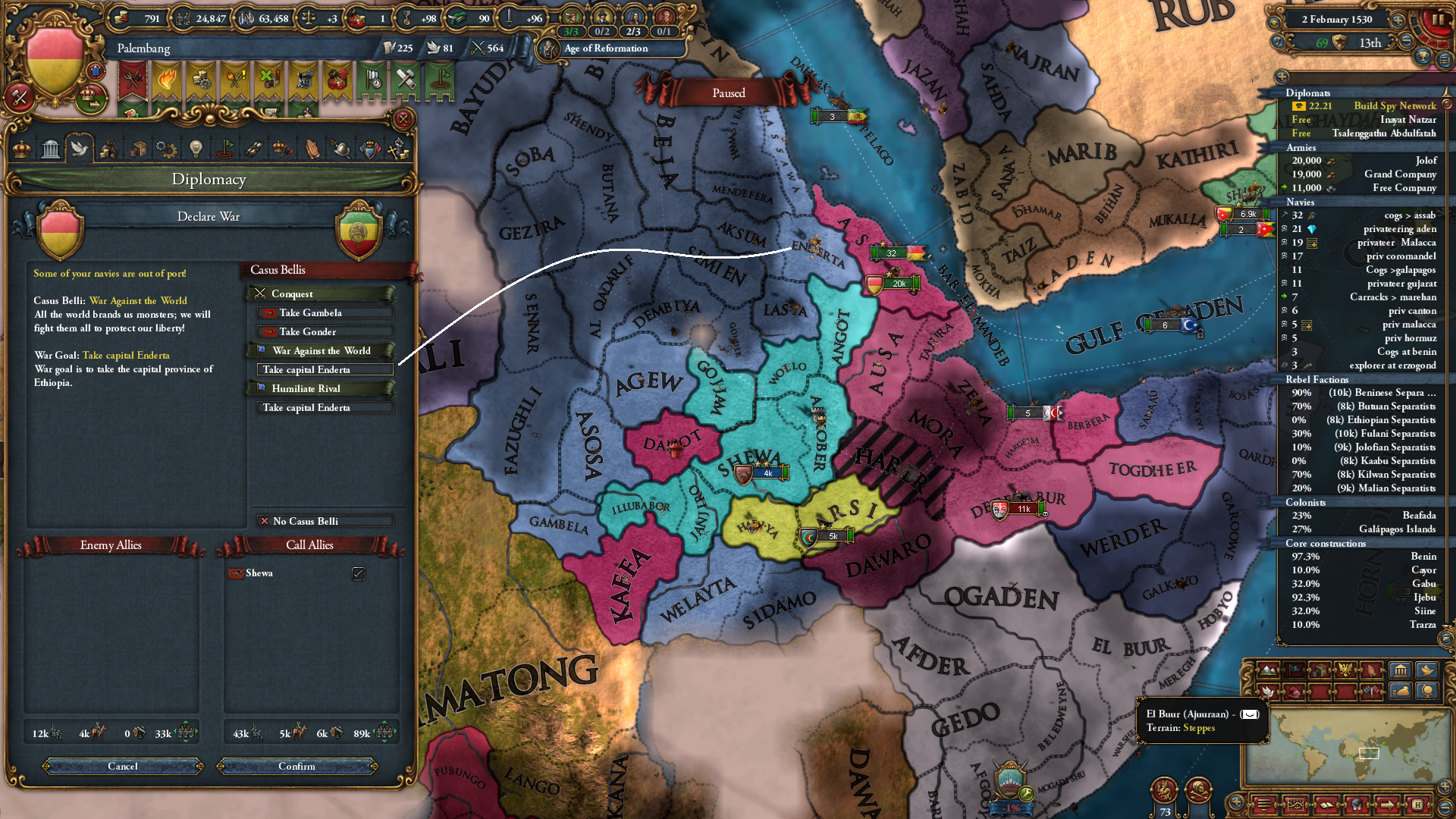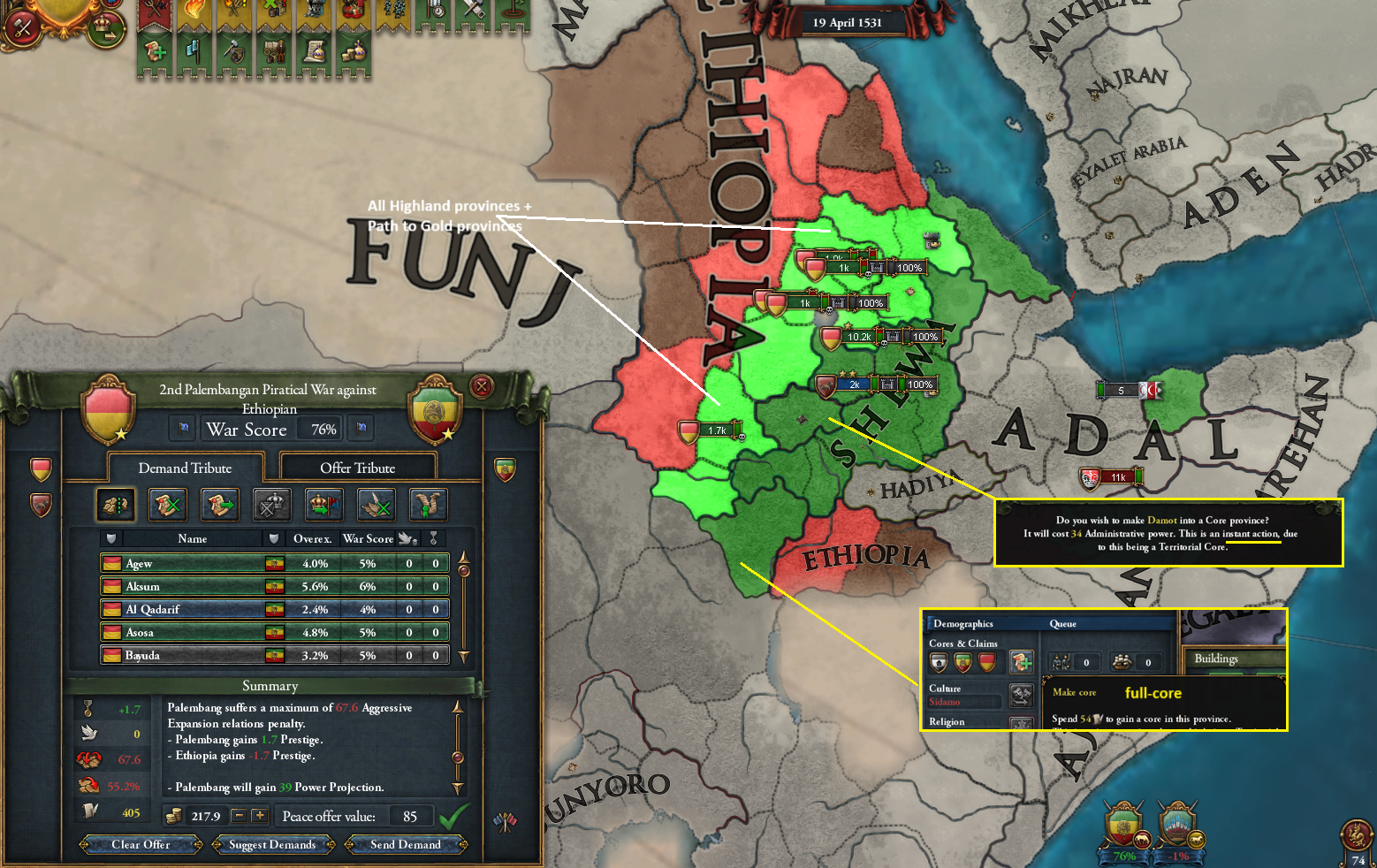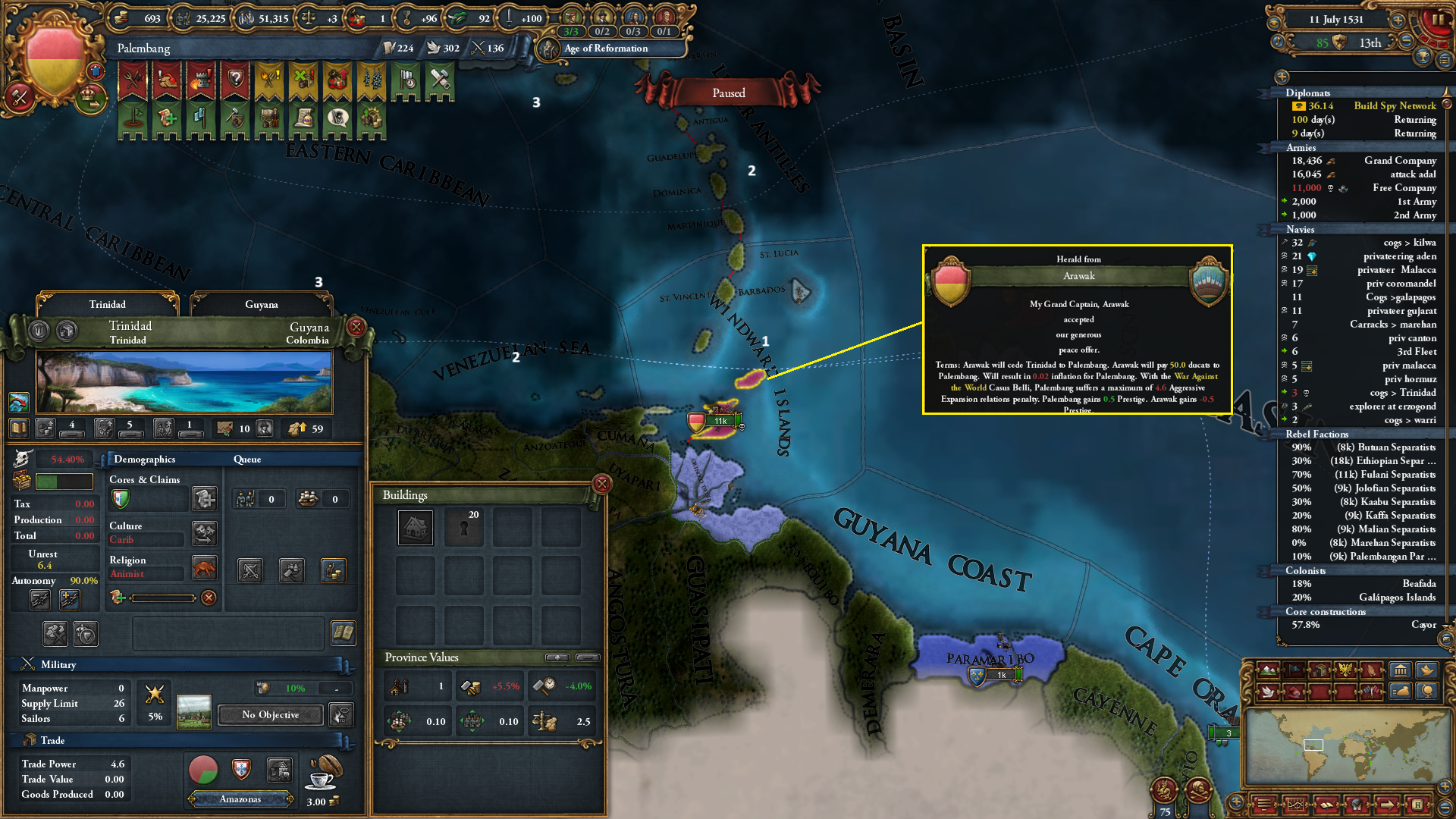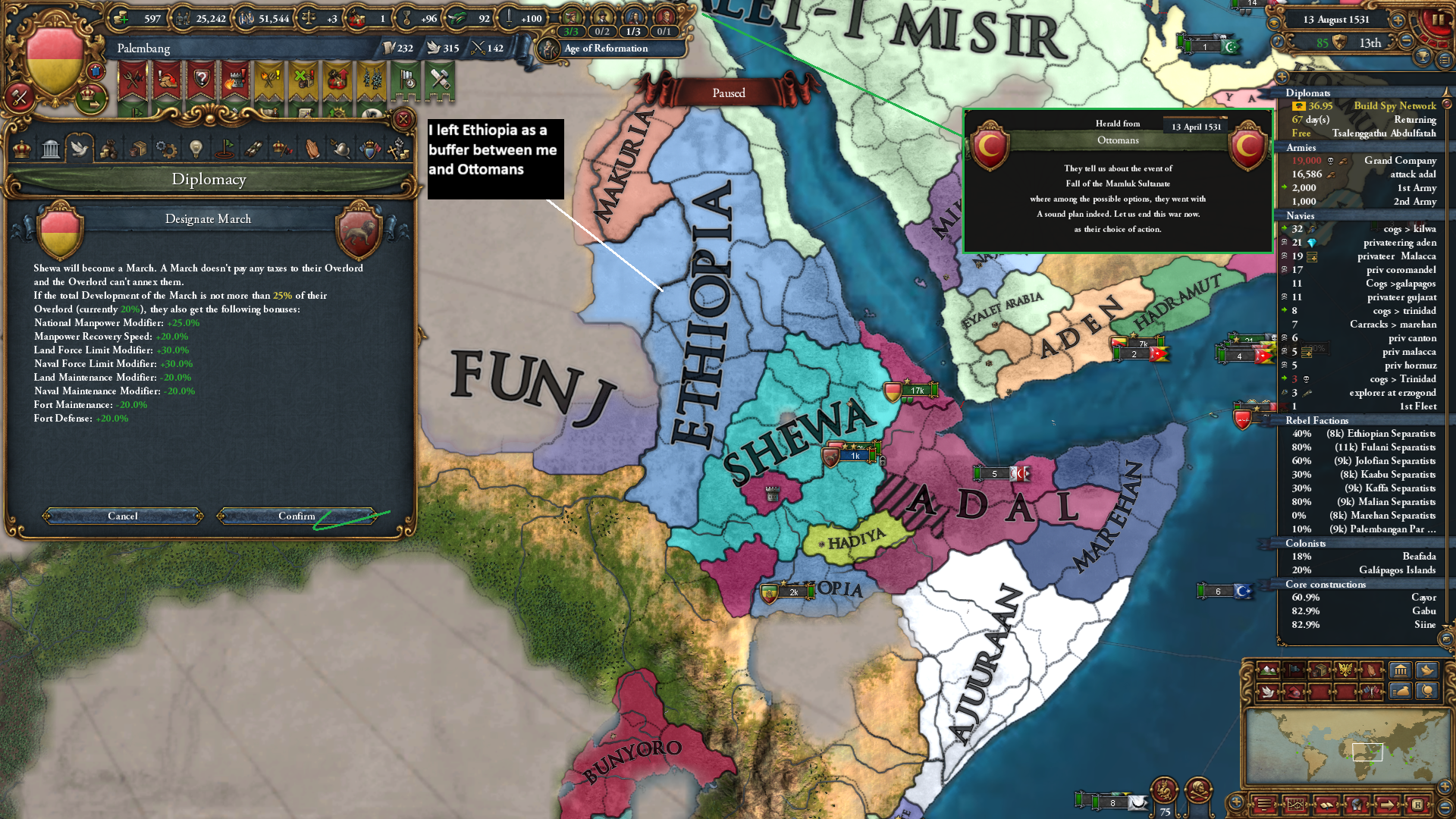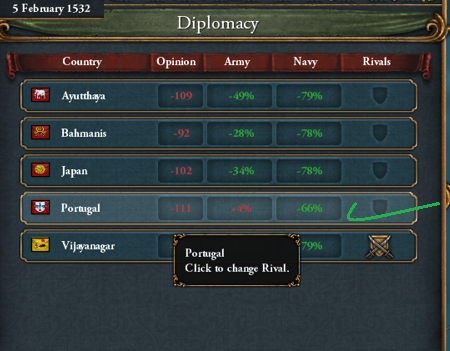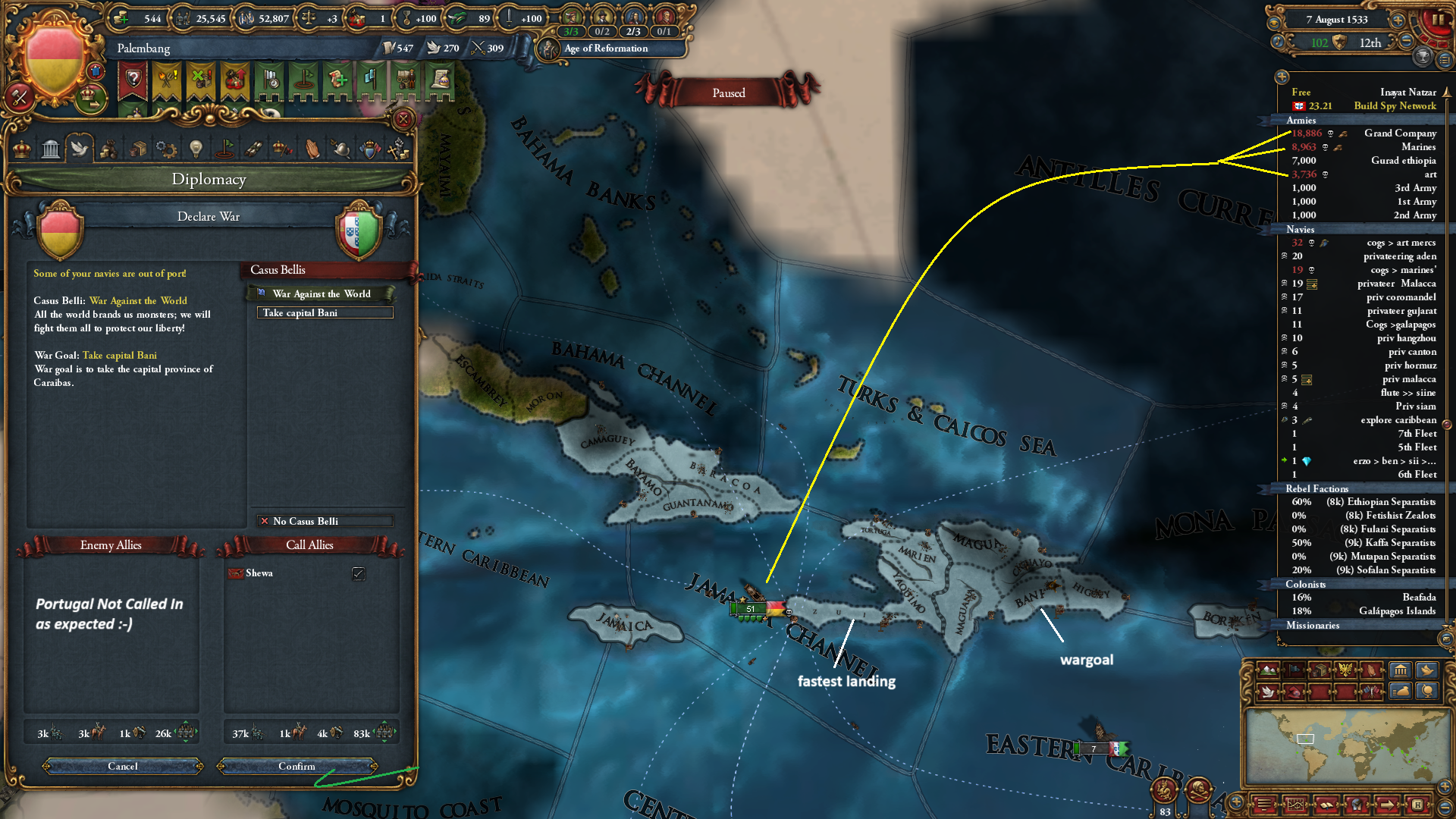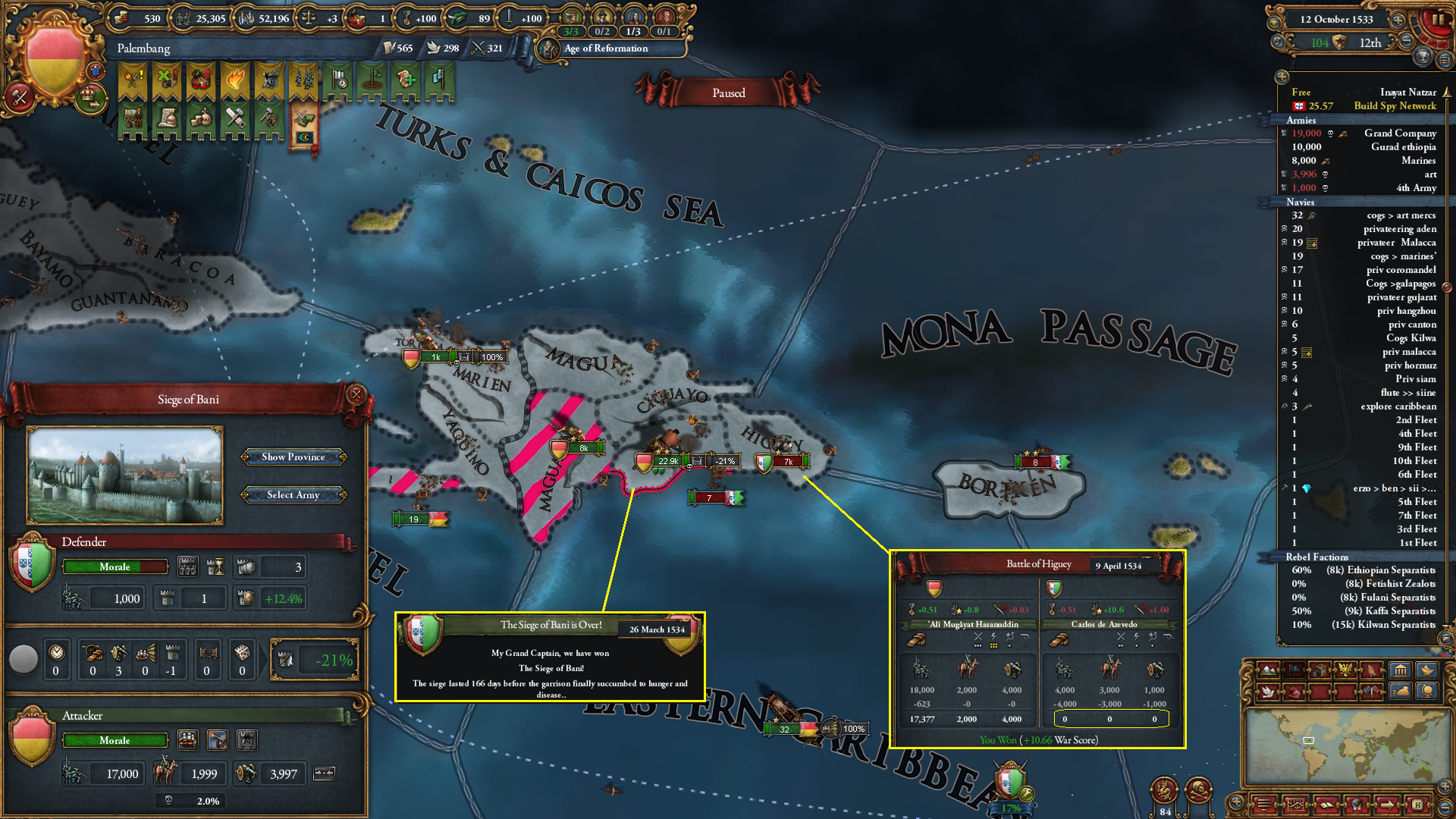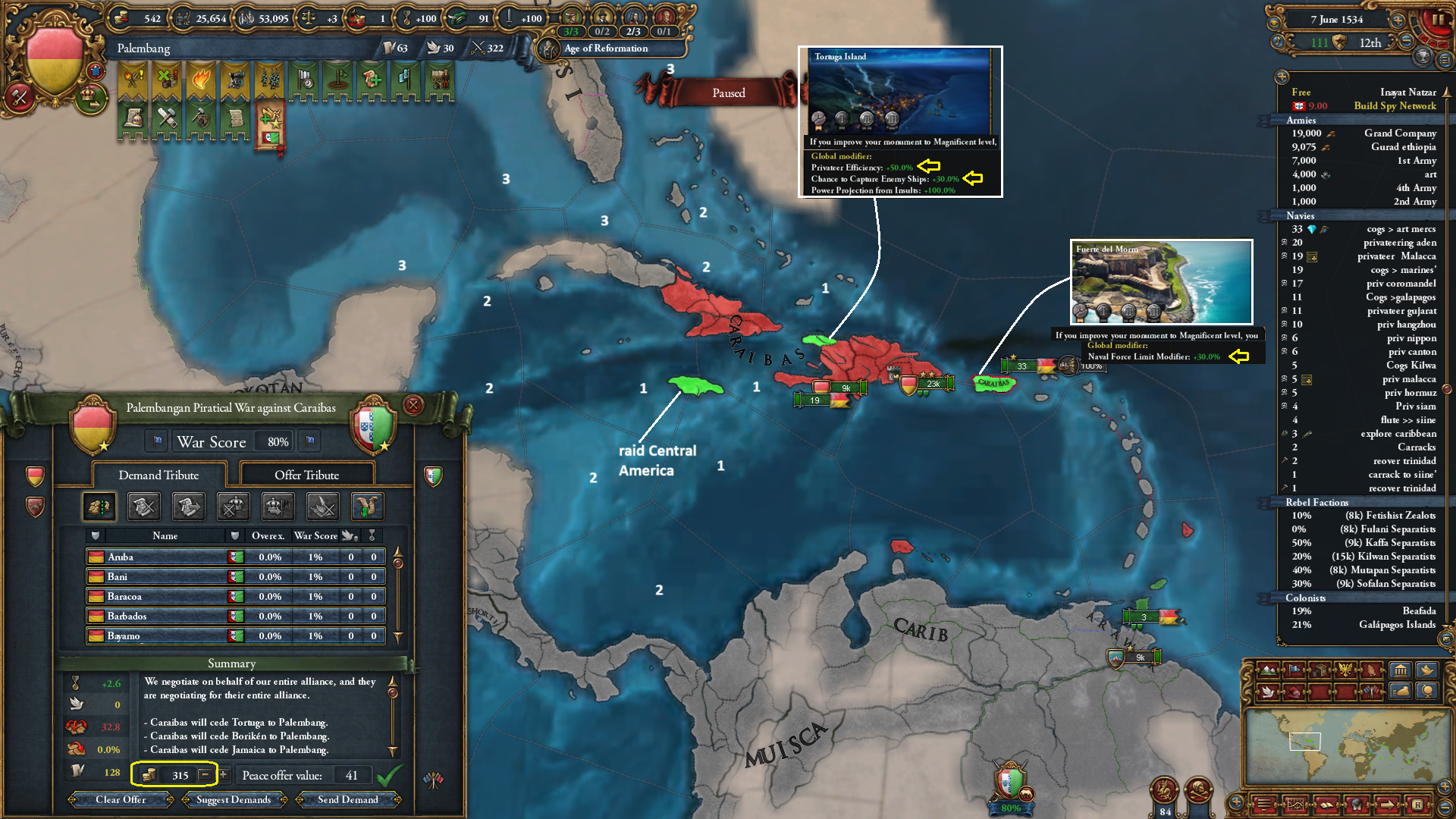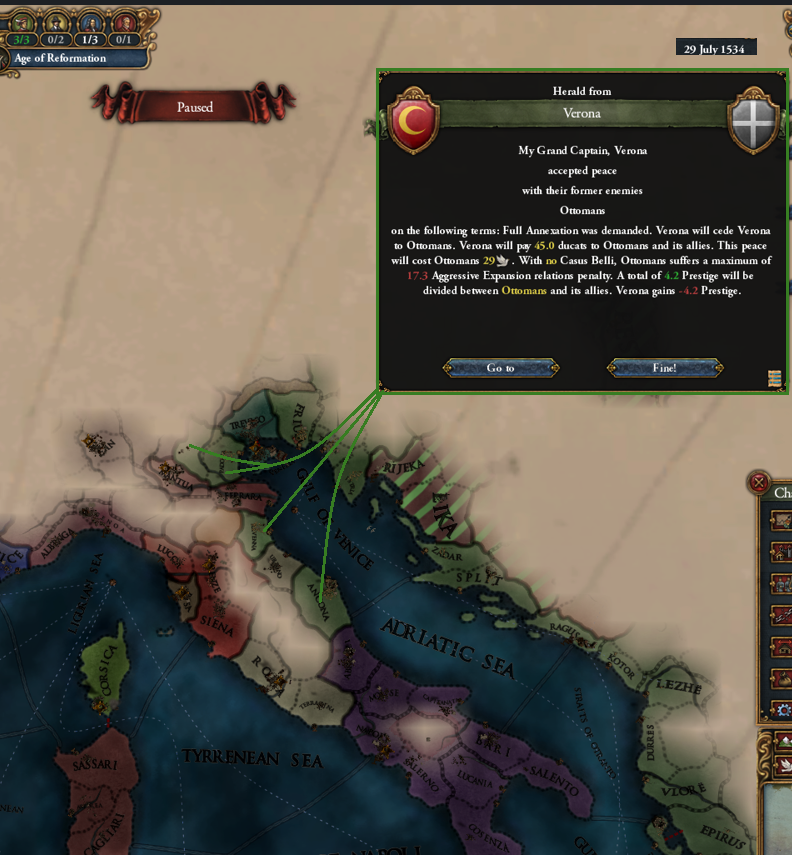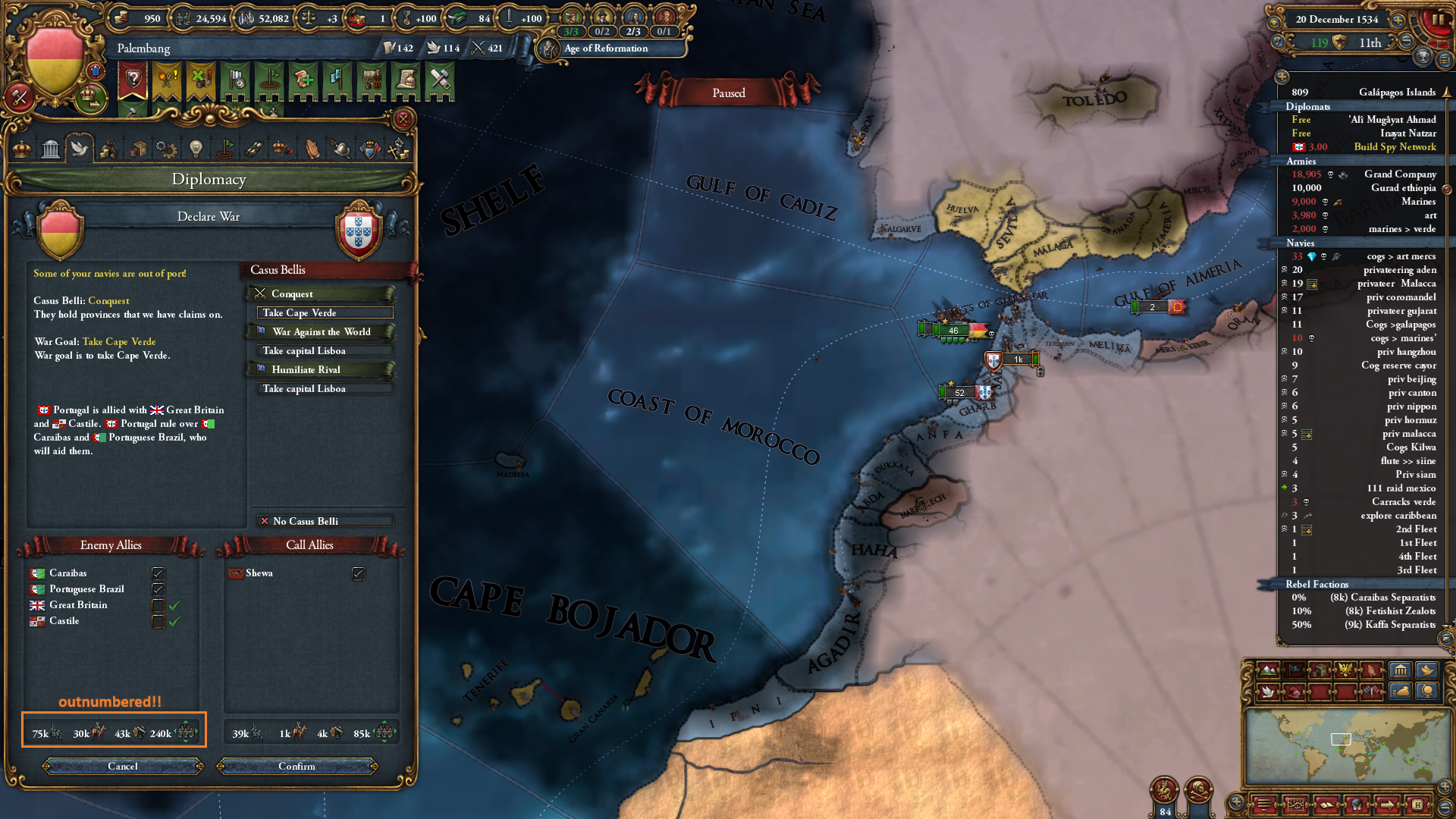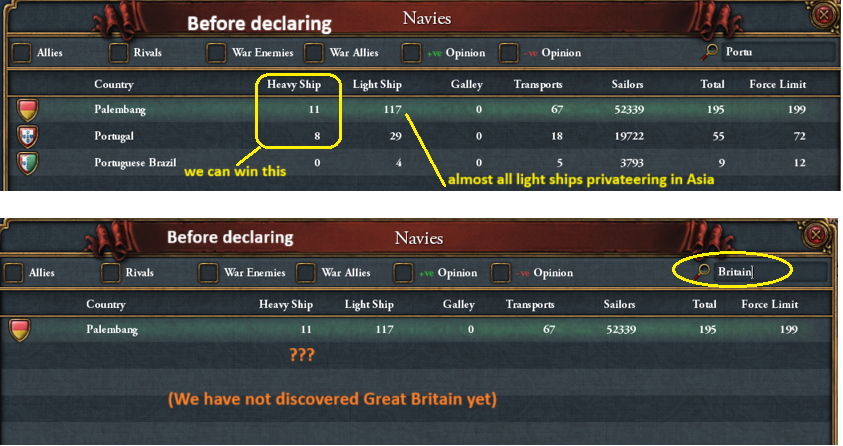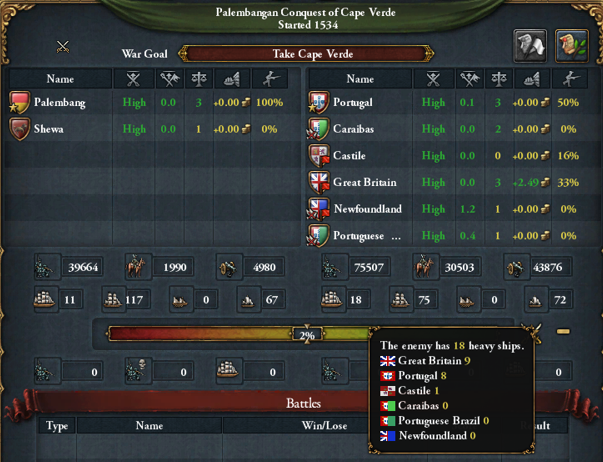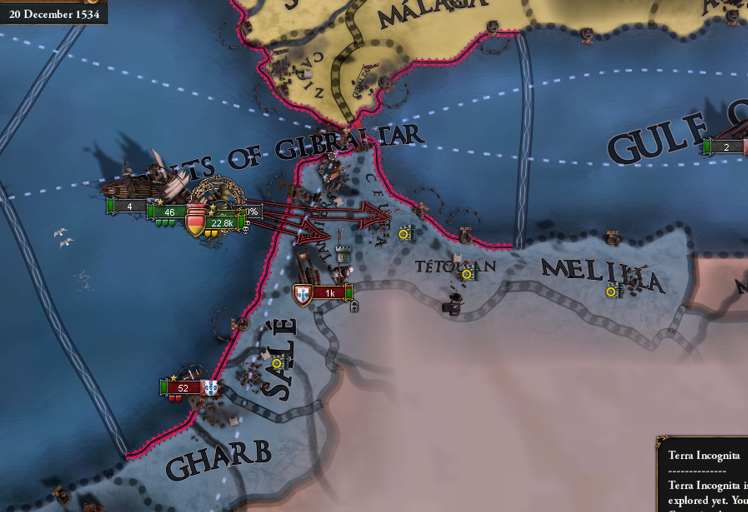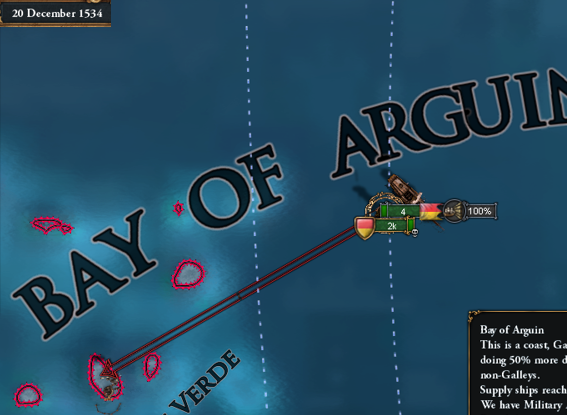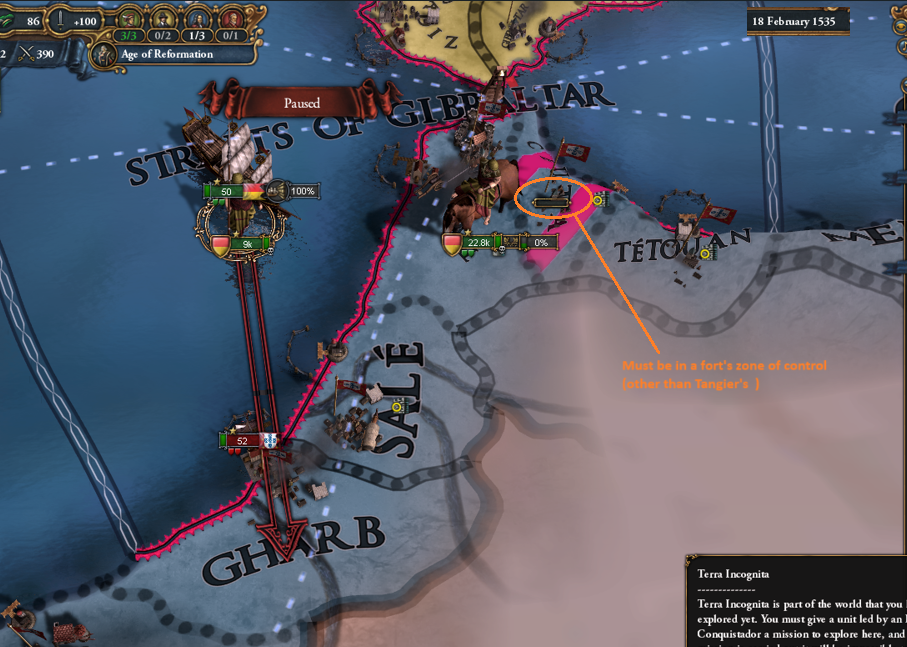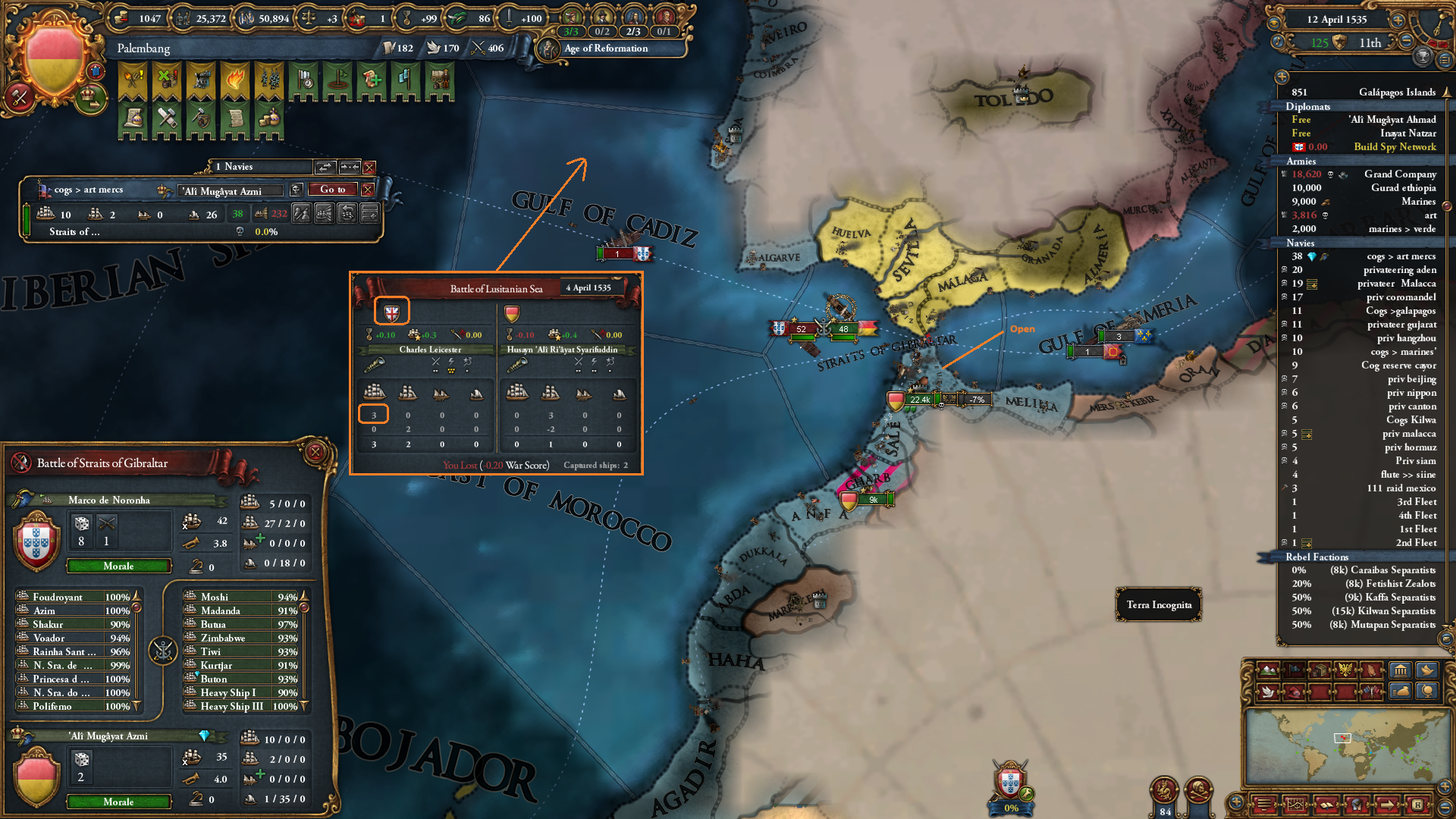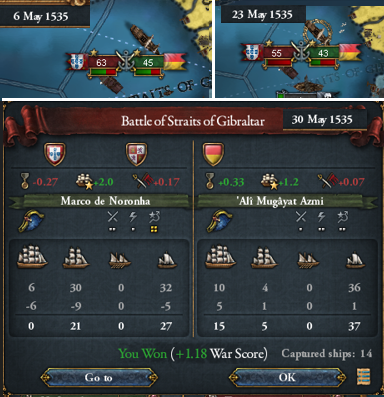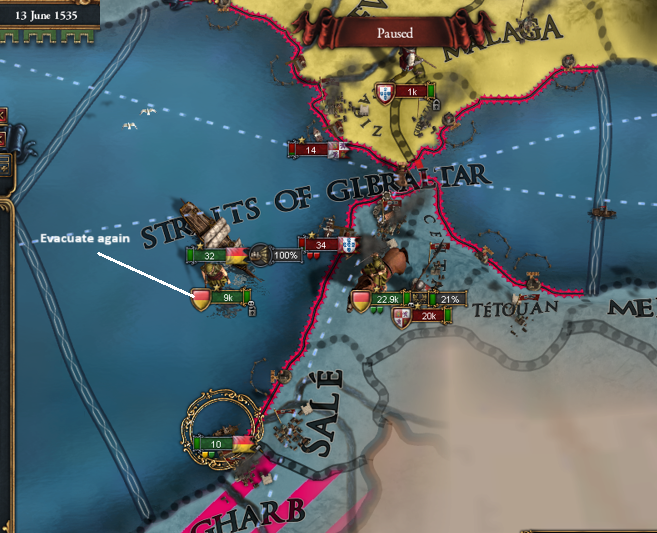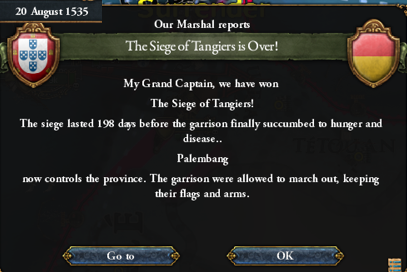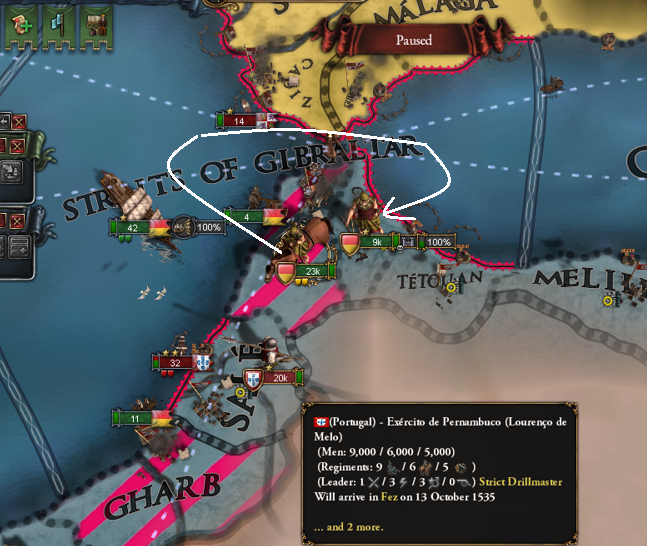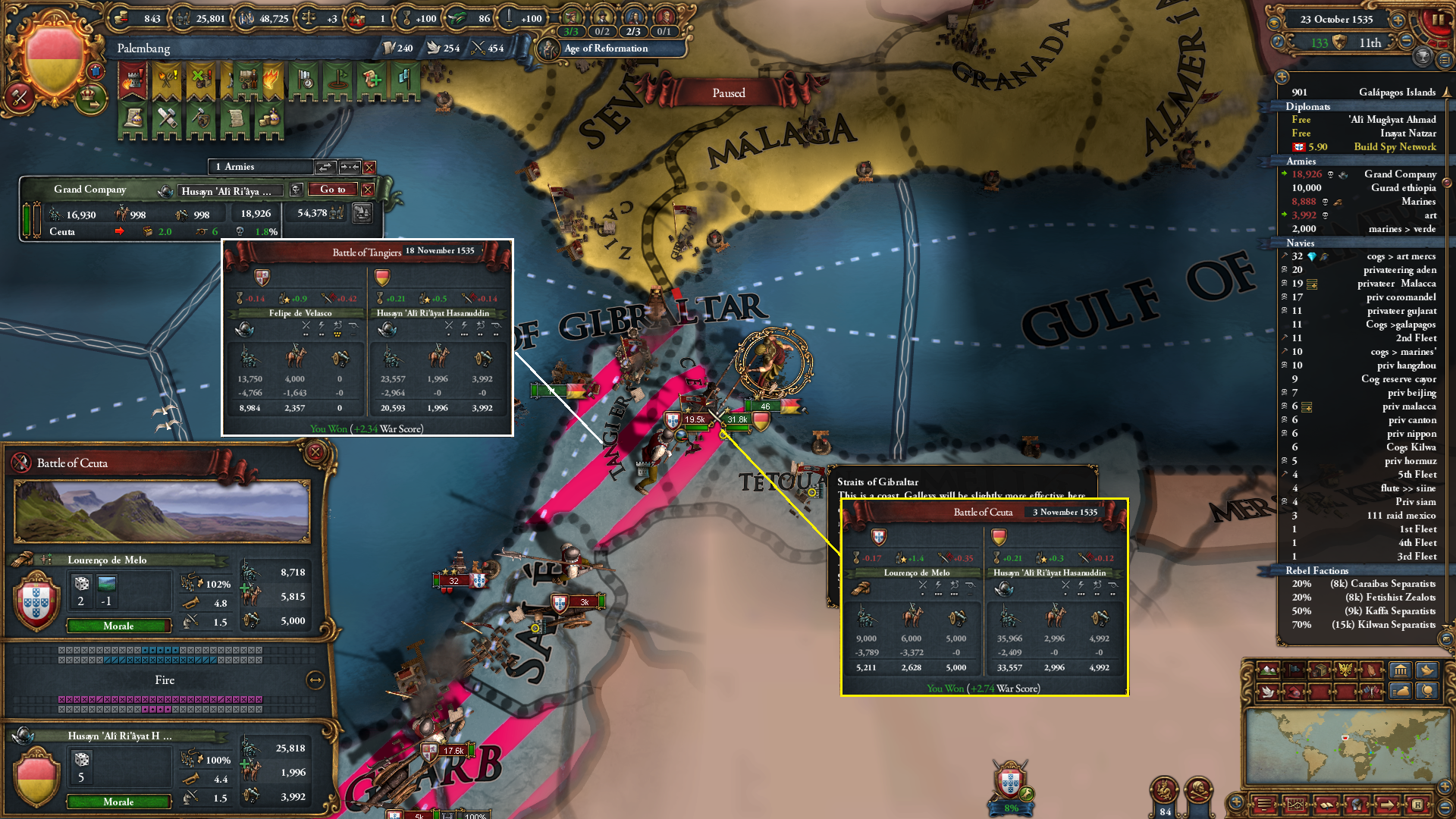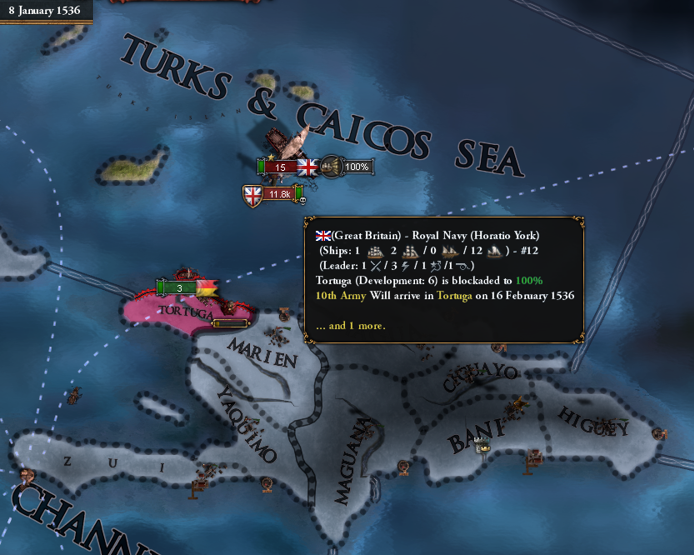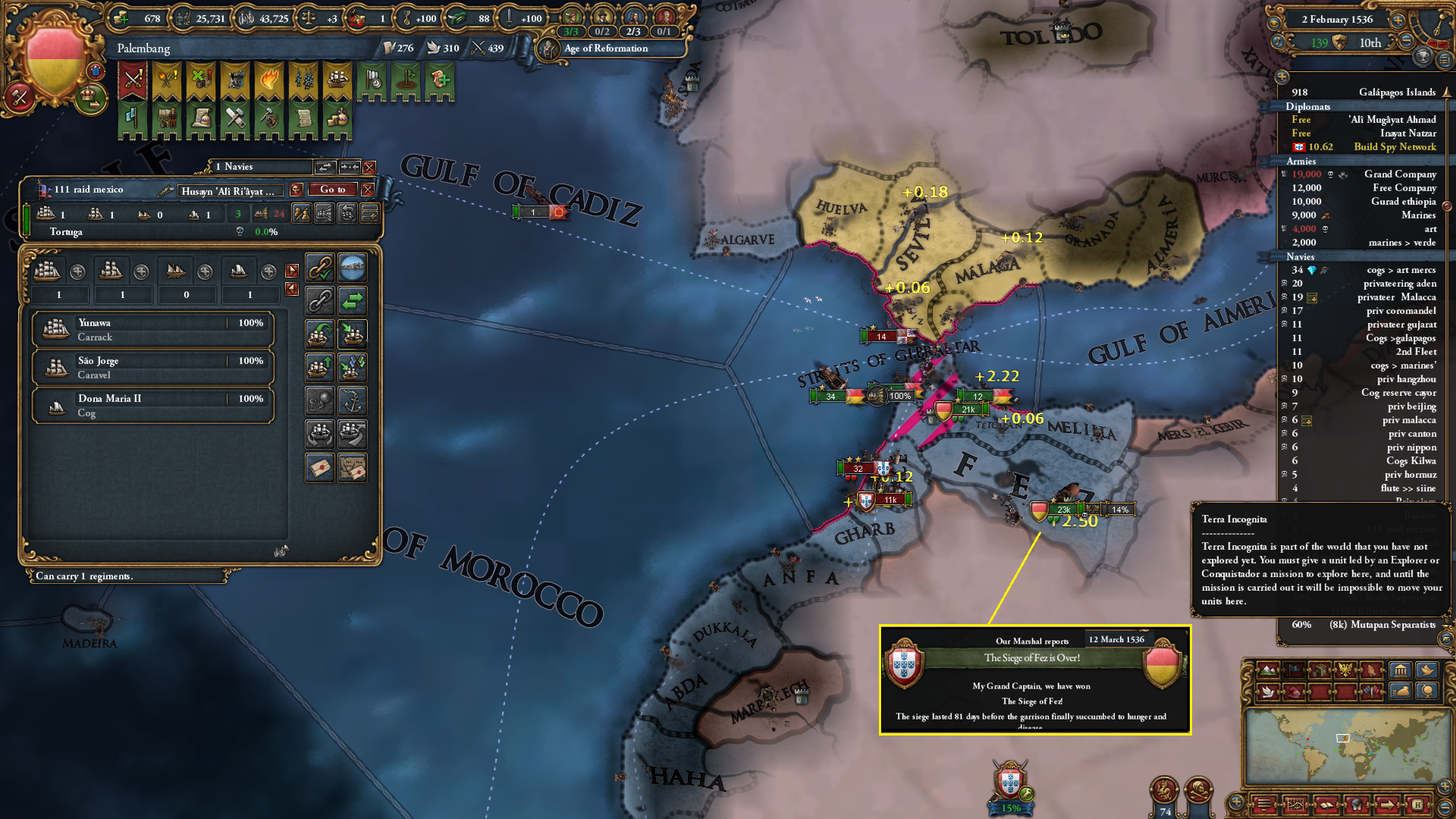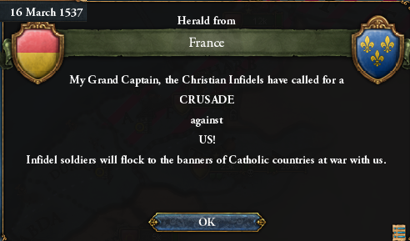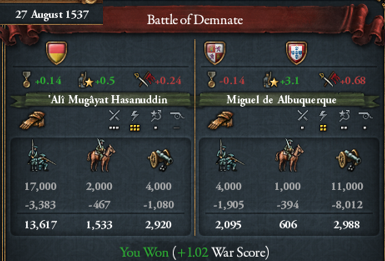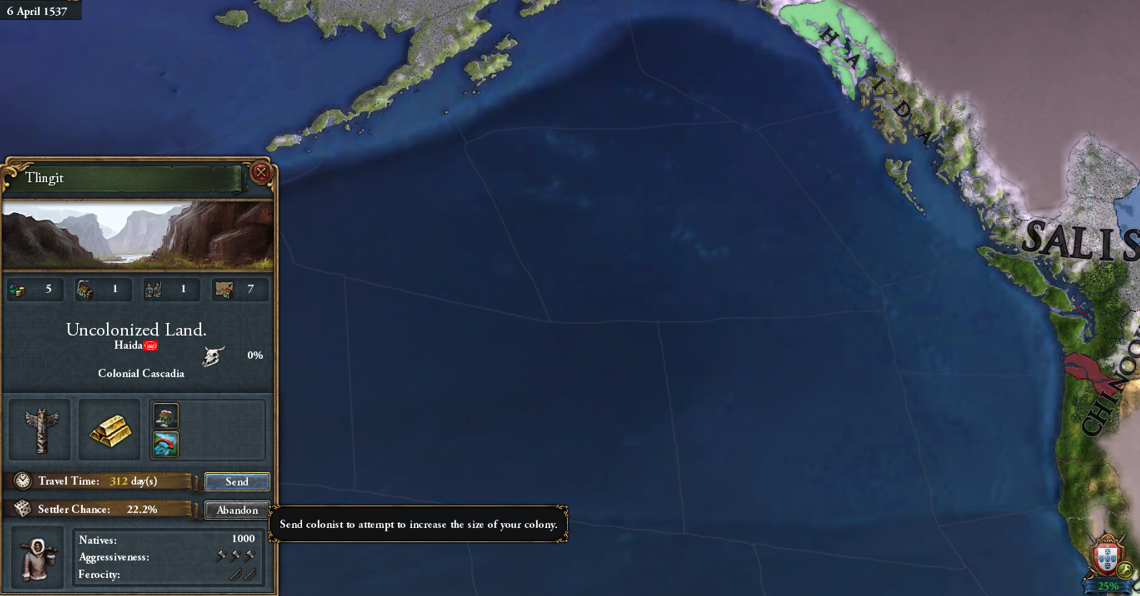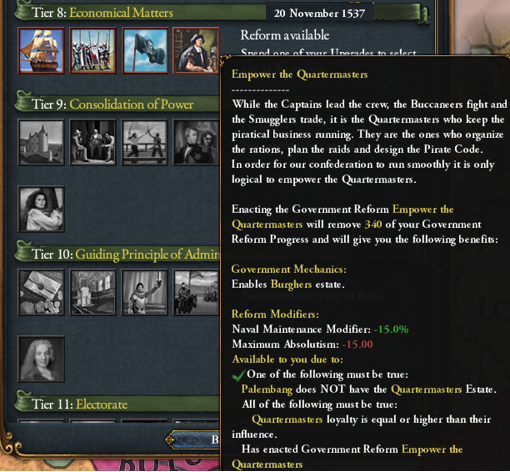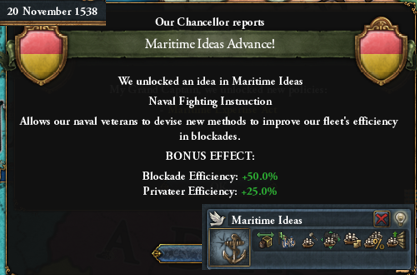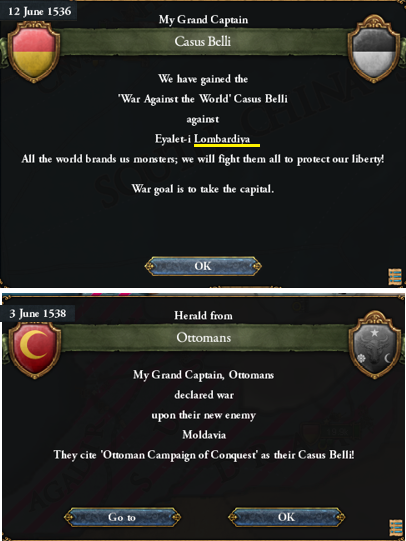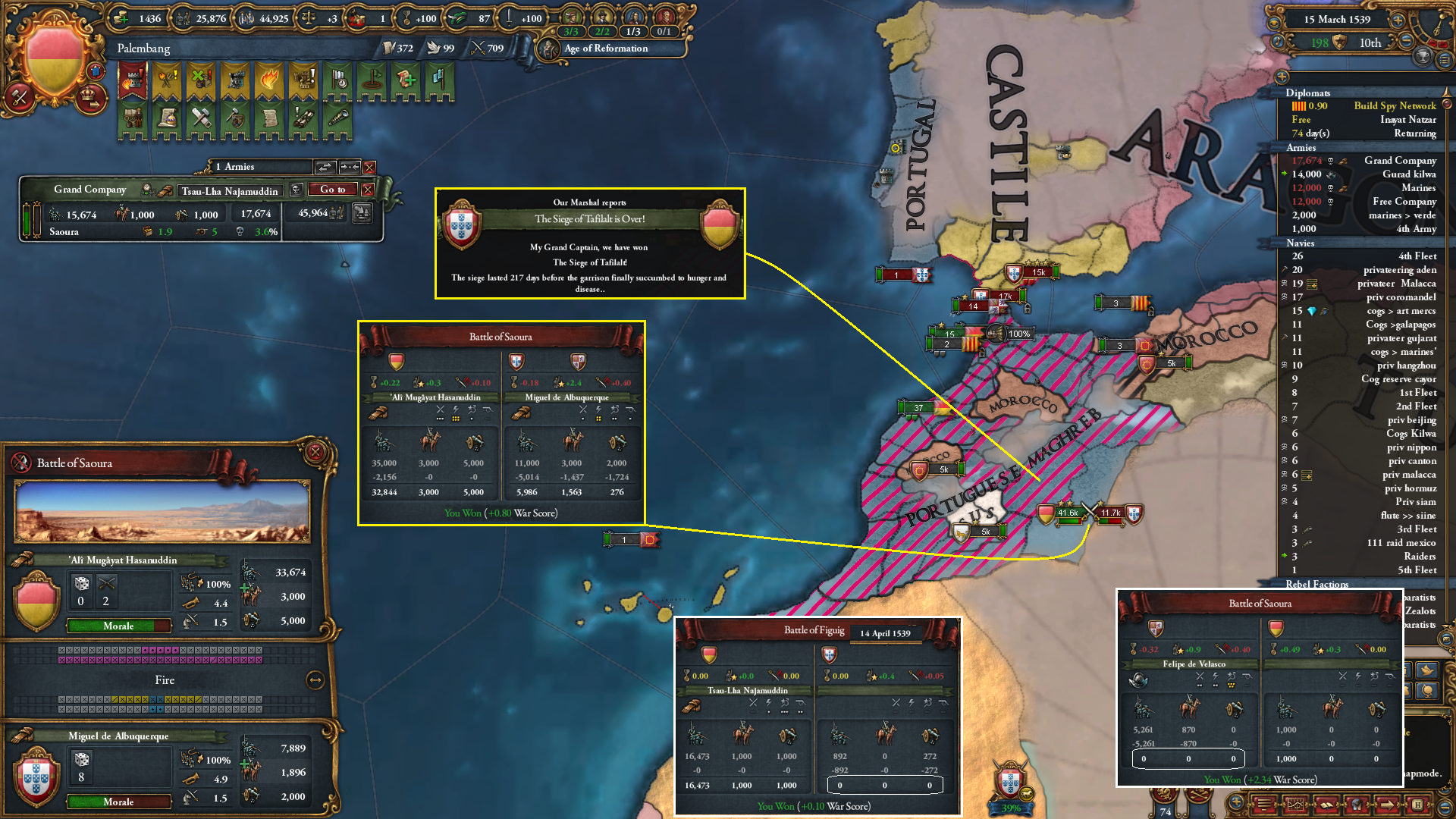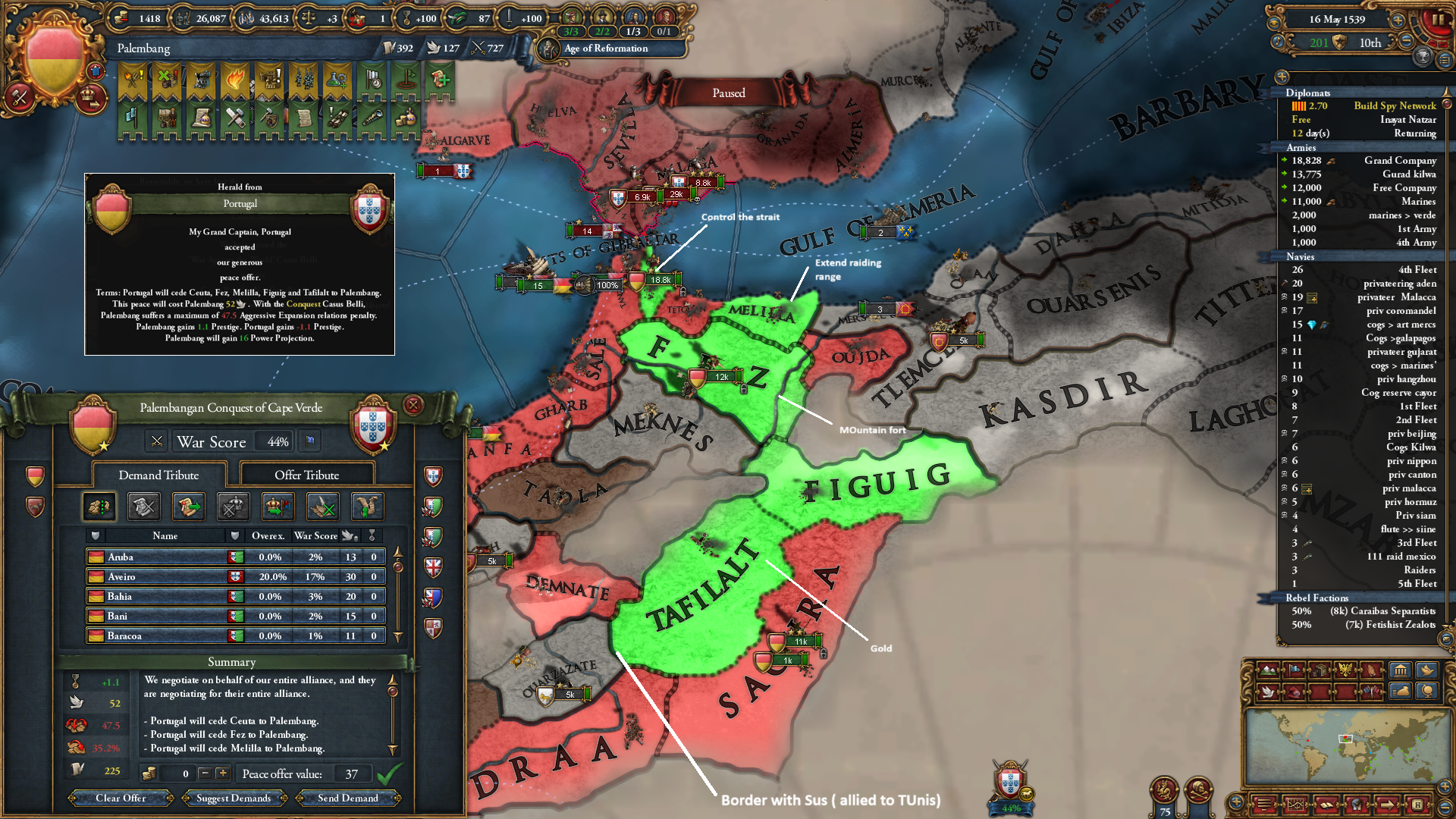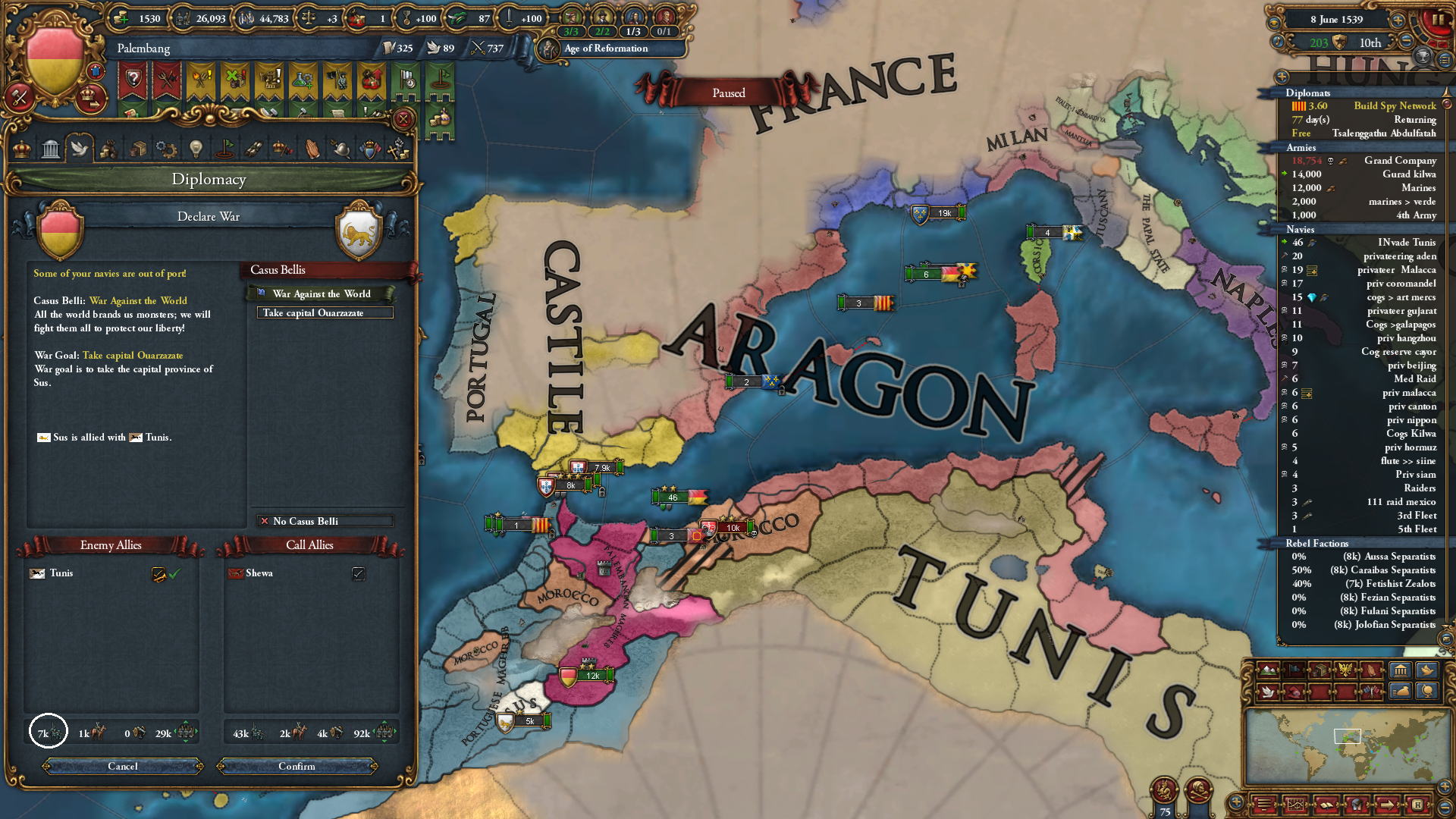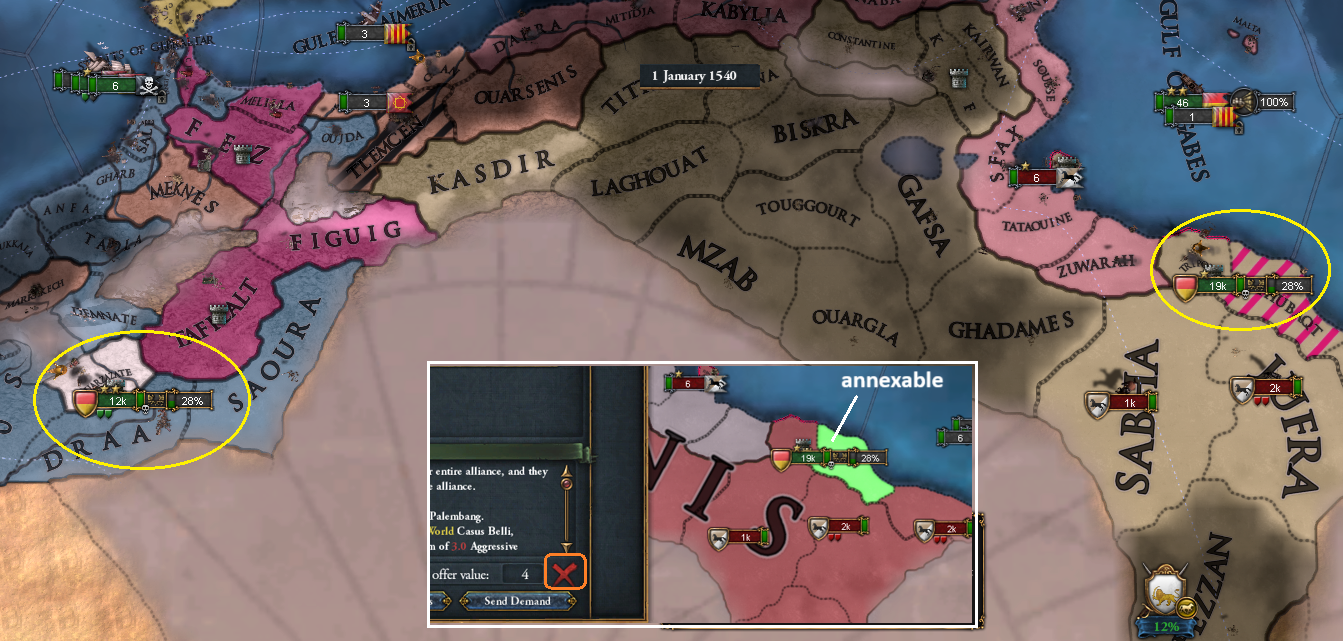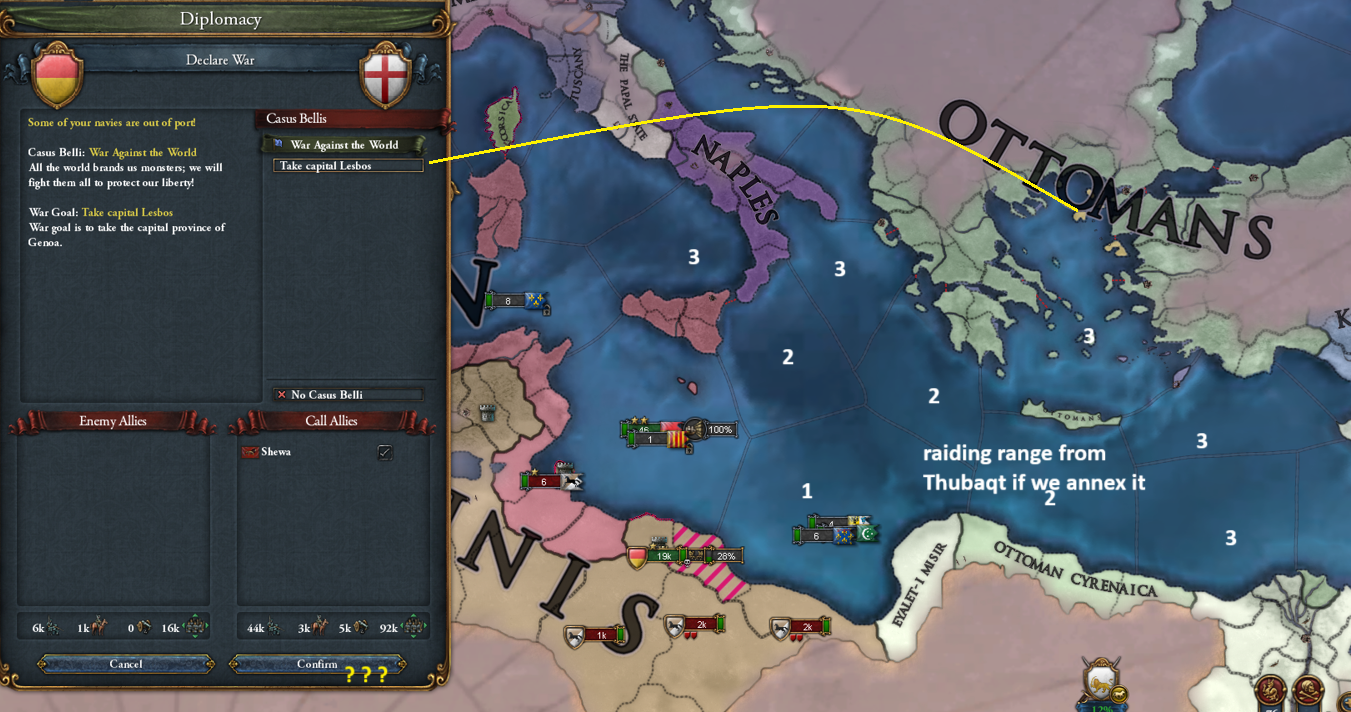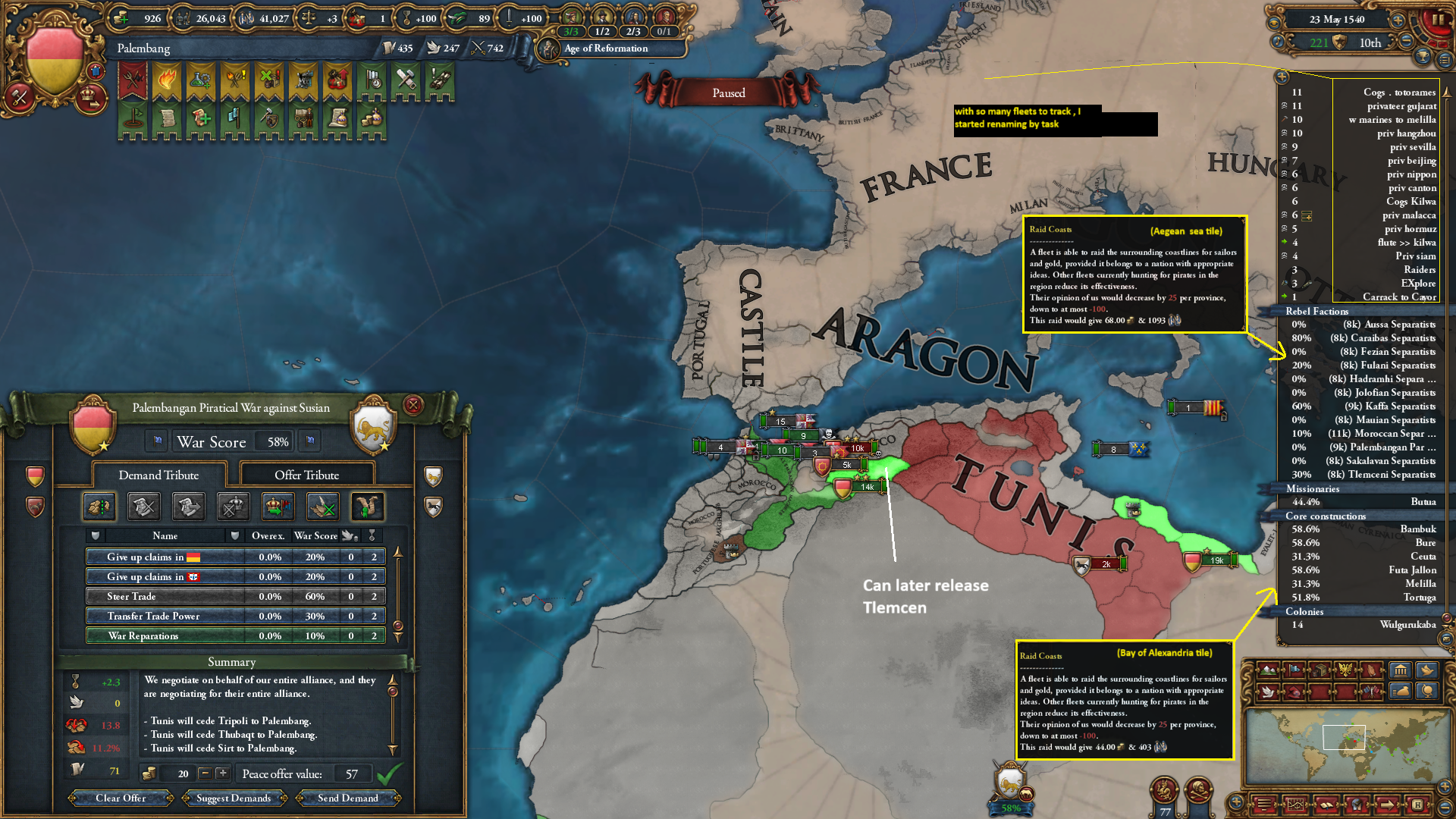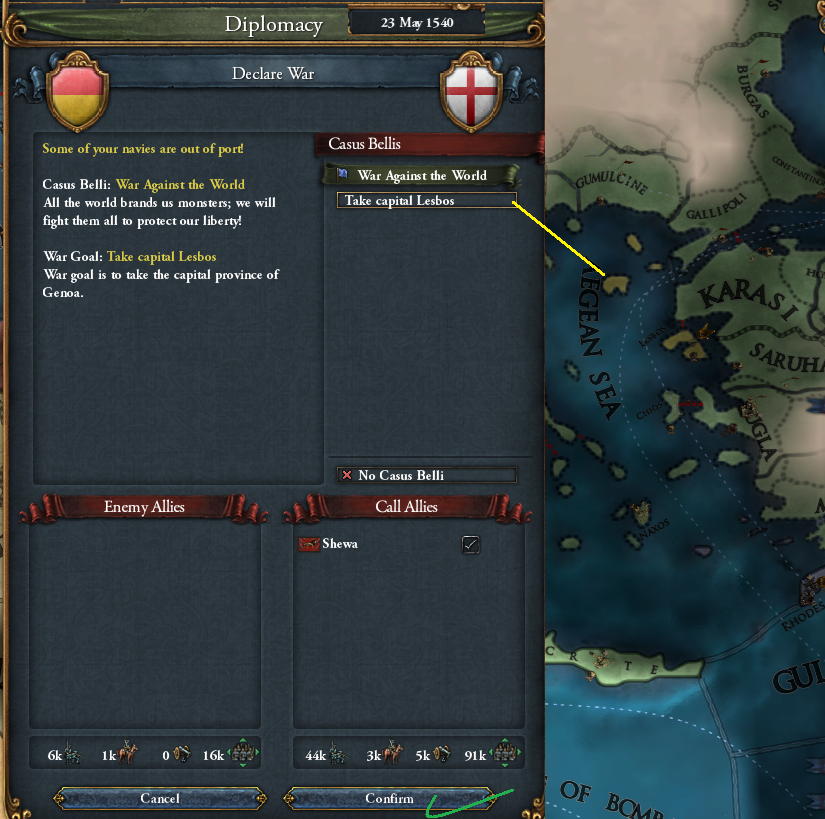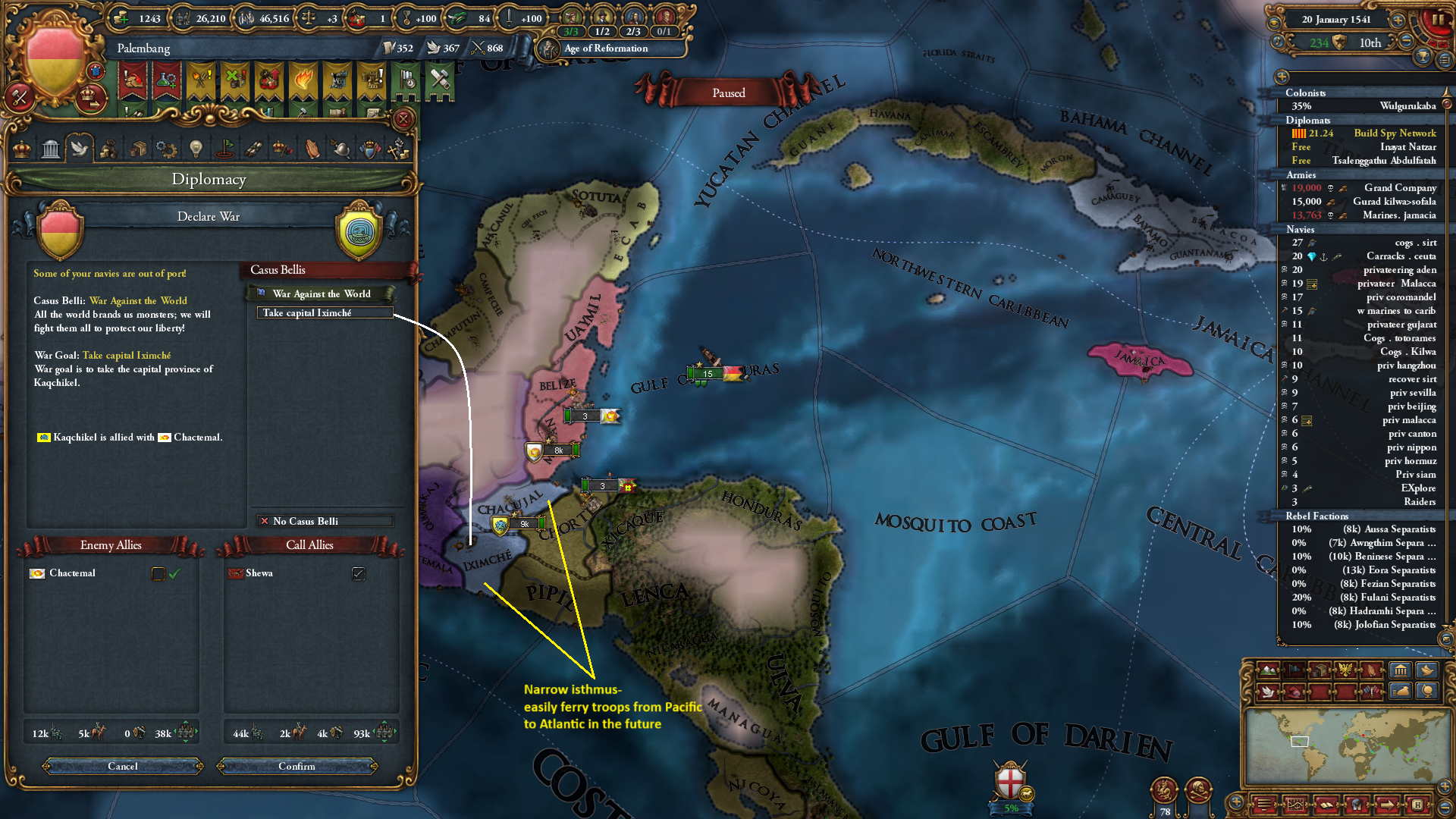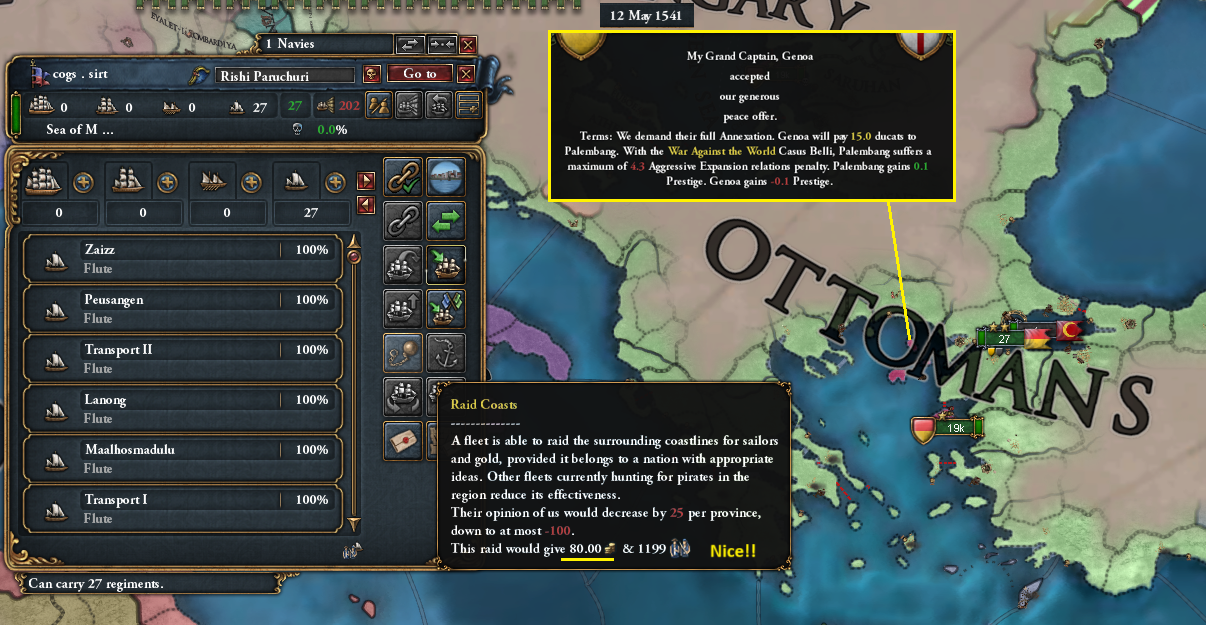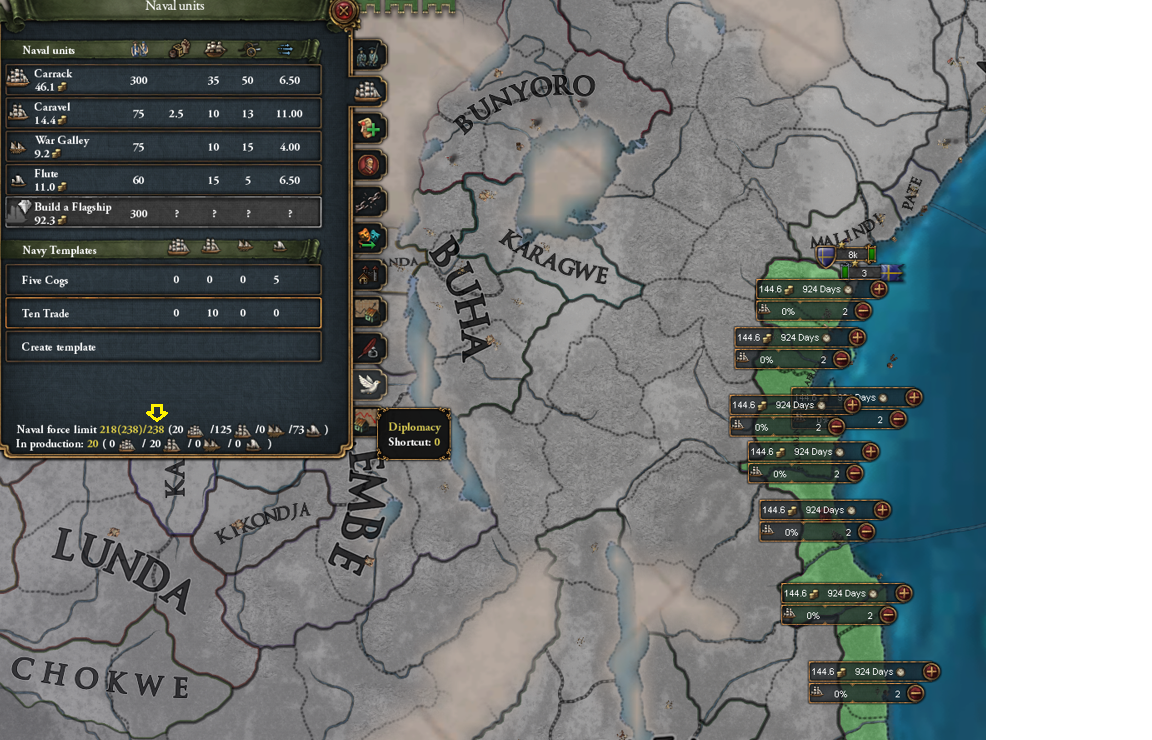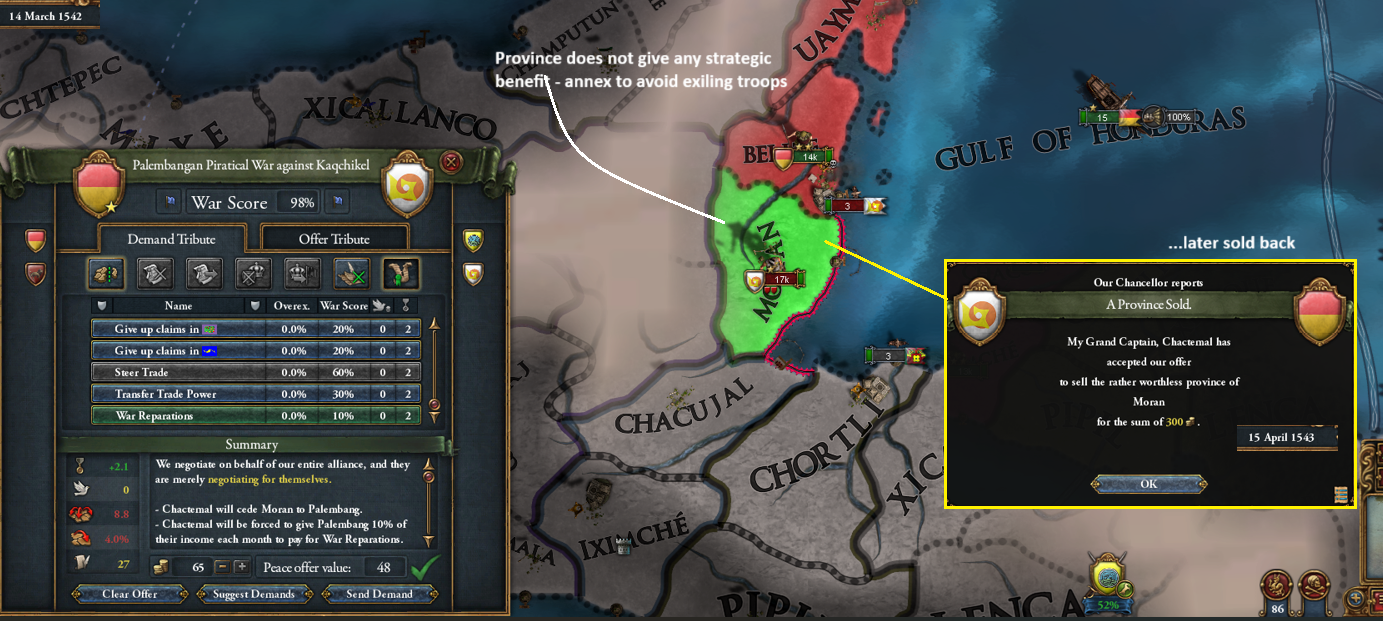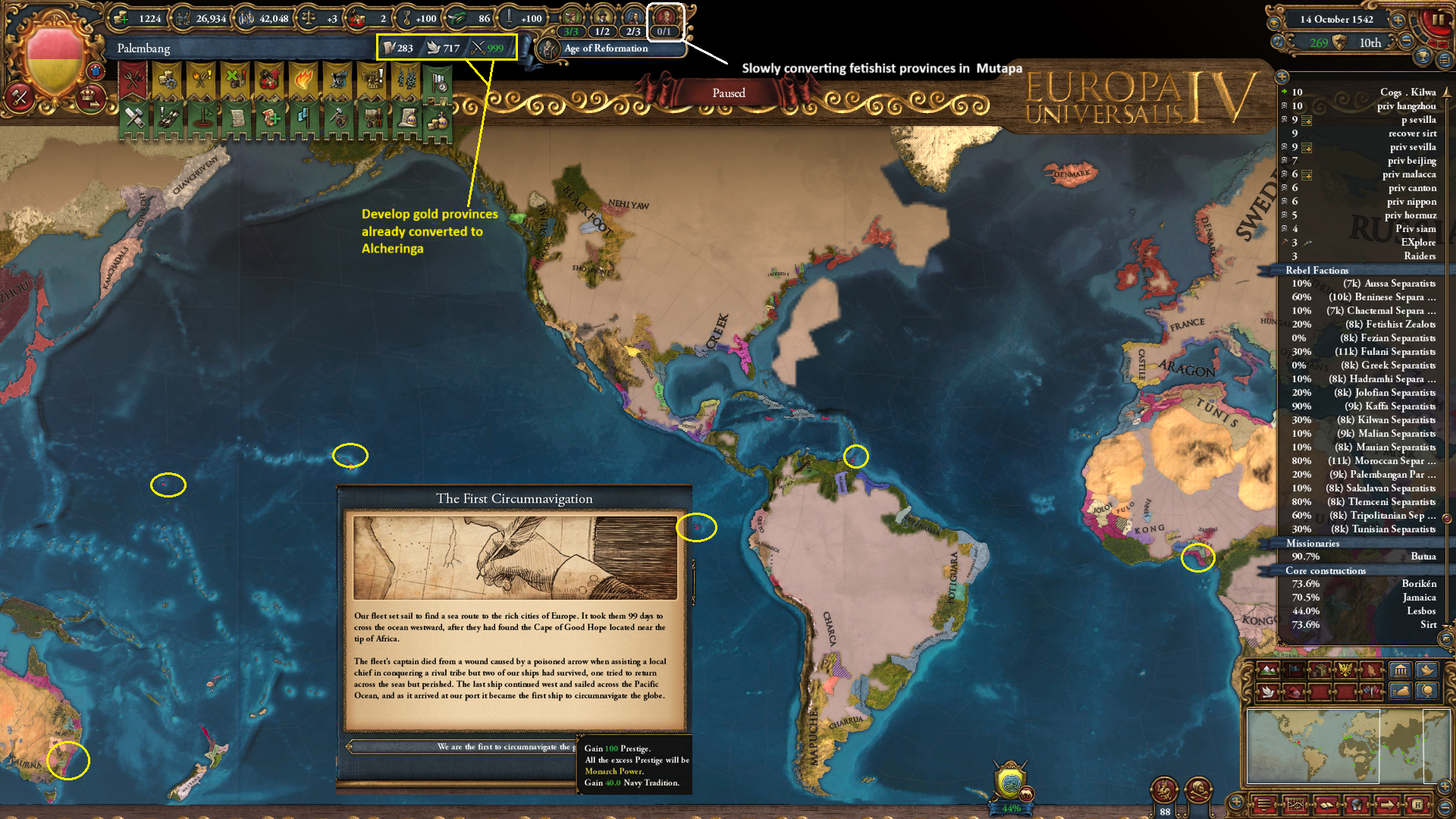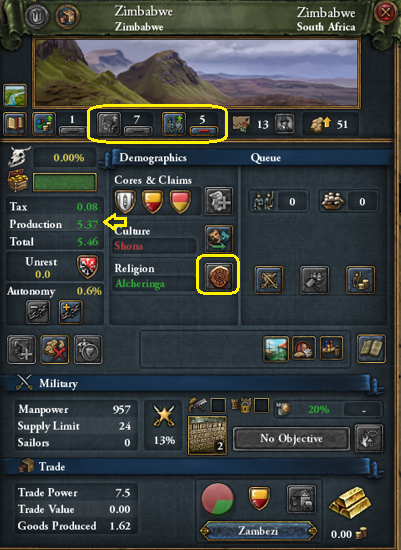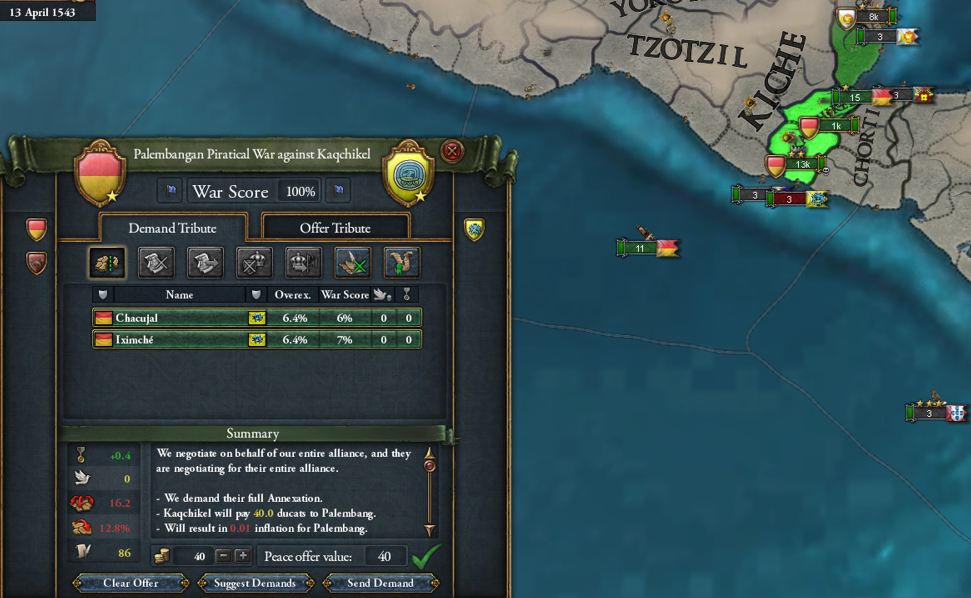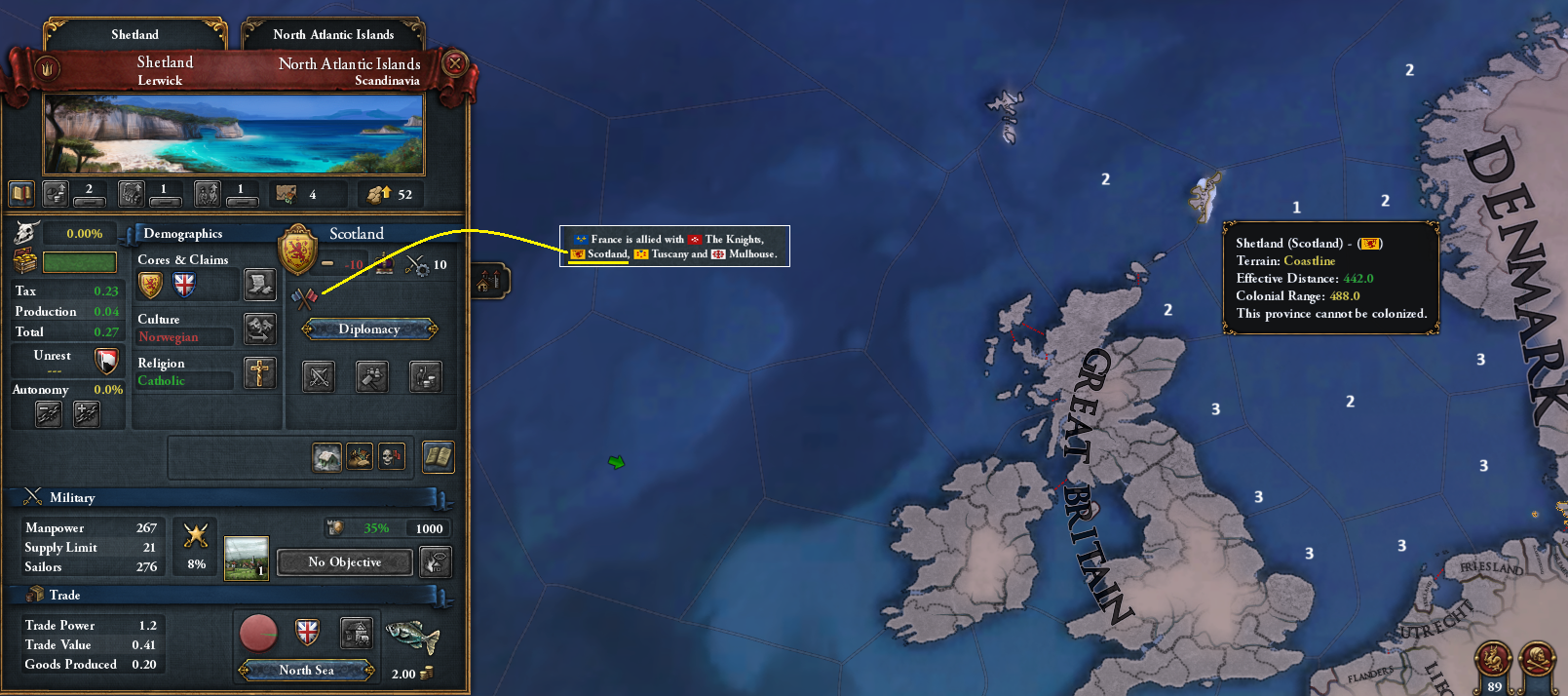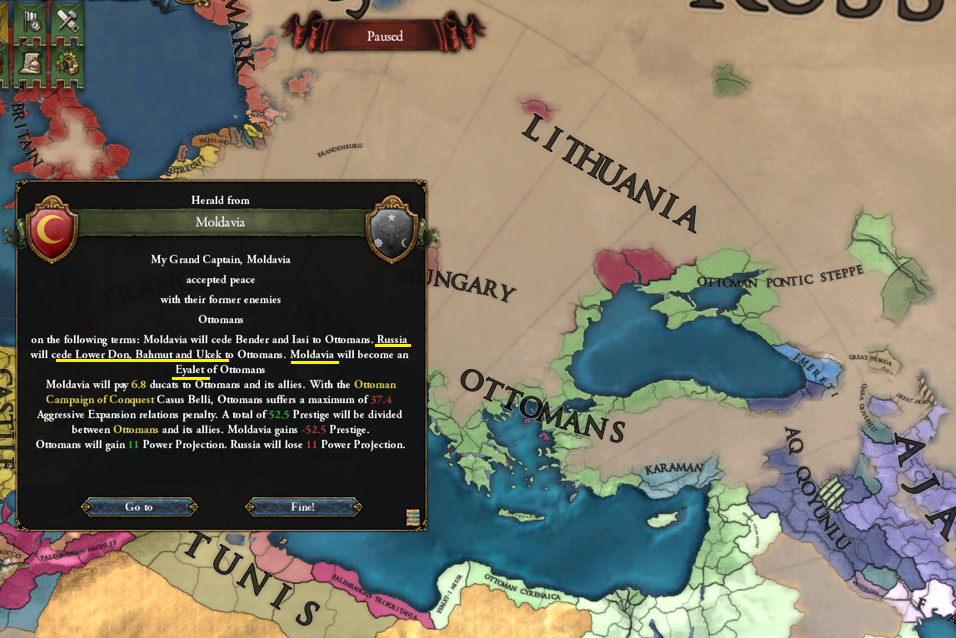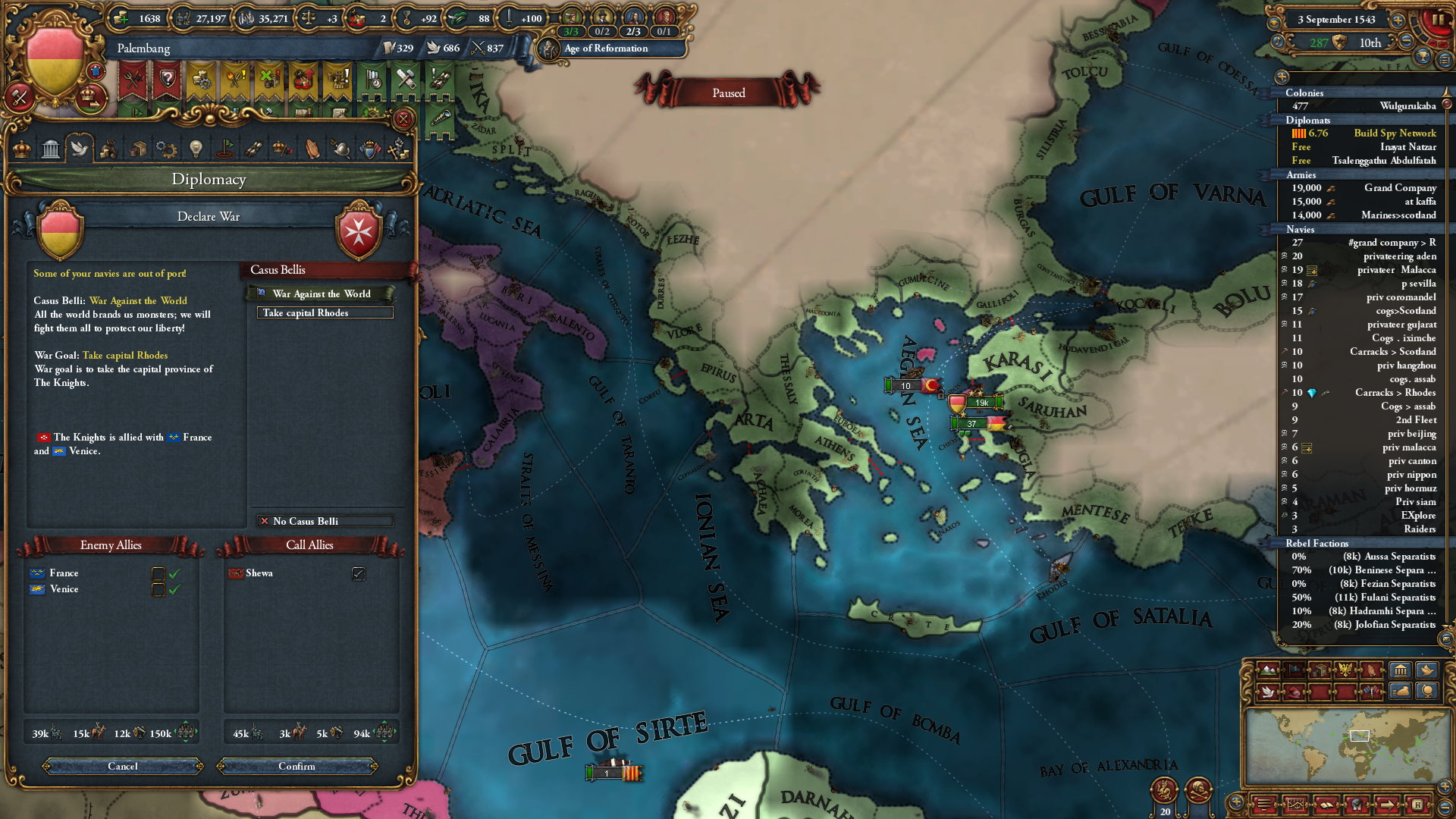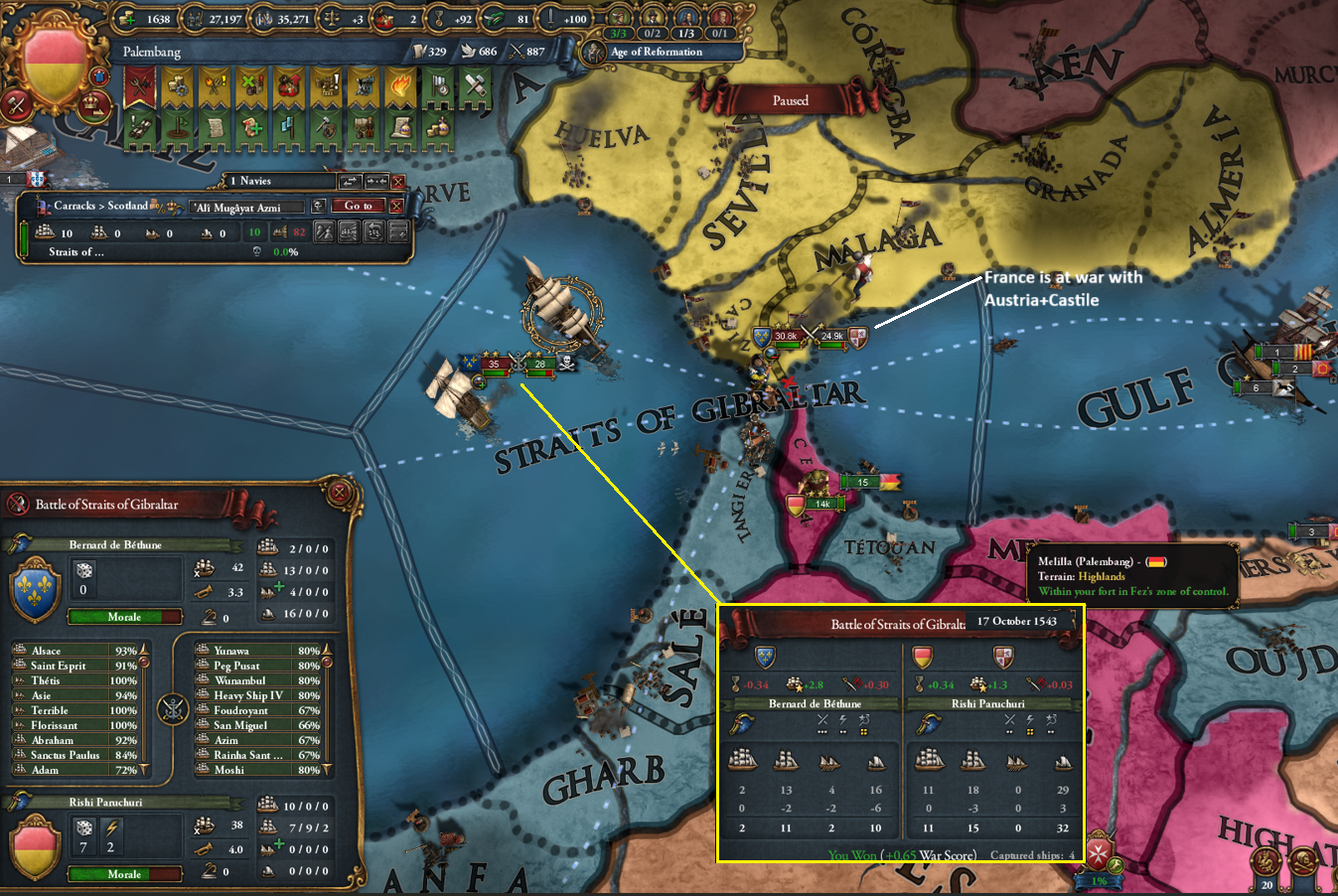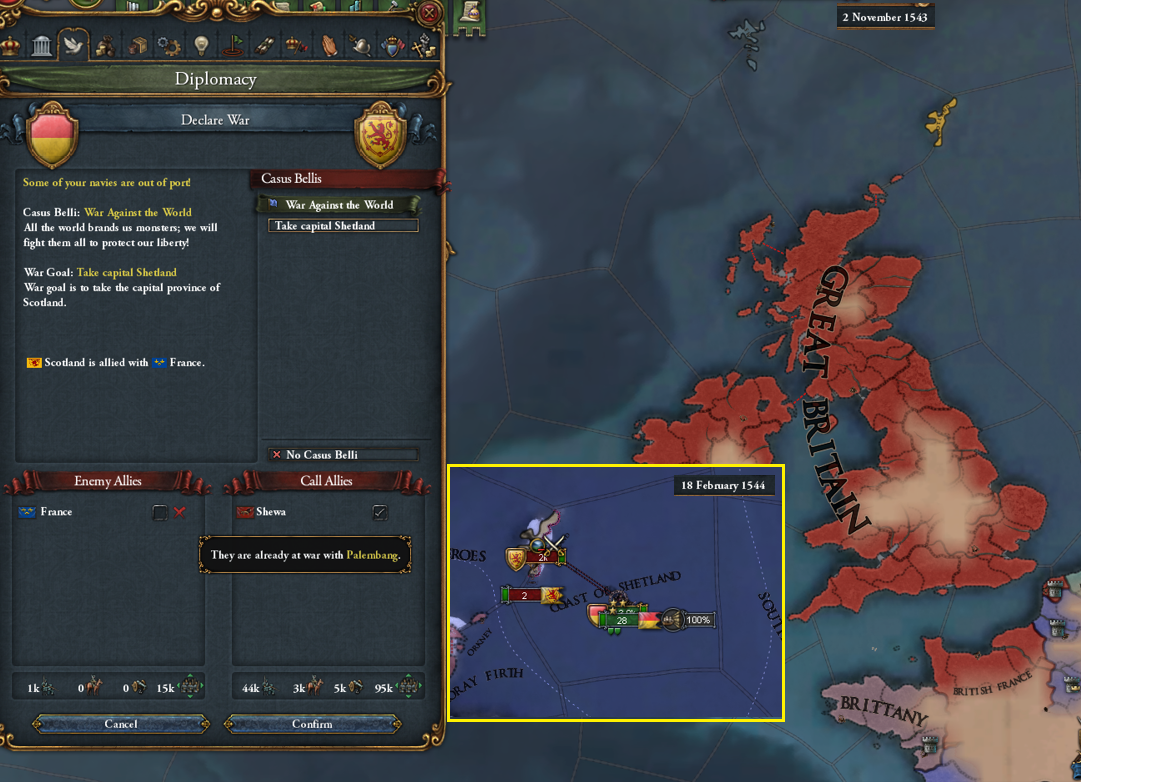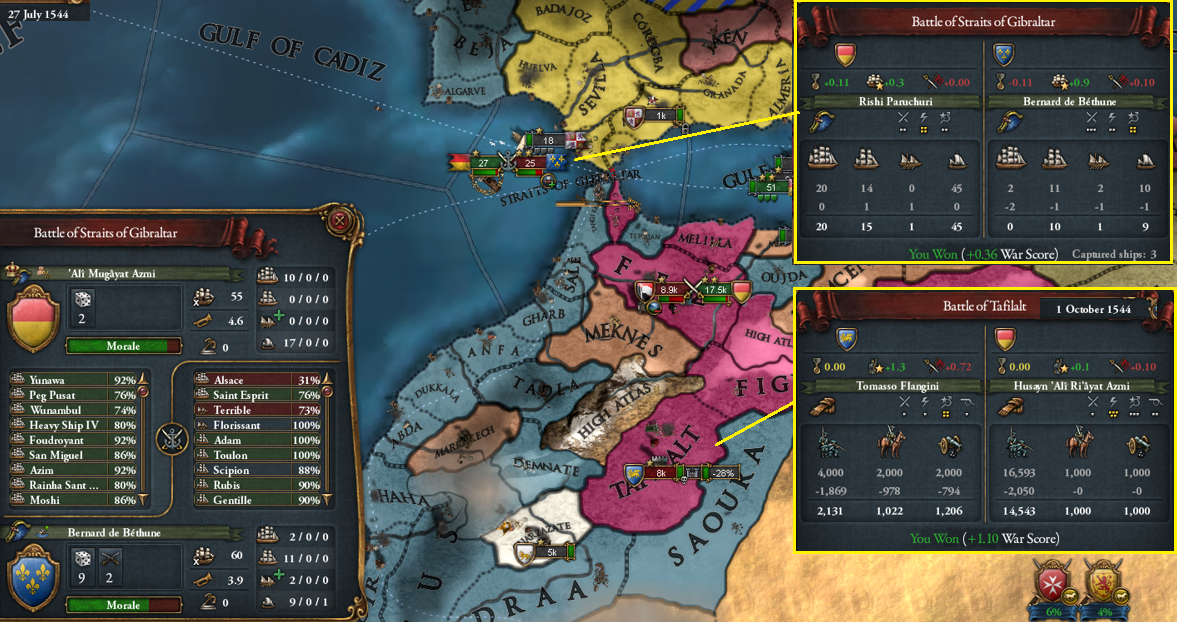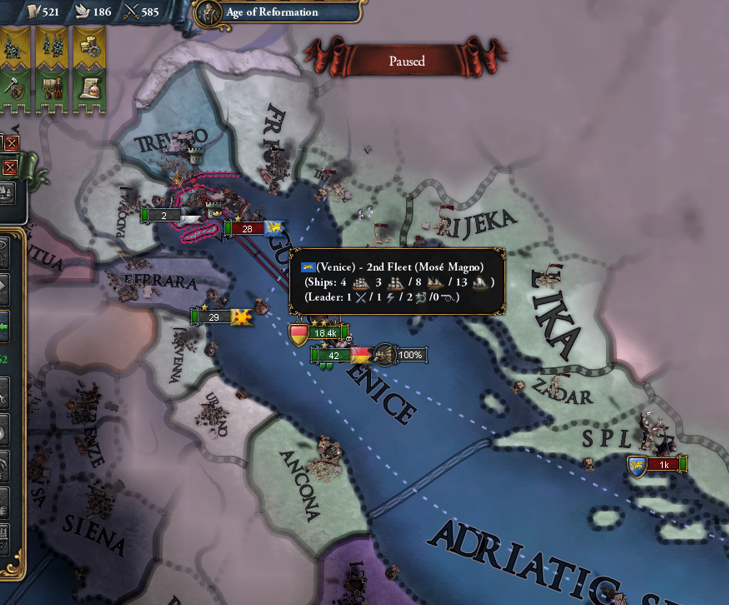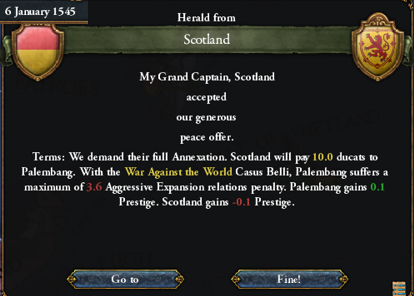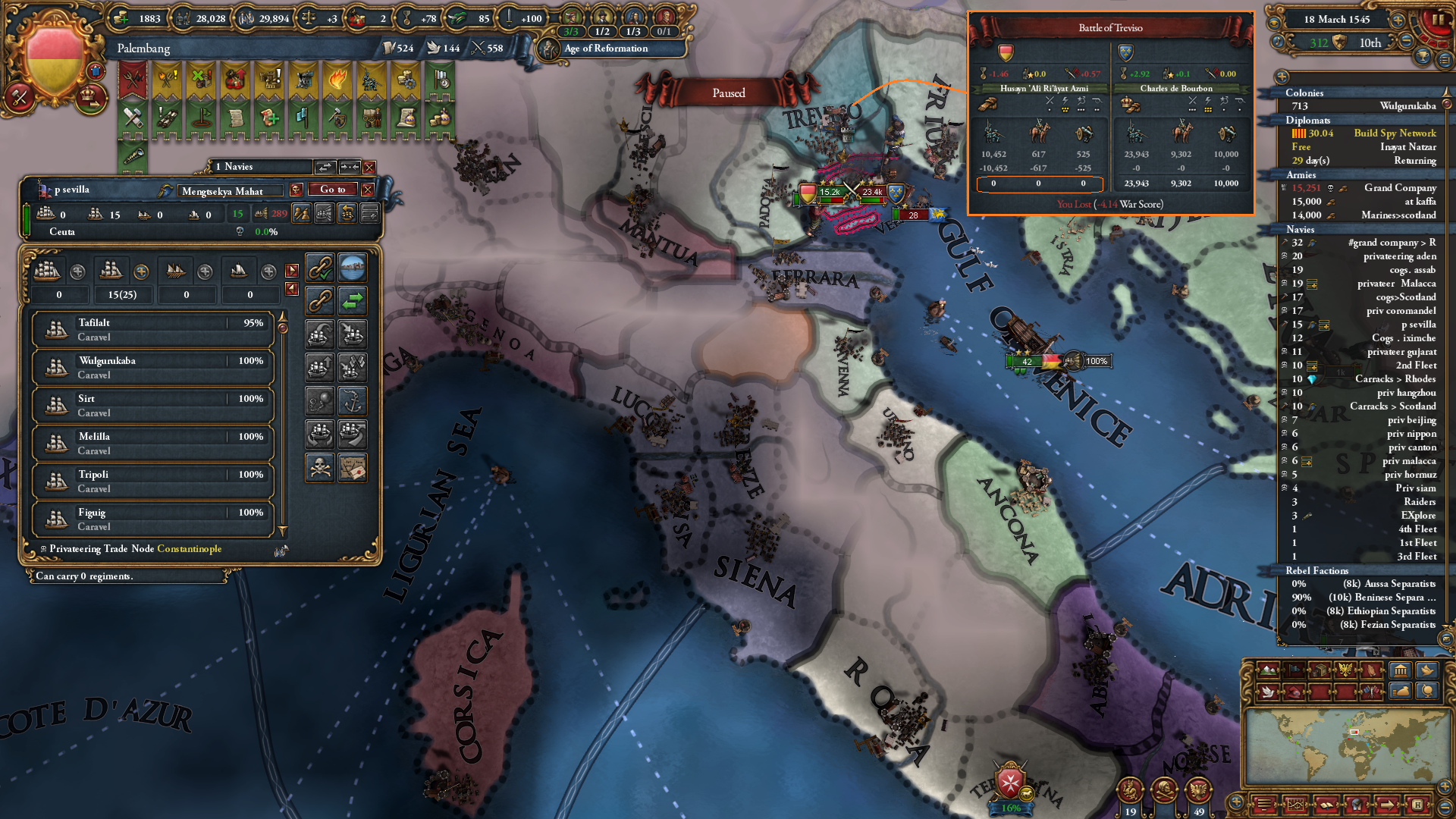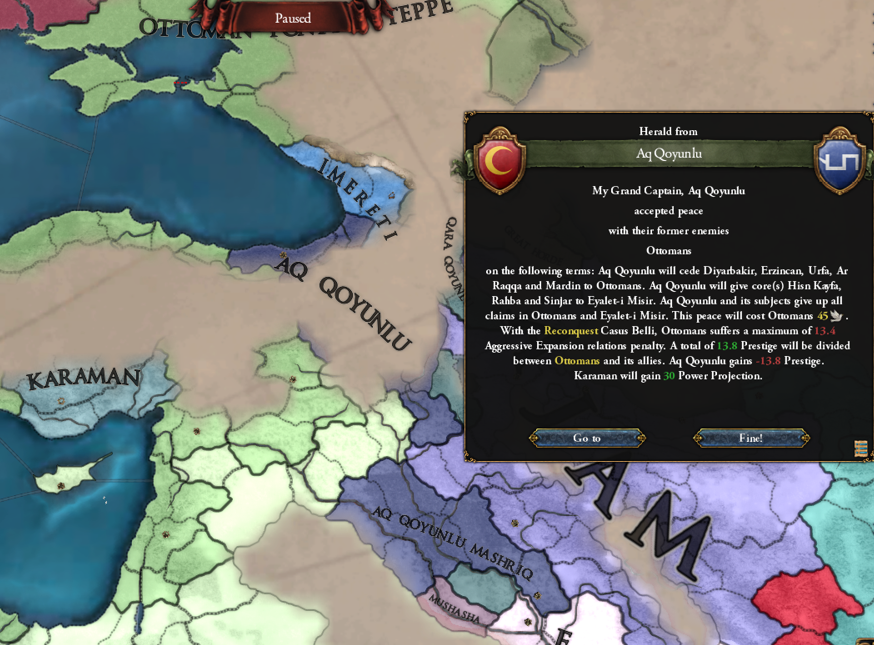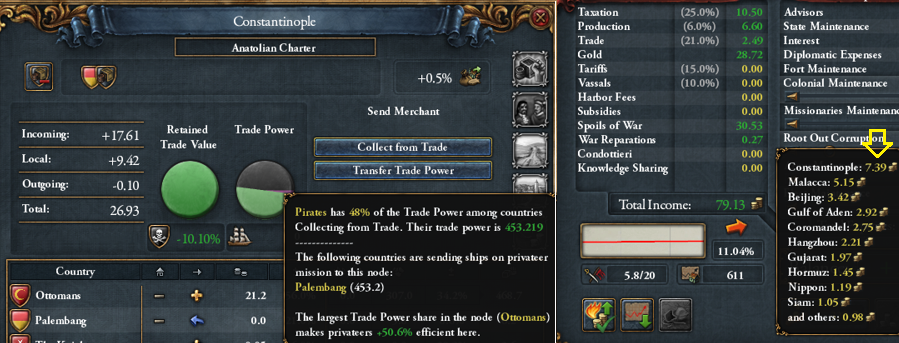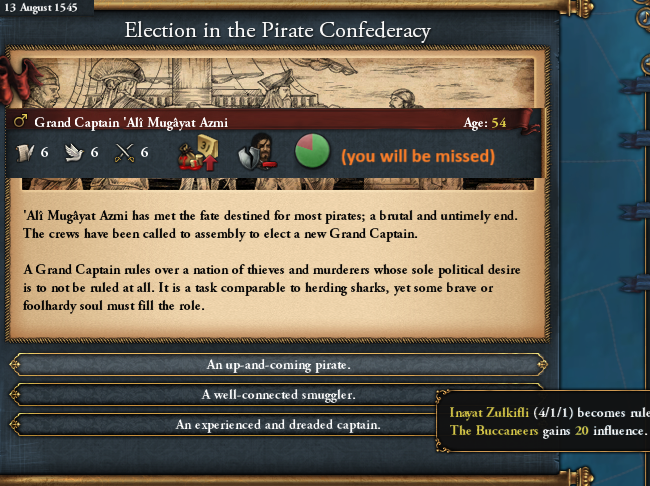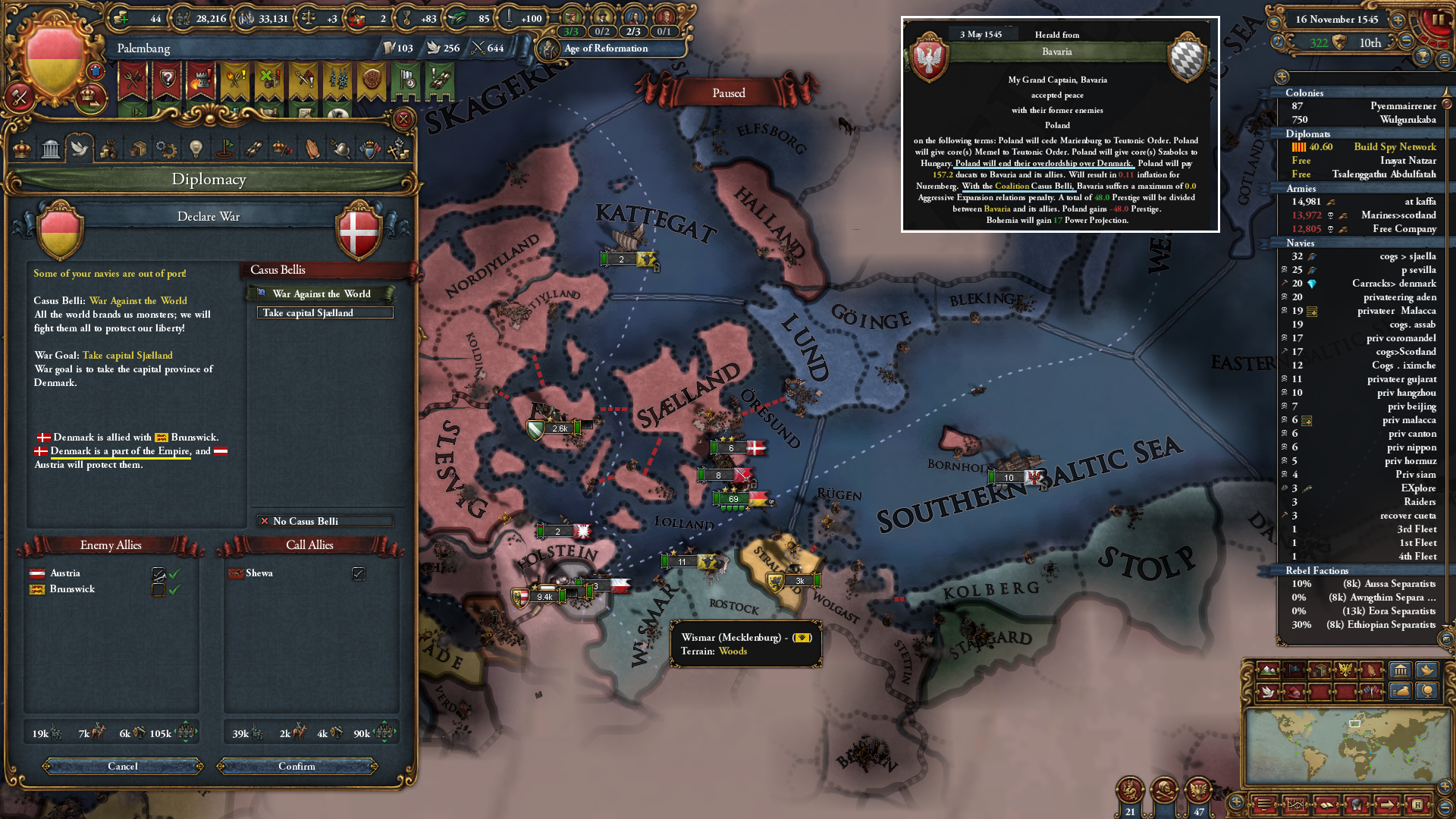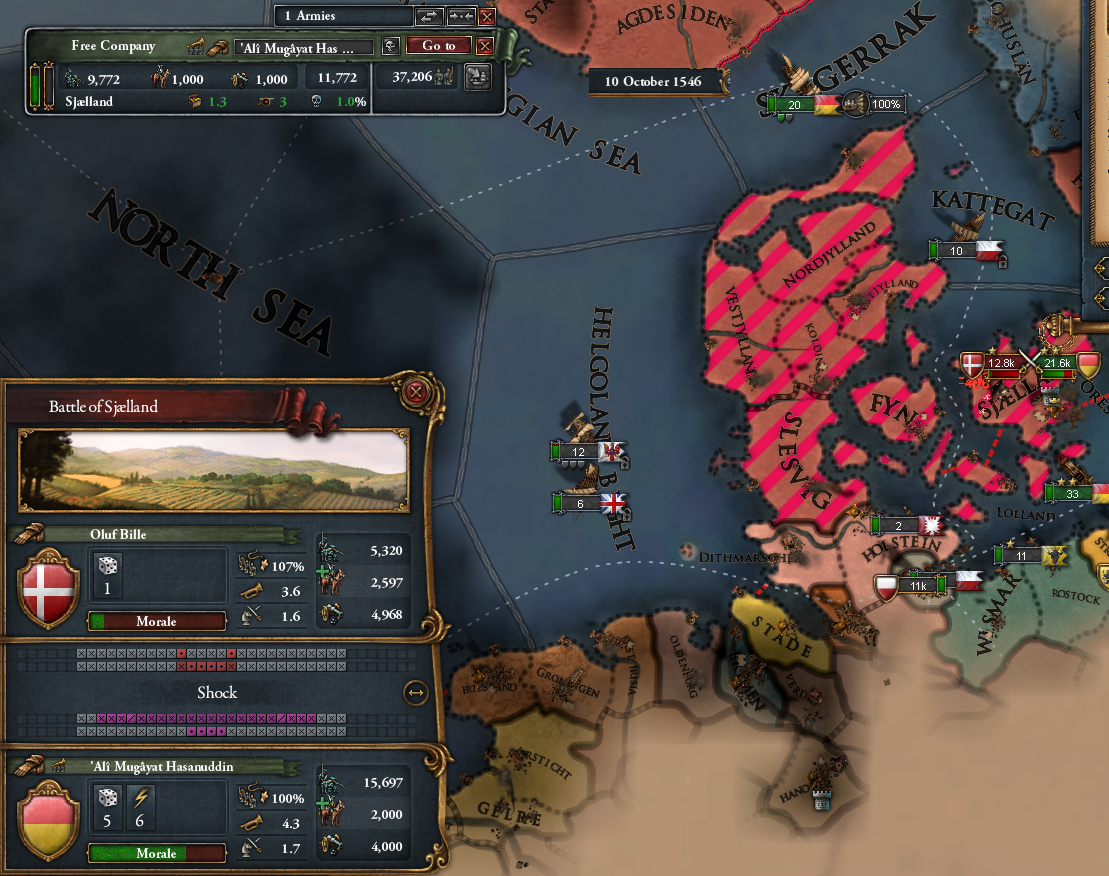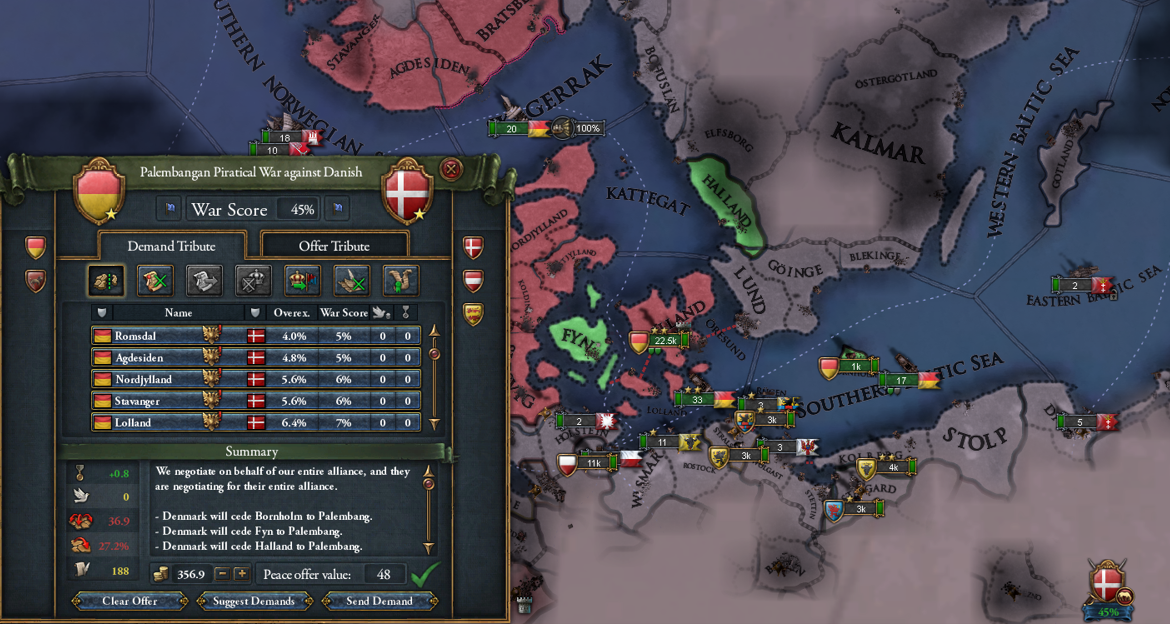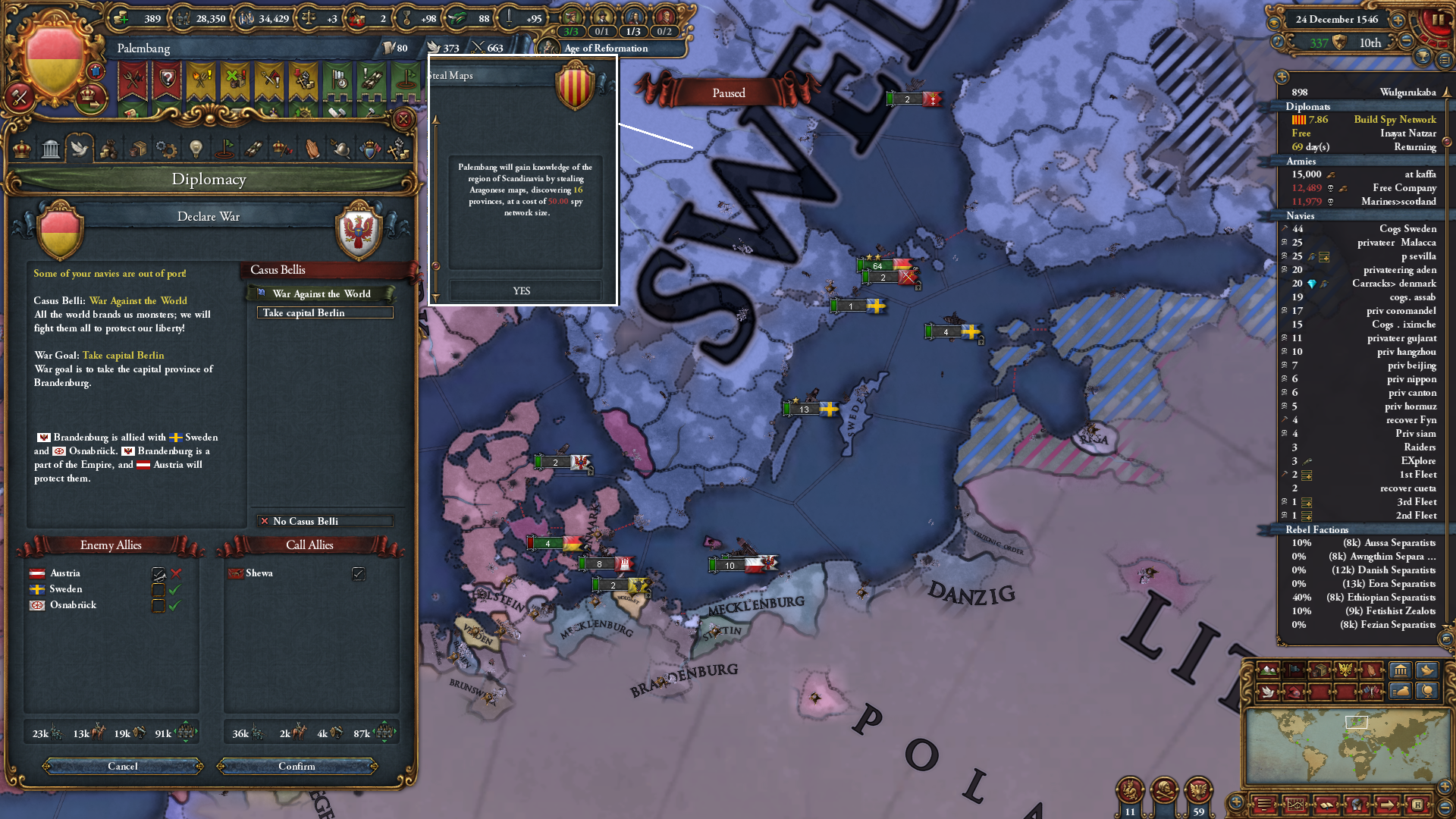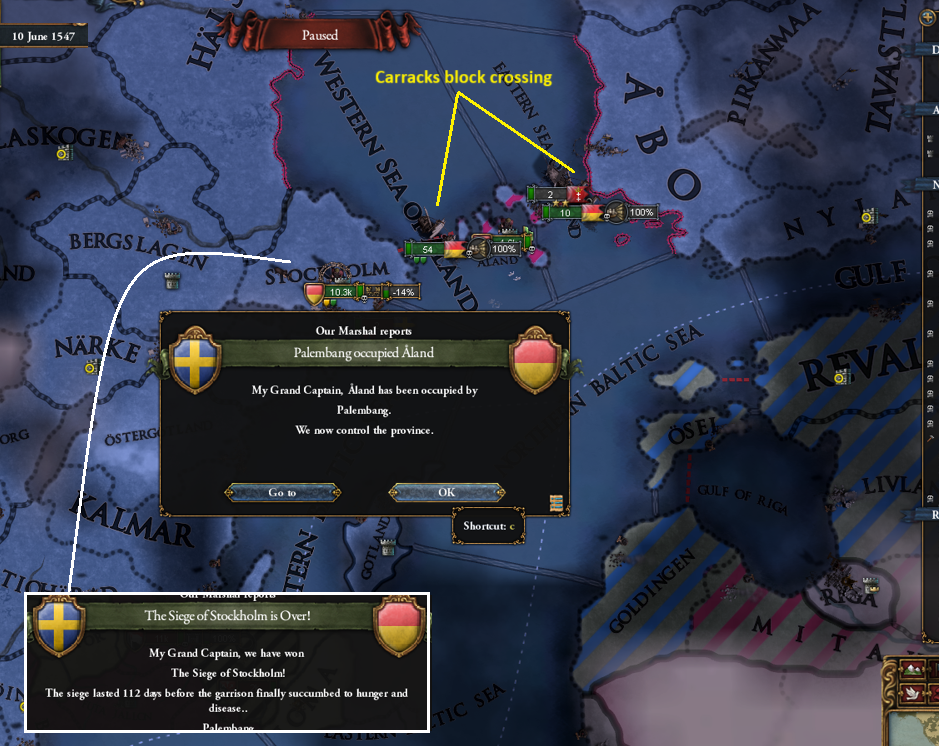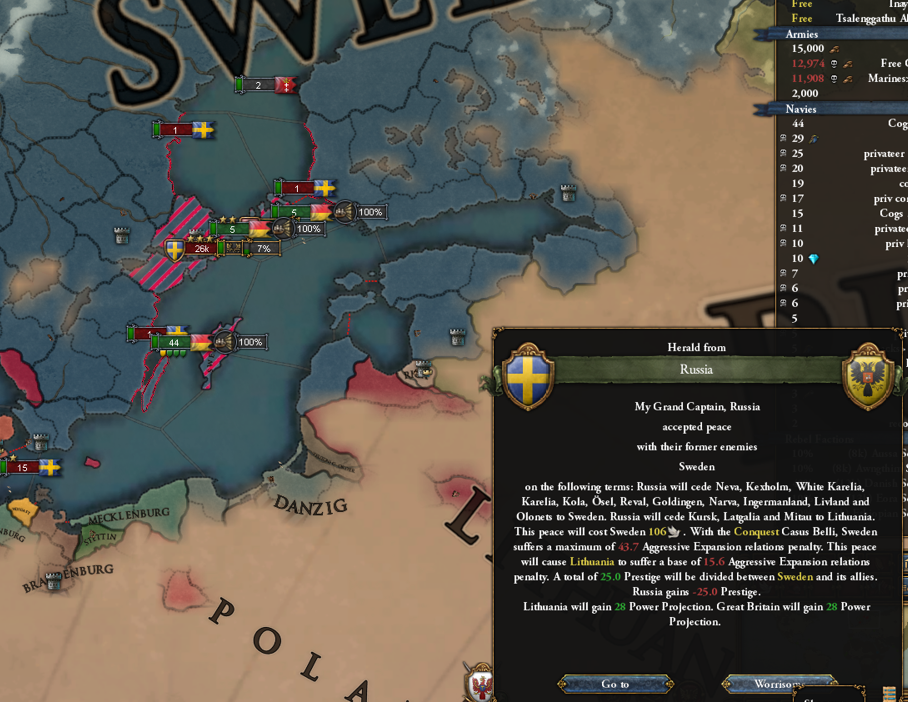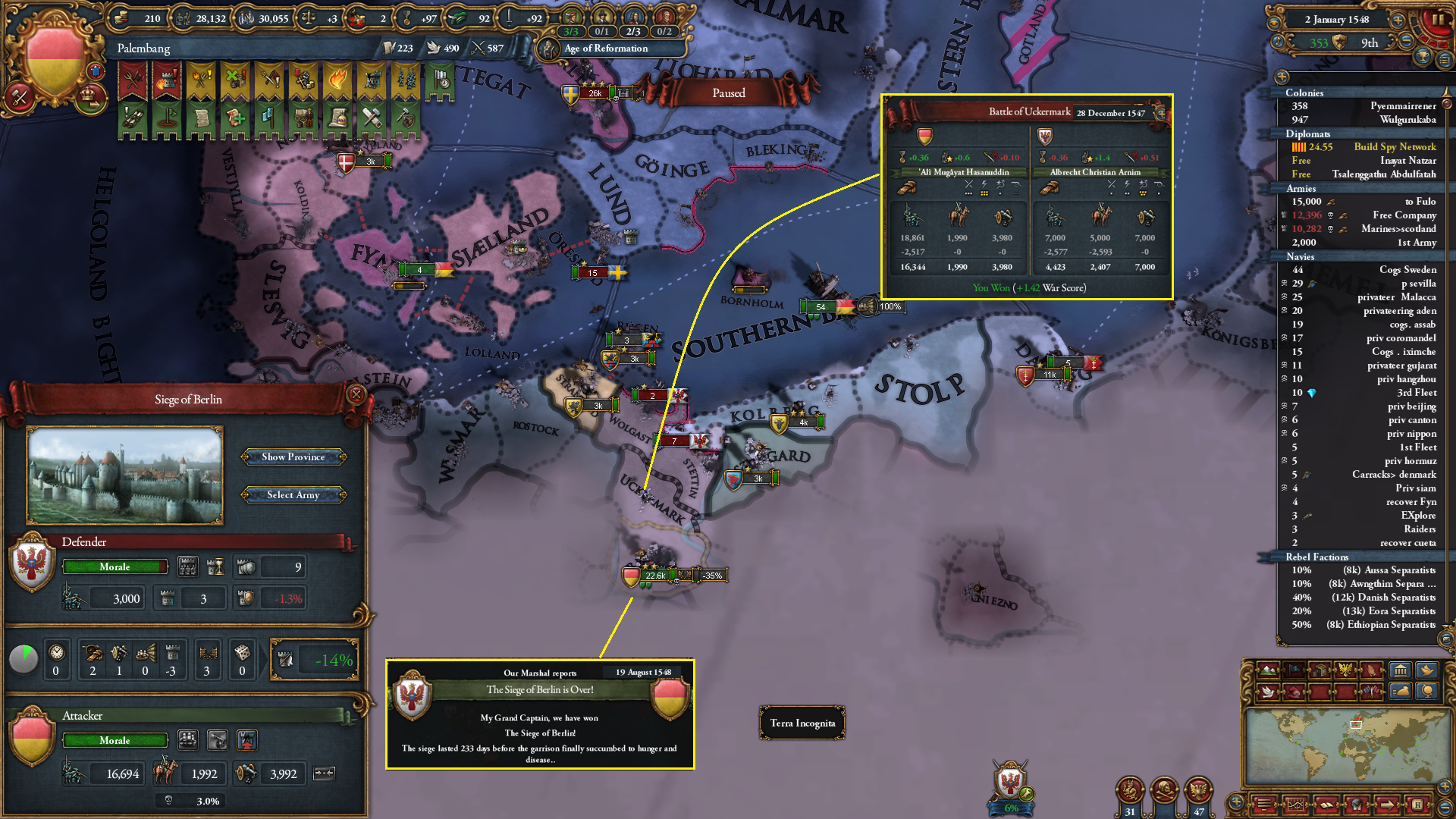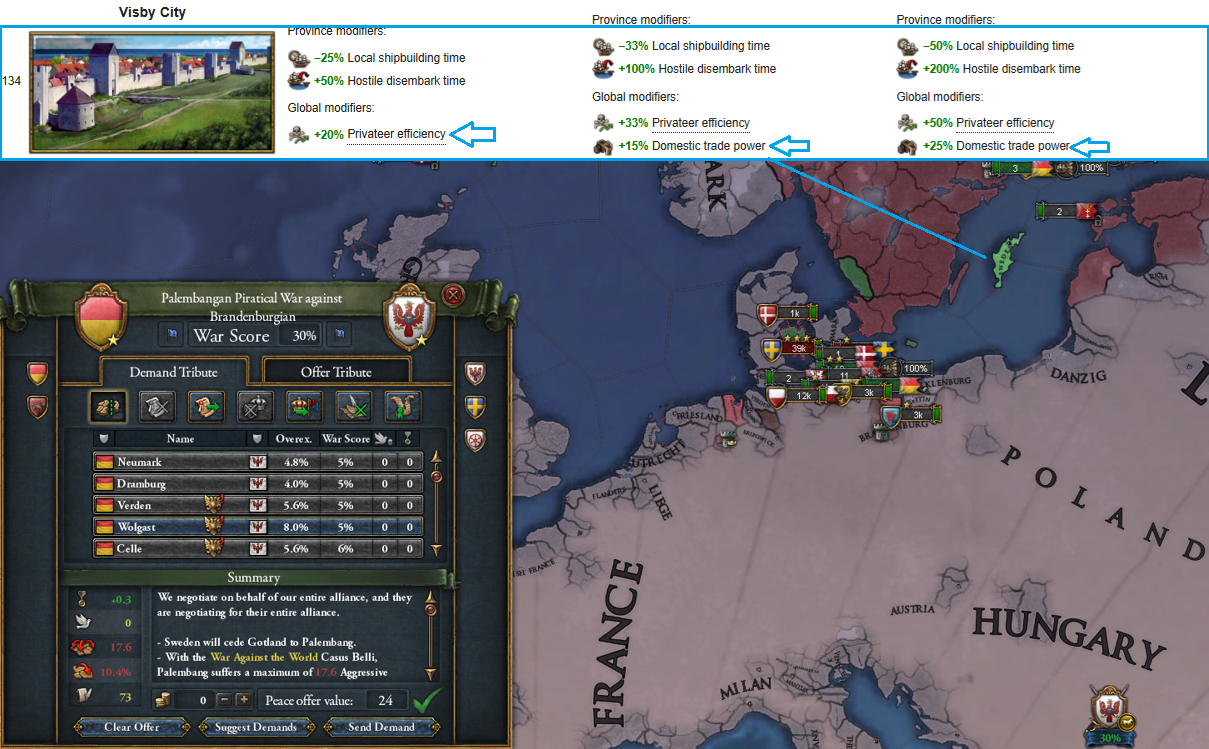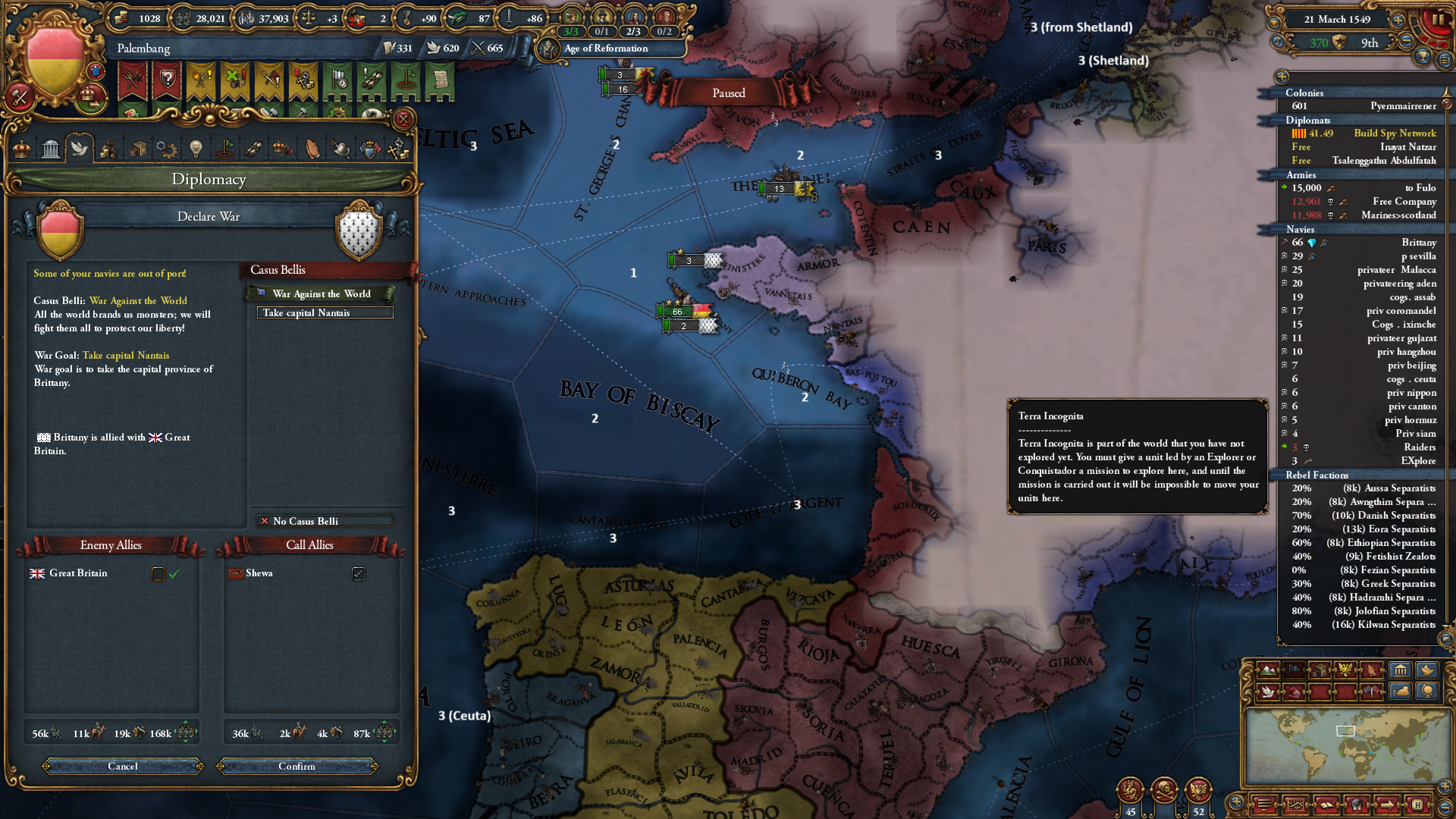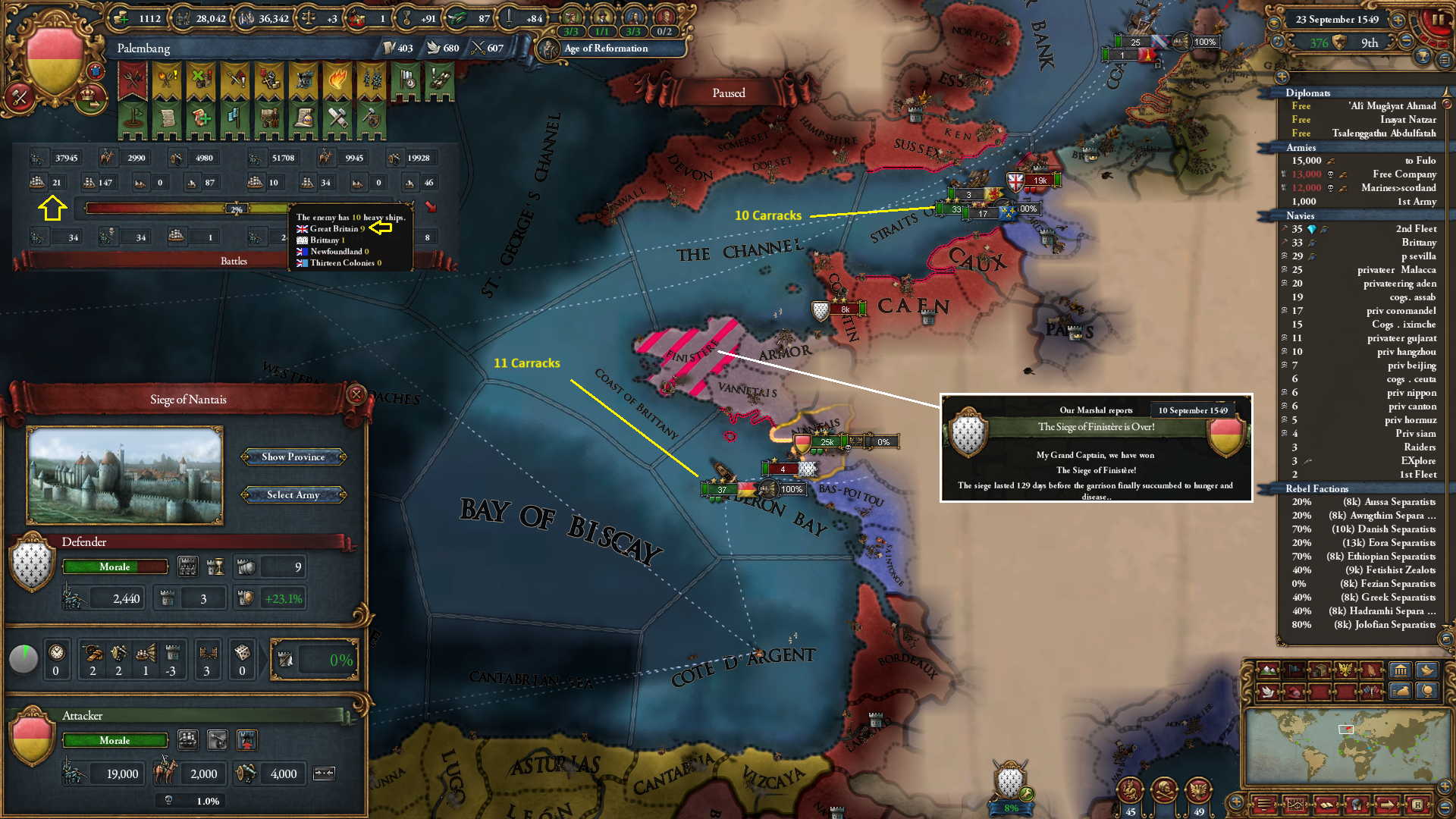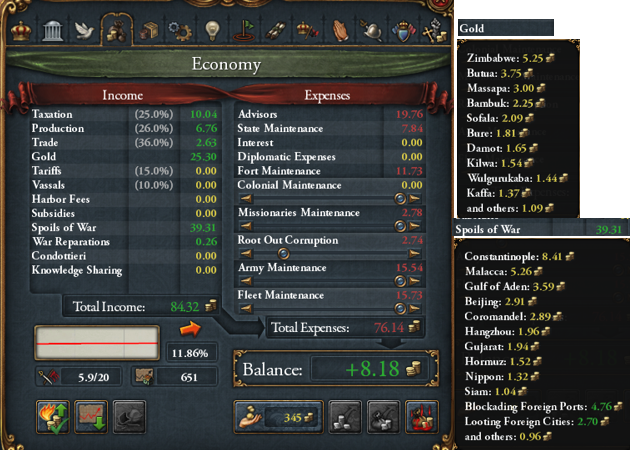Chapter 9: Atlas and Hercules (1530-1540)
The conquests of Benin and Jolof gave Palembang an opening into the northern Atlantic and got her closer to Europe. And she used that to begin establishing a presence on the Atlantic coast of America by attacking Arawak . Grand Captain used the time needed to core and consolidate those gains by addressing some old unfinished business on the other side of Africa. With troops from the Jolof conquest recently returned to the Horn of Africa, he declared war on Ethiopia
Ethiopia was in that perfect scenario of still being a valid rival of Palembang, but actually being very weak. And conveniently, the war goal was the capital which was on the border with Palembang. So this was a war that Palembang conducted without having to call upon mercenary units, using an all-Marine army supplemented by artillery regiments.
After taking Enderta and Lasta forts, the pirate army met up with the Ethiopian force besieging Damot.
The Ethiopians were utterly beaten and chased to Gonder where they were cut down to a man. That effectively ended the war. And since the Grand Captain did not want to fully annex Ethiopia, peace was quickly concluded.
In the peace, Palembang took all the highland provinces of Ethiopia, but left them the flat lands bordering Egypt as a buffer still under Ethiopian control. Immediately that created a path for fully coring the gold provinces of Damot and Kaffa, and also freed up two mores slave provinces.
After that, peace was concluded with Arawak with the annexation of Trinidad to Palembang, making it the first base of pirates in the Caribbean
That base was promptly used to raid the coasts of Hispaniola and Venezuela.
And now with Palembang at peace, the situation in Ethiopia was finalized, with all the newly acquired lands given to Shewa who was promoted to March status.
The plan here was to have Shewa act as a loyal and armed buffer state ( the historical definition of a march) to protect not just the gold mines of Ethiopia, but also the lands taken from Kilwa in Eastern Africa . And protection was needed because just a few months before, the Mamluk Sultanate became the Ottoman subject of Eyalet-i-Misr, putting the Ottoman juggernaut very close to Palembangan borders. And that is why a part of Ethiopia was left alone , to buy Palembang time by giving the Ottomans someone else to attack first.
At that point, some councilors around the Grand Captain urged him to continue attacking in the Horn of Africa and enlarge Shewa at the expense of Adal. But Adal had allies, and the Grand Captain was eager to resume expansion in the Atlantic. And certainly the pirate nation did not have enough resources to expand in two theatres at once, while also putting down rebellions in the sprawling empire. He had to pick Africa or the Atlantic, and he chose the Atlantic.
And expansion in the Atlantic meant conflict with the growing power of Portugal. Therefore Portugal was officially designated as a rival
Then after recruiting the Grand Company mercenary company to put down rebellions in Africa, it was transferred on ships to Trinidad ( disbanding and re-hiring would have cost too much money). In addition, all the artillery and most of the marines were transferred there as well, leaving a small force in Ethiopia on guard duty . After refitting in Trinidad, the whole Armada sailed for Hispaniola, with the target being the Portuguese colonial nation of Caraibas, rather than Portugal herself.
Now because the Alcheringa pirates were based out of a colonial region (Eora being in Australia), they were considered "colonials or natives" by the Portuguese in Lisboa, and therefore Caraibas was on her own in the war, and could not automatically call on the parent nation for defense . And that meant the war was like taking candy from a child , and the pirates faced almost no resistance.
The war was so easy in fact that many wondered why the Grand Captain had sent so many troops to attack . But the overkill was needed to quickly overpower the Caraibans, so as not to give time for Portugal to intervene by sending an "Enforce White Peace" demand. And as soon as the enemy capital was taken and their army destroyed, peace was imposed.
In the peace, Palembang took much needed money ( we always run a deficit, so any spoils of war are welcome). And limited gains to just three provinces: Tortuga and Boriken for sites of what one day would be important monuments to boost the pirate fleets' size and privateering efficiency; and Jamaica to allow raiding of the entire eastern coast of Central America.
After those successes, many expected the Grand Captain to continue the expansion push north towards the Eastern coast of North America and west towards the highlands of Mexico, rich in gold and silver. But events elsewhere made him change priorities.
He had received news that the Ottoman Empire was expanding its foothold in the rich peninsula of Italy . There appeared to be no one capable of stopping them at that point. And it was just a matter of time before they turned their guns on Palembang's holdings in Ethiopia. Palembang had no hope of facing them on land. If Palembang was to help stop them - or at least slow them down - she needed a raiding base inside the Mediterranean . And that meant she needed secure passage through the famed pillars of Hercules. And that, in turn, meant war with the Iberians who controlled them.
And so Grand captain Azmi prepared for war, a war that was going to be much tougher than the easy stomping of Ethiopia and Caraibas. Having fabricated a claim on the Portuguese Cape Verde islands, a much easier war goal than Lisboa, he reassembled the Armada and sent it to the straits of Gibraltar. And from there he issued a declaration of war on Portugal and her allies Castile and Great Britain.
This was a momentous decision for the Grand Captain. He knew history would judge him as either a brave genius, or an incompetent fool , depending on the outcome. For not only was Palembang badly outnumbered in troop numbers on land, she also did not how much she would be outnumbered on sea. Because at that point, he knew from hearsay that Great Britain was a strong naval power, but could not discover her true navy size yet.
And so it was with much internal trepidation that he issued the declaration. And trepidation turned to concern when the true navy sizes became known afterwards.
The balance of forces meant any small mis-step could be fatal for Palembang's war fortunes, and the Grand Captain had to remain focused and near the action [I dropped speed to 2]. But he had a plan, and he put it in action. He had the Marines - without other units that could slow them down - effectuate a quick landing on Ceuta to secure the southern terminus of the straits. And he had the Grand company accompanied by the artillery land directly on Tangiers to besiege its fort as soon as possible.
He was gambling that the Iberians had most of their forces in Iberia, and that North Africa could be conquered by Palembang's smaller force while the fleet blocked the strait. Meanwhile, 2 regiments of marines landed on the unfortified wargoal province of Cape Verde [2 to avoid attrition halting the occupation]
So far things were going well. But of course the big concern was having the British Navy combine with the Portuguese navy to dislodge the pirates from the Straits of Gibraltar. To avoid that , the Grand Captain ordered the marines to take the province of Gharb , where the Portuguese navy has taken refuge. The idea was to eject the Portuguese navy and defeat it before the British arrived on the scene.
But what the Grand Captain did not realize, was that Ceuta was in the zone of control of a Portuguese fort at Fez , itself in terra incognita to Palembang . And the garrison there managed to liberate Ceuta while the marines where busy taking Gharb and forcing the Portuguese fleet out
And so when naval battle was joined, the Strait was unguarded. And to make matters worse, a nearby British Squadron of 3 heavies was spotted as it ran into the Palembang explorer and his 3 Caravels. There was real anxiety that those 3 heavies would join the main battle and tip the battle in the enemy's favor. But luckily the British ships sailed off to Britain and Palembang won a difficult but important victory, with 5 enemy heavy ships captured.
After that it was a hectic few weeks as the marines tried to re-secure Ceuta. But it was too late, as a 20,000 Castilian force managed to cross the Strait .
Things were getting dicey for the pirate expedition. The fleet controlled the Strait, but at any moment the British fleet could show up. And now enemy armies were able to cross from Iberia. But whatever Alcheringa god the Grand Captain prayed for must have been receptive, because Tangiers finally fell after 189 day siege. And now the troops were moved to Ceuta to block the strait ( although because of the fort at Fez, they had to be moved to Ceuta by ship and not land).
That was done just in time to hold the province against an attack by 20,000 Portuguese . And in another lucky break for Palembang, the Castilians in North Africa did not reinforce their Portuguese brethren , but rather tried to retake Tangiers. And they were defeated as well in a later battle.
At that point Palembang had a bridgehead in North Africa, but could not maneuver due to the mountain fort at Fez. So the army was sent to siege it , hoping to take it before an Iberian counterattack. Meanwhile , the looming threat of a British force arriving in North Africa was allayed when 12,000 British accompanied by their fleet were seen landing on Tortuga.
And more luck came Palembang's way when the Fez castle surrendered after just 81 days (and a barrage) [I got it at 14%!].
That gave Palembang much more maneuver room in the Maghreb. But as her armies later discovered, the Atlas mountains were dotted with Castles and two more mountain forts - at Talfilat and Tadla had to be reduced . The fighting was a slog, made more so by France asking the Pope to call for Crusade against Palembang.
But by late 1537, the outcome of the war was no longer in doubt. The Iberians in Morocco were in full retreat and the pirate fleet was in full control of the Strait. So while that fighting raged, several notable events happened.
First, the colony at Galapagos was completed and the colonist was sent to Tlingit on the Pacific Coast of Canada to start a colony with a gold mine. Second, a new government reform pertaining to economic matters was passed. That established back the Burger estate by enabling the Quartermasters
The ability to extract diplomatic power from the Estate [the Mana privilege] was too good to pass . And the Maritime ideas were completed, given Palembang more naval force limits, which were used to expand privateering operations in Asia. New squadrons were sent against Canton, Siam, Hangzho, Nippon and Beijing.
And that also allowed the fleet guarding Gibraltar to repair without having to dock back in .
And in other notable news, the Ottomans continued their gains, establishing the Eyalet-i-Lombardiya in North Italy. And soon after aimed to do the same against Moldavia.
Now back to the war in the Maghreb. After the fall of the last fort at Tafilalt, the Iberian forces were cornered at Saoura and defeated. The remnants were then chased and annihilated.
It was now time for peace. Palembang had no more easy means to improve the situation, with an invasion of Iberia proper being deemed too risky . And the Grand Captain was able to get all the provinces he waned in the peace. Although he could have lengthened the war to gain more money, he saw opportunities to accelerate the push into the Mediterranean, opportunities that were fleeting and may not last. So he took this peace
Palembang took Ceuta to control the southern terminus of the Gibraltar strait. Melilla was taken because it extended the raiding range further east. Fez was taken because of its fort . And Tafilalt was taken for its gold mine and its border with Sus. Because at that time, Sus was allied to Tunis who was just wrecked by Aragon and had almost no army.
And as the decade ended, pirate armies had destroyed the Susian force and put Sus to the siege, and were also besieging Tripoli , the capital of Tunis.
It is only a matter of months at most before Palembang will be able to annex Thubaqt on the Libyan coast. That province will give raiding range to the Aegean sea. And will put Palembang in good position to acquire a province right under the nose of hte Ottomans , in the form of the Green island of Lesbos that was still controlled by a very weak and isolated Genoa
So thanks to an audacious attack on Portugal, and after capturing all the forts in the Atlas , the pirates have crossed the pillars of Hercules and are now getting very close to the City of the World's desire . The days of the Ottomans attacking their neighbor willy nilly without a response may be at an end. Someone will make them pay, and that someone are the pirates.


